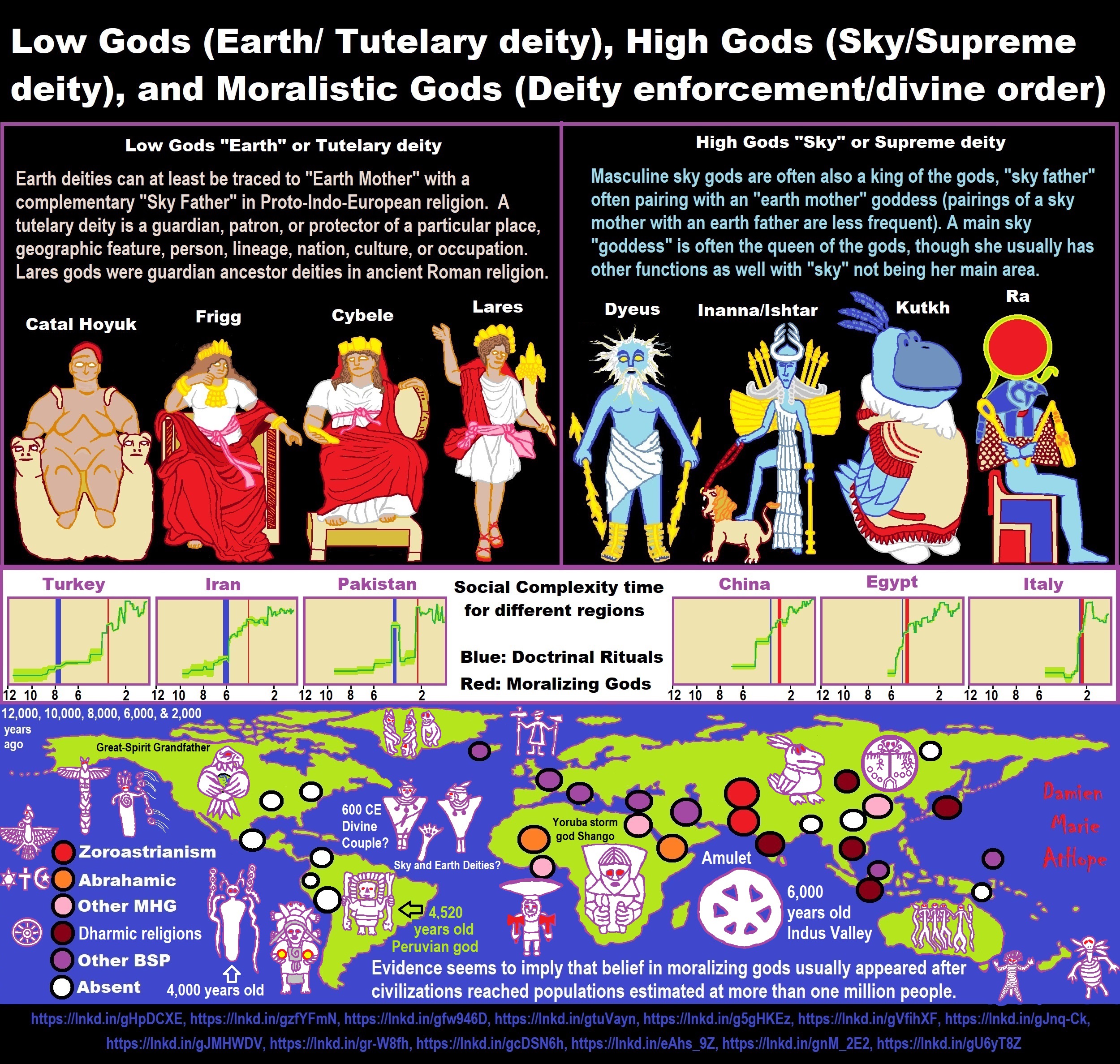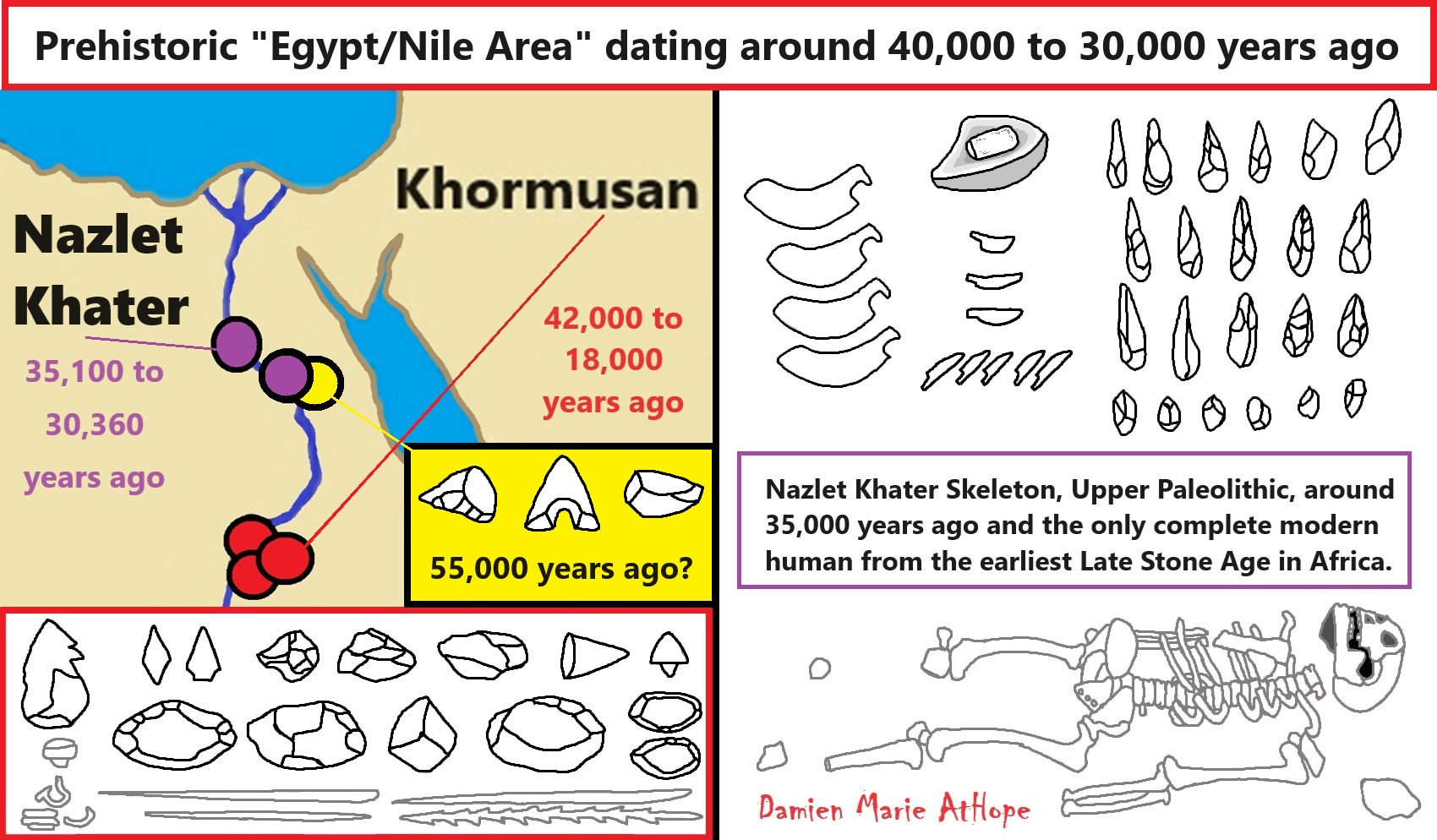
Prehistoric Egypt
Aterian Industry (Aterian tool-making Egypt c. 40,000 BCE)
“Aterian tool-making reached Egypt c. 40,000 BCE. The Aterian is a Middle Stone Age (or Middle Palaeolithic) stone tool industry centered in the Maghreb, but also found in Oman and the Thar Desert. The earliest Aterian dates to c. 145,000 years ago, at the site of Ifri n’Ammar in Morocco. However, most of the early dates cluster around the beginning of the Last Interglacial, around 130,000 years ago, when the environment of North Africa began to ameliorate. The Aterian disappeared around 30,000 years ago and it is currently not thought to have influenced subsequent archaeological cultures in the region.” Ref Ref
“During the Middle Paleolithic Period (around 250,000 to 50,000 years ago) Acheulean hand axes became rare, and were replaced by small flake-tools made using the Levallois Method (striking flakes of stone from a prepared core). Middle Paleolithic tools have been found in the Nile Valley and Nubia, but the best preserved examples come from the Western Desert, in particular Bir Sahara and Bir Tarfawi. Around 90,000 years ago the climate began to change and the Sahara became the arid desert we recognize today. People migrated to the Nile Valley and the oases (such as Kharga). Cultures in this period are referred to as Mousterian, Aterian, and Khormusian with reference to the type of tools they preferred. Some scholars have proposed that these cultures followed each other sequentially. However, radiocarbon dating suggests that they overlapped in time. It is also proposed that they were in fact the same group of people, just using different tools in different situations.” ref
“Tools, such as the stone tipped throwing spear, allowed people to develop their hunting skills and take on much larger prey. As a result, they flourished and left behind large numbers of tools to attest to their abundance. An interesting find from this period (dated to around 55,000 years ago) is the Paleolithic burial of an anatomically modern child at Taramsa, close to Dendera. The environment became more arid around 37,000 years ago. The great oasis at Kharga dried up and the flora and fauna which had sustained the Middle Paleolithic cultures vanished. The Mousterian and Aterian cultures had to leave or die. It is likely that those who survived made their way to the Nile valley where they met the Khormusian peoples (and probably others so far not distinguished). Arguably the most important site from this period is Nazlet Khater, the site of the earliest known underground mining complex in the world (dated to around 37,000 to 31,500 years ago). Several shafts and underground chambers were excavated to reach the chert cobbles from which lithic blades (long slender shards struck off from a prepared core) could be made. Nearby, archaeologists found the second earliest human burial in Egypt, and the earliest known funerary gift (a bifacial axe).” ref
“Upper Paleolithic or Late Paleolithic (around 23,000 to 14,000 years ago) cultures are characterised by the long thin stone blades they commonly employed. The blades are so thin that it is suggested they were used to form harpoons and arrows. These tools represent a refinement of the Khormusian technology which is referred to as Halfan. Between 17,000 and 13,000 years ago Egypt benefited from a wetter and more hospitable climate and the Halfan people flourished alongside three other cultural groups; the Kubbaniyan, the Idfuan, and the Qadan. Archaeological evidence suggests more regional variation and local innovation than in earlier periods, and a greater diversity of subsistence strategies and hunting and gathering practices. The development of the mortar and pestle allowed grains and tubers (some of which were only edible once ground) to form a larger part of their diet.” ref
“The Kubbiyaniyan peoples also employed communal storage facilities implying greater social complexity and an understanding of how (and for how long) they could store produce. “With the end of the last Ice Age around 13,000 to 12,000 years ago, increased rainfall cause the White Nile to flow again. This wetter period saw a series of very high Nile floods referred to as the “Wild Nile”. Qadan burials from this period display the earliest evidence of ancient conflict. Large numbers of the people, who were often buried in communal graves, show signs of violence. Some still have stone shards embedded in their bones. Another important site from the period is the cemetery at Wadi Tushka, north of Abu Simbel. Here a number of burials were marked with the skulls of cattle prefacing the importance of domestic cattle in later C Group and Kerma cultures.” ref
“Two main cultural groups have been found which date to the Epipaleolithic (or final Paleolithic) Period; the Qarunian culture in the Faiyum, and the Elkabian culture in Upper Egypt. The Qarunian people (also designated as Faiyum B) hunted gazelle, hippo, waterfowl, and hartebeest and fished extensively. Evidence of their campsites along the banks of the marshland date to between 6240 and 5480 BCE or around 8,240 to 7,480 years ago. They used small-backed microlithic blades, often formed from chert. When the Faiyum was cut off from the Nile by lower floods (around 7,480 years ago), their culture disappeared and the area was not repopulated for around 300 years. The Elkabian site consists of a lower level of occupation (around 8,400 years ago), a middle level (at 8,040 years ago) and an upper level (at around 7,980 years ago). As well as plentiful evidence of fishing (some of which suggests these may have been seasonal fishing outposts), there is some indication that they used reed boats to fish in deeper waters. Archaeologists also found numerous ostrich shell beads.” ref
Khormusan Industry (Khormusan tool-making Egypt c. 40,000 and 30,000 BCE)
“The Khormusan industry in Egypt began between 40,000 and 30,000 BCE. Khormusans developed advanced tools not only from stone but also from animal bones and hematite. They also developed small arrow heads resembling those of Native Americans, but no bows have been found. The end of the Khormusan industry came around 16,000 BCE with the appearance of other cultures in the region, including the Gemaian. There is clear evidence of lithic technological variability in Middle Paleolithic (MP) assemblages along the Nile valley and in adjacent desert areas. One of the identified variants is the Khormusan, the type-site of which, Site 1017, is located north of the Nile’s Second Cataract. The industry has two distinctive characteristics that set it apart from other MP industries within its vicinity. One is the use of a wide variety of raw materials; the second is an apparent correlation between raw material and technology used, suggesting a cultural aspect to raw material management. Stratigraphically, site 1017 is situated within the Dibeira-Jer formation which represents an aggradation stage of the Nile and contains sediments originating from the Ethiopian Highlands. While it has previously been suggested that the site dates to sometime before 42,500 years ago, the Dibeira-Jer formation can plausibly be correlated with Nile alluvial sediments in northern Sudan recently dated to 83 ± 24 ka (MIS 5a). This stage coincides with the 81,000 years ago age of sapropel S3, indicating higher Nile flow and stronger monsoon rainfall at these times. Other sites which reflect similar raw material variability and technological traditions are the BNS and KHS sites in the Omo Kibish Formation (Ethiopia) dated to ∼100,000 years ago and ∼190,000 years ago respectively. Based on a lithic comparative study conducted, it is suggested that site 1017 can be seen as representing behavioral patterns which are indicative of East African Middle Stone Age (MSA) technology, adding support to the hypothesis that the Nile Valley was an important dispersal route used by modern humans prior to the long cooling and dry trend beginning with the onset of MIS 4. Techo-typological comparison of the assemblages from the Khormusan sites with other Middle Paleolithic sites from Nubia and East Africa is used to assess the possibility of tracing the dispersal of technological traits across the landscape and through time.” Ref Ref
“Khormusan industry was a Paleolithic archeological industry in Nubia dated at 42,000 to 18,000 years ago. The Khormusan industry in Nubia began between 42,000 and 32,000 years ago. Khormusans developed tools not only from stone but also from animal bones and hematite. They also developed small arrow heads resembling those of Native Americans, but no bows have been found. The end of the Khormusan industry came around 18,000 years ago. with the appearance of other cultures in the region, including the Gemaian. It was succeeded by the Halfan culture.” ref
“To make their tools even more efficient, Middle Paleolithic people in various parts of Nubia created tools from different raw materials, including basalt, Nubian sandstone, quartzite, and quartz from the local bedrock and hematite, of variable strength and utility, and also used reed, wood and animal bones: the Khormusan tools, named after a site situated at Khor Mousa, at the Second Cataract. The technology applied to work the various materials also varied, and these ancient craftsmen – or artists in their own technology – set up their quarries only in sites with good quality stone material. That allowed them to produce small sharp bladelets, denticulate tools, and burins – a small engraving and scraping tool, like today’s cutter – worked in the Levallois technique. They used the tools for percussion, cutting, chipping, pecking, scraping, chiseling, grinding, drilling, engraving, and carving. Khormusan tools were also found in several sites around the 3rd Cataract and close to the 2nd Cataract, at Wadi Kubbaniya.” ref
“Based on site 1017 and the characteristics of the Khormusan industry (Marks, 1968b), this industry is evidently different both technologically and typologically from the Nubian Mousterian assemblages on the one hand and the Gemaian industry on the other hand, both found in the same area, while sharing some similarities with eastern African Middle Stone Aage tool assemblages. The Khormusan differs from other Middle Paleolithic sites of Nubia, the Nile Valley and the Western Desert. Flexibility of subsistence strategies can be a major factor in the expansion of the home ranges of human groups, as well as their movement across the landscape. While technology is only one component allowing for this flexibility, it is highly visible in the archaeological record. The technological know-how and repertoires of stone tool production are passed down through cultural transmission. Based on ethnographic analogues, style and form have an important role in creating the variability of archaeological assemblages, and may also act as traditional and cultural constraints.” ref
Nazlet Khater Culture (50,000 to 30,000 years ago?)
“Nazlet Khater Skeleton, Upper Paleolithic, around 35,000 years ago. This specimen is the only complete modern human skeleton from the earliest Late Stone Age in Africa. Nazlet Khater is an archeological site located in Upper Egypt that has yielded evidence of early human culture and anatomically modern specimens dating to approximately thirty to fifty thousand years ago. Excavations at the Nazlet Khater 2 site (Boulder Hill) yielded the remains of two human skeletons. One of the skulls was that of a male subadult. The cranium was generally modern in form, but with a very wide face, and it evinced some archaic traits in the temple and mandible areas. Below the skull, the skeleton was robust, but otherwise, anatomically modern. Morphological analysis of the Nazlet Khater mandible indicates that the specimen was distinct from the examined Late Pleistocene and Holocene North African specimens.” ref, ref
“Researchers found a strong Stone Age Sub-Saharan affinities in the 33,000 year old skeleton from Nazlet Khater, Upper Egypt as the authors noted “The morphometric affinities of the 33,000 year old skeleton from Nazlet Khater, Upper Egypt are examined using multivariate statistical procedures. The results indicate a strong association between some of the sub-Saharan Middle Stone Age (MSA) specimens, and the Nazlet Khater mandible , which are different from modern sub saharan africans. Furthermore, the results suggest that variability between African populations during the Neolithic and Protohistoric periods was more pronounced than the range of variability observed among recent African and Levantine populations.” ref
“The Nazlet Khater 2 skeleton possesses two plesiomorphic features in its mandible, which are not found among coeval, anatomically modern, humans. This suggests that the ancestors of the specimen may have interbred with neighboring late archaic humans. At Nazlet Khater 4 to the southeast, Upper Paleolithic axes, blades, burins, end scrapers, and denticulates were also excavated. The site has been radiocarbon dated to between 30,360 and 35,100 years ago. The similarities between NK2 and Upper Paleolithic European samples may indicate a close relationship between this Nile Valley specimen and European Upper Paleolithic modern humans.” ref
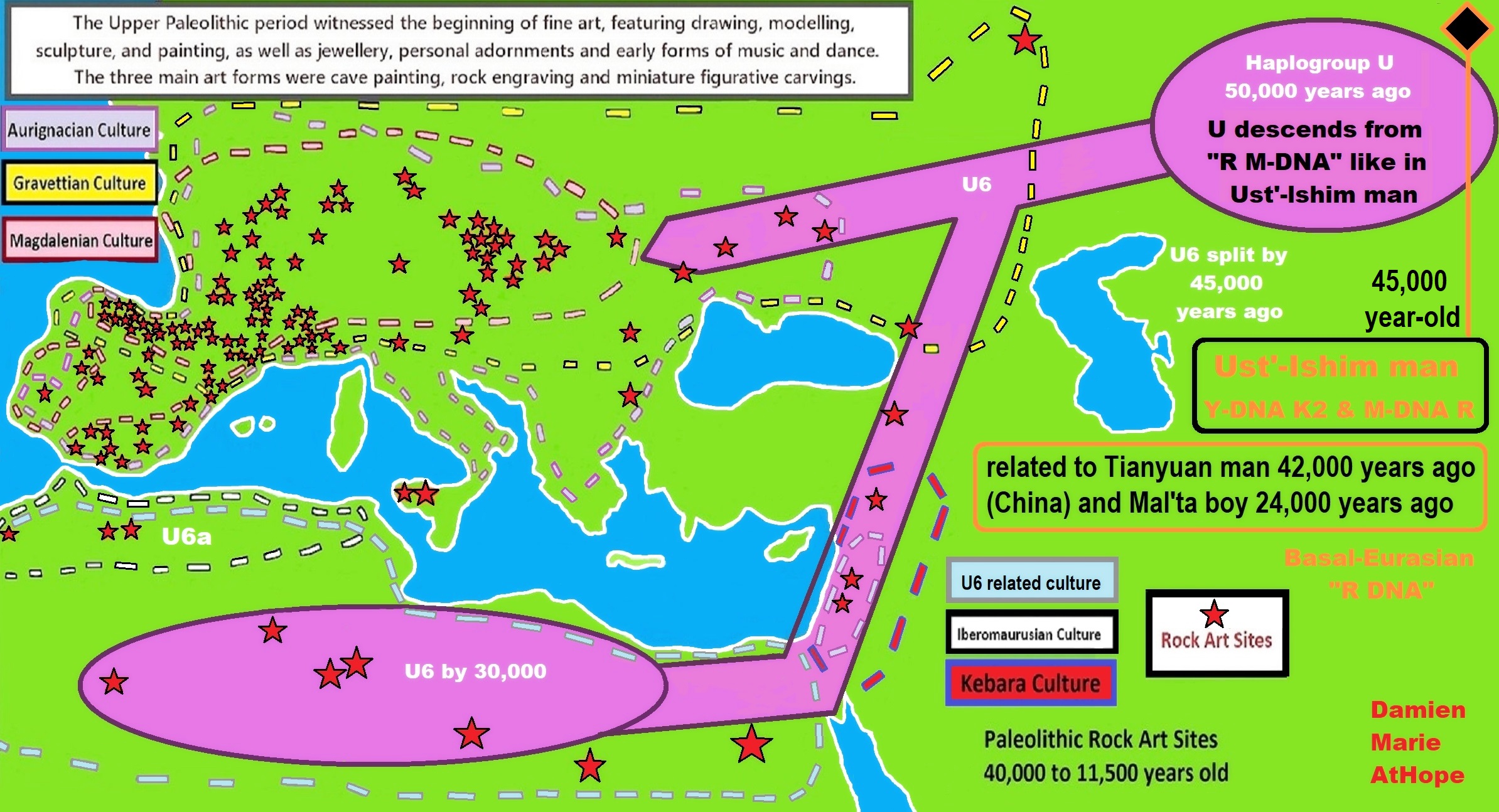
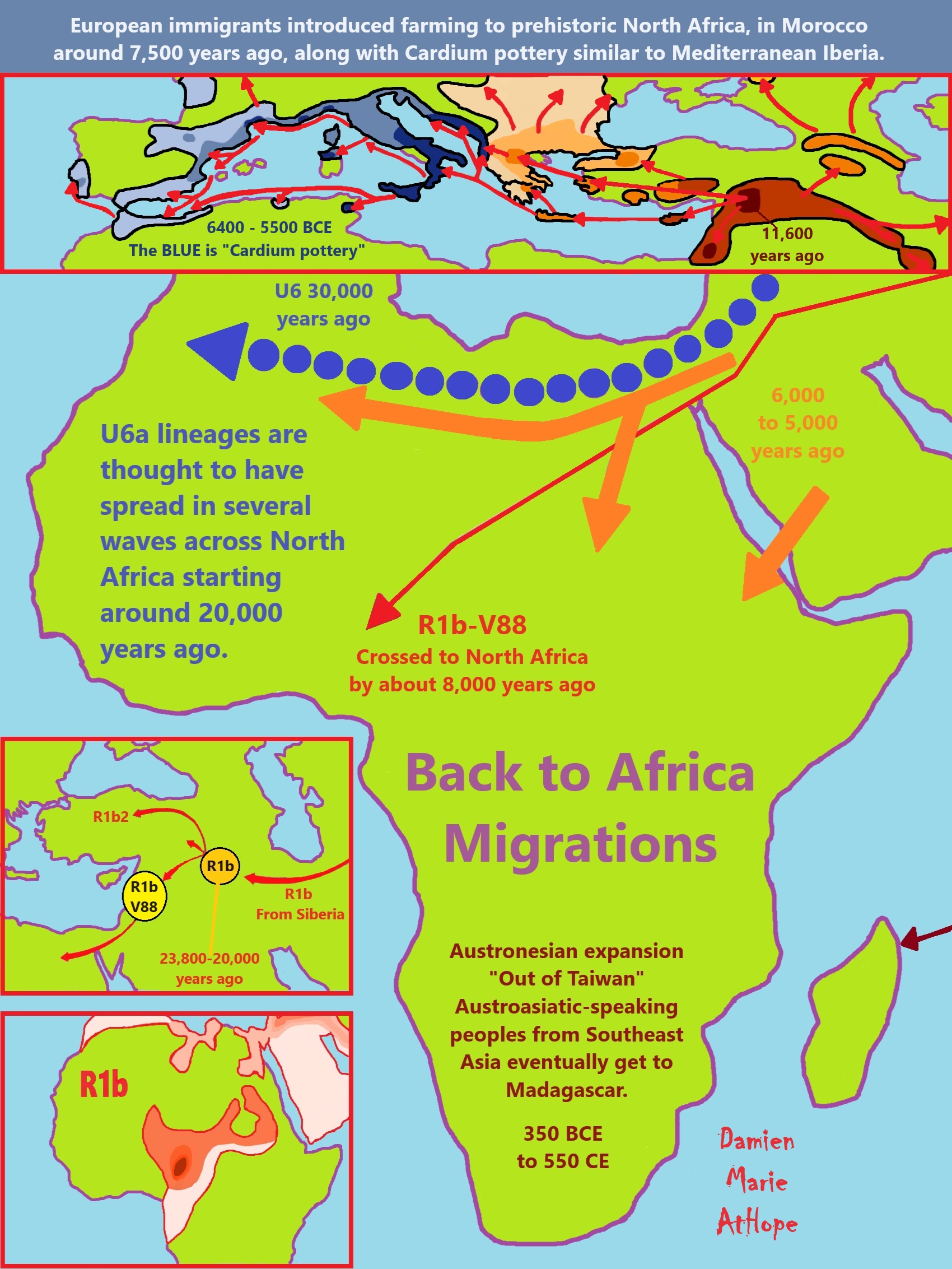
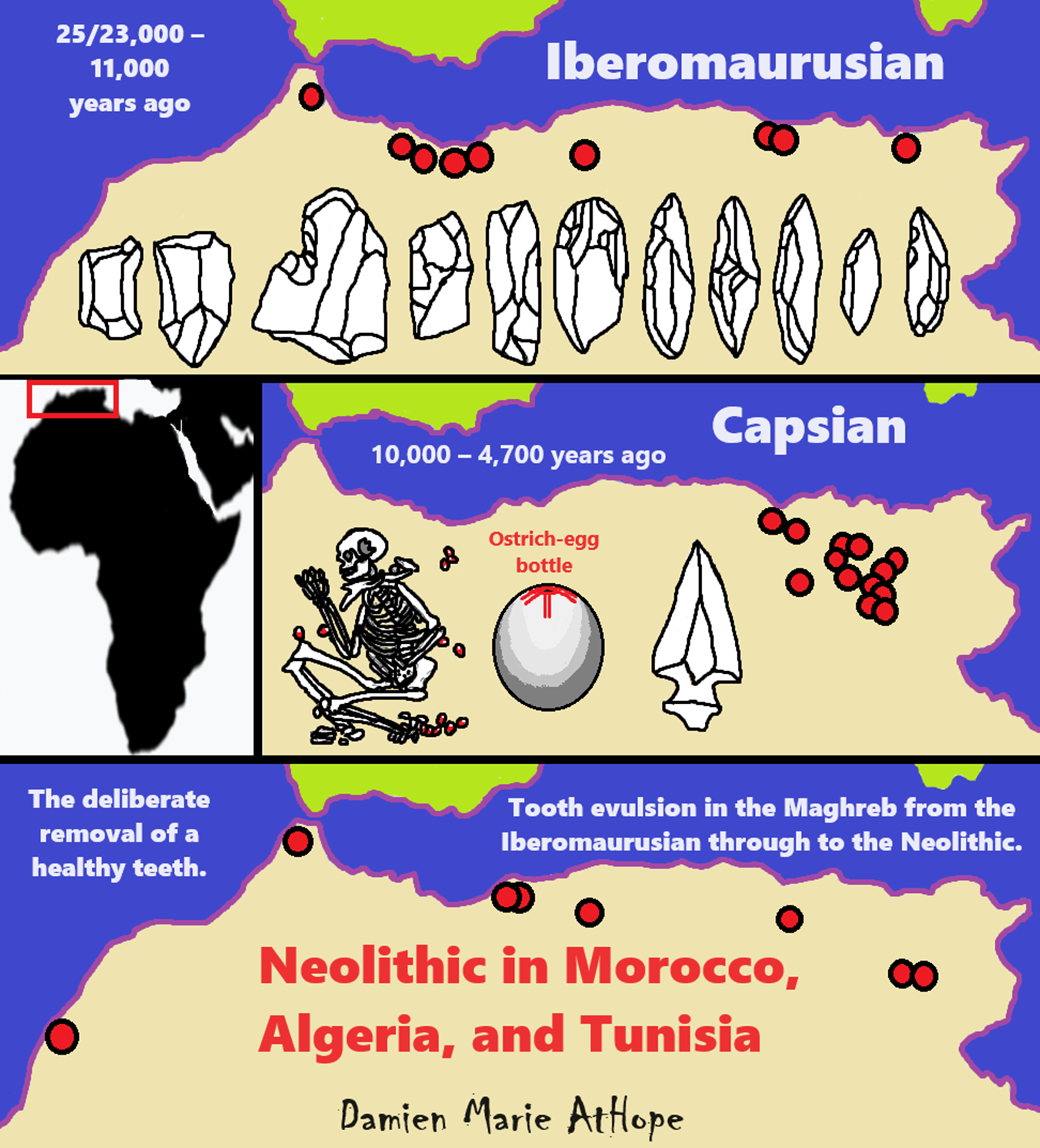
Iberomaurusian Culture
“The Iberomaurusian is a backed bladelet lithic industry found near the coasts of Morocco, Algeria, and Tunisia. It is also known from a single major site in Libya, the Haua Fteah, where the industry is locally known as the Eastern Oranian. The Iberomaurusian seems to have appeared around the time of the Last Glacial Maximum (LGM), somewhere between c. 25,000 and 23,000 years ago. It would have lasted until the early Holocene c. 11,000 years ago. In Algeria, Tunisia, and Libya, but not in Morocco, the industry is succeeded by the Capsian industry, whose origins are unclear. The Capsian is believed either to have spread into North Africa from the Near East, or to have evolved from the Iberomaurusian. In Morocco and Western Algeria, the Iberomaurusian is succeeded by the Cardial culture after a long hiatus.” ref
“The Iberomaurusian is a backed bladelet lithic industry found near the coasts of Morocco, Algeria, and Tunisia. It is also known from a single major site in Libya, the Haua Fteah, where the industry is locally known as the Eastern Oranian. The Iberomaurusian seems to have appeared around the time of the Last Glacial Maximum, somewhere between 25,000 and 23,000 years ago. It would have lasted until the early Holocene c. 11,000 years ago. In Algeria, Tunisia, and Libya, but not in Morocco, the industry is succeeded by the Capsian industry, whose origins are unclear. The Capsian is believed either to have spread into North Africa from the Near East, or to have evolved from the Iberomaurusian. In Morocco and Western Algeria, the Iberomaurusian is succeeded by the Cardial culture after a long hiatus.” ref
“The Mitochondrial DNA of 31 prehistoric skeletons dated from the site of Taforalt, Morocco in a cave called ‘Grotte des pigeons’ was analyzed by the Tunisian geneticist Rym Kefi (Pasteur Institute of Tunis) and her team. The remains at Taforalt Iberomaurusian industry appeared at least 22,093–21,420 years ago and 8 skeletons from the Algerian Iberomaurusian site called ‘Afalou’ site dated from 15,000 to 11,000 years ago.” ref
“23 individuals from Taforalt sample were determined to be of the maternal genetic lineage U6 and of Eurasian haplogroups H, U, R0 and at the Algerian Afalou site maternal groups were JT, J, T, H, R0a1 and U. This suggests genetic flow between North Africa and southern Mediterranean littoral since the Epipaleolithic. In a article entitled ‘Pleistocene North African genomes link Near Eastern and sub-Saharan African human populations’, Marieke Van de Loosdrecht et al. (2018) did a full genome-wide analysis including Y-DNA from seven ancient individuals from the Taforalt site. The fossils were directly dated to between 15,100 and 13,900 calibrated years before present.” ref
“All males at Taforalt belonged to haplogroup E1b1b1a1 (M-78). This haplogroup occurs most frequently in present-day North and East African populations. The closely related E1b1b1b (M-123) haplogroup has been reported for Epipaleolithic Natufians and Pre-Pottery Neolithic Levantines. Loosdrecht states: “Present-day North Africans share a majority of their ancestry with present-day Near Easterners, but not with sub-Saharan Africans” although the predominant Y-DNA of the Maghreb is E-M81 (see Haplogroup E-Z827 ) Maternally, six individuals of the Taforalt remains bore the U6a haplogroup and one individual was of the M1b haplogroup, these haplogroups proposed as markers for autochthonous Maghreb ancestry. A two-way admixture scenario using Natufian and modern sub-Saharan samples (including West Africans and the Tanzanian Hadza) as reference populations inferred that the seven Taforalt individuals are best modeled genetically as of 63.5% West-Eurasian-related and 36.5% sub-Saharan ancestry (with the latter having both West African-like and Hadza-like affinities), with no apparent gene flow from the Epigravettian culture of Paleolithic southern Europe. ” ref
“The Sub-Saharan African DNA in Taforalt individuals has the closest affinity, most of all, to that of modern West Africans (e.g., Yoruba, or Mende). In addition to having similarity with the remnant of a more basal Sub-Saharan African lineage (e.g., a basal West African lineage shared between Yoruba and Mende peoples), the Sub-Saharan African DNA in the Taforalt individuals of the Iberomaurusian culture may be best represented by modern West Africans (e.g., Yoruba). Iosif Lazaridis et al. (2018), as summarized by Rosa Fregel (2021), contested the conclusion of Loosdrecht (2018) and argued instead that the Iberomaurusian population of Upper Paleolithic North Africa, represented by the Taforalt sample, can be better modeled as an admixture between a Dzudzuana-like [West-Eurasian] component and an “Ancient North African” component, “that may represent an even earlier split than the Basal Eurasians.” ref
“Losif Lazaridis et al. (2018) also argued that an Iberomaurusian/Taforalt-like population contributed to the genetic composition of Natufians “and not the other way around”, and that this Iberomaurusian/Taforalt lineage also contributed around 13% ancestry to modern West Africans “rather than Taforalt having ancestry from an unknown Sub-Saharan African source”. Fregel (2021) summarized: “More evidence will be needed to determine the specific origin of the North African Upper Paleolithic populations. Martiniano et al. (2022) later reassigned all the Taforalt samples to haplogroup E-M78 and none to E-L618, the predecessor to EV13. D’Atanasio et al. 2023 found that Iberomaurusian-like ancestry was characterizing for the “ancient Green Saharan” population about 12,000-5,000 years ago, and that modern-day Fula people derive around 30% of their ancestry from this ancient Saharan population, which was “modeled as a sister group of ancient Northern Africans, or alternatively, as an outgroup of all the “Eurasian-ancestry” enriched groups.” ref
“The practice of Tooth Evulsion was widespread in the Maghreb from the Iberomaurusian through to the Neolithic.” ref
Tooth Evulsion
“Tooth ablation (also known as tooth evulsion, dental evulsion and tooth extraction) is the deliberate removal of a person’s healthy teeth, and has been recorded in a variety of ancient and modern societies around the world. This type of dental modification is visually very striking and immediately obvious to other people from the same or different communities. There are numerous reasons for performing tooth ablation, including group identification, ornamentation, and rites of passage such as coming of age, marriage, and mourning. The social meaning of tooth evulsion is likely to remain unknown for ancient populations and may have changed over time within those groups. Dental evulsion can significantly affect the emergence, occlusion, and wear patterns of the remaining teeth.” ref
“There are various techniques used to perform dental evulsion; however, regardless of the technique, dental evulsion could not have been achieved without causing pain and a risk of infection. In Africa, extractive techniques were used. In Sudan, fish hooks and metal wires were used to remove deciduous tooth germs before an infant reached one month. In the Upper Nile, the entire tooth was removed by loosening the anterior teeth from their sockets with an iron spike. The Nuer people of South Sudan still practice an extractive technique whereby a fine blade is used to loosen the teeth alongside the root, which takes place without anesthetic, and the individual is not allowed to show emotion or pain. The evulsion of the lower teeth would have resulted in a highly visible change to the individual’s facial characteristics and would also have affected the pronunciation of language and other sounds.” ref
“Dental evulsion was at one time a common practice in Africa, especially in East and East Central Africa. In West Africa, the custom of extraction is rather uncommon, but it was found among the Ashanti who broke teeth out of their war prisoners, and a few tribes in Cameroon, Ghana, Togo, and Liberia. Dental evulsion also occurred in Angola and Namibia. In Kenya, Tanzania, and South Sudan, dental evulsion is mainly a Nilotic custom. In South Sudan, lower incisors (and sometimes also the canines), are extracted shortly after their eruption, as a rite of passage, for beauty, to allow the emission of specific linguistic sounds, and to facilitate oral sex. This is found among the Dinka, Nuer, and Maban tribes, especially in rural villages. The Luo people extract the six lower teeth as a form of initiation into adulthood. The Maasai people of Kenya extract the lower deciduous incisors of infants at six months, and the lower permanent incisors at six years; this is performed only for boys to facilitate feeding them in case they are ill with tetanus, and to exorcize the kidnapping of babies.” ref
Nile during the Last Glacial Maximum
“Geological cores in the eastern Mediterranean show that sediment input from the Nile during the LGM, while present, is highly reduced compared to previous periods. These data are consistent with a Nile that continued to flow during MIS 2, but possibly only seasonally or during major flood events. Element analyses of core sediments from the eastern Mediterranean confirm a negligible input from the White Nile, vs. an input from the Blue Nile and Atbara, and indicates an increase of Saharan dust input during the Last Glacial Maximum. A recent high-resolution multi-proxy study of a sediment core from the eastern Mediterranean documents the most severe period of aridity in the Nile Basin in the past 28,000 years, after the Last Glacial Maximum, during the second phase of HS 1, 16,000-14,500 years ago (HS 1b).” ref
“From 14,500 years ago, the Mediterranean sea level starts to rise again and several proxies, such as pollen data and lake levels, indicate wetter conditions over at least some areas of eastern Africa, in two phases 14,500 and 11,000 years ago. In particular, the abrupt return of precipitation over eastern Africa 14,500 years ago led to an overflow of Lake Victoria into Lake Albert, the Ugandan headwaters of the White Nile, which triggered high floods in the White Nile Valley as well as at the northern end of the Nile Valley. These data are mirrored by data from the Delta, indicating a marked increase in the sedimentary input of the Blue Nile and Atbara in Delta sediment cores, with evidence for high floods in the Delta ca. 15,000–10,000 years ago. However, millennial-scale episodes of aridity are noted, such as one ca. 13,000-12,000 years ago before a return to humid conditions 12,000 years ago. Maximum Nile flow is documented in the Delta at that time leading to the deposition of an organic-rich dark layer known as Sapropel 1 in the Delta ca. 9,500-7,000 years ago.” ref
“Under present environmental conditions, the Nile Valley acts as a ‘natural’ route between Africa and Eurasia, and is often considered as a corridor for dispersals out of and back into Africa in the past. This review aims to address the role played by the Nile Valley at the end of the Pleistocene (28,000-15,000 years ago) in the context of post-‘Out of Africa’ modern human dispersals. Genetic studies based on both modern and ancient DNA suggest pre-Holocene dispersals ‘back into Africa’ as well as genetic interactions between modern humans across Africa and the Levant. During the Last Glacial, the lowering, or even complete desiccation of major eastern African lakes, including Lake Victoria, reduced the White Nile to a highly seasonal river, depriving the main Nile from its most important tributary in the dry season. This had major consequences, the specifics of which are still debated, on the behavior of the main Nile and the landscape around the Nile Delta. Despite this shift to more arid conditions, there is abundant evidence for human occupation in the main Nile Valley.” ref

Halfan culture (Halfan tool-making Egypt c. 18,000 and 15,000 BCE)
“The Halfan culture flourished along the Nile Valley of Egypt and Nubia between 18,000 and 15,000 BCE, though one Halfan site dates to before 24,000 BCE or around 26,000 years ago. People survived on a diet of large herd animals and the Khormusan tradition of fishing. Greater concentrations of artifacts indicate that they were not bound to seasonal wandering, but settled for longer periods. They are viewed as the parent culture of the Ibero-Maurusian industry, which spread across the Sahara and into Spain. The Halfan culture was derived in turn from the Khormusan, which depended on specialized hunting, fishing, and collecting techniques for survival. The primary material remains of this culture are stone tools, flakes, and a multitude of rock paintings. The Halfan industry is one of the Late Epipalaeolithic industries of the Nile Valley that began to appear by 22,000 years ago. It is one of the earliest known backed-bladelet industries in Eastern Africa, largely dating between 19,000 and 14,000 years ago in Nubia and Egypt. The Halfan was formerly seen as the parent culture of the Ibero-Maurusian industry in the Maghreb, however, since the earliest Ibero-Maurusian is dated to ≥ 21,000 BP it is more likely that both the Halfan and the Ibero-Maurusian are descended from a common cultural ancestor. The Halfan culture is believed to have descended from the Khormusan Culture which depended on specialized hunting, fishing, and collecting techniques for survival. The Halfan people survived on a diet of large herd animals and the Khormusan tradition of fishing. Greater concentrations of artifacts indicate that they were not bound to seasonal wandering, but settled for longer periods at preferred and more convenient sites from where to make short forays into their seasonal ones. The primary material remains of the Halfan culture complex are their stone tools, flakes, and a multitude of rock paintings. The Halfan industry is characterized by three main tools: Halfa flakes, backed microflakes, and backed microblades. It is only during a transitional stage that all three occur in significant amounts, but all types do occur in every assemblage. The most general observation, is the relative proportions of flakes, microblades, and cores chosen for retouch. This reflects both the tools desired in each assemblage (i.e., Halfa flakes vs. backed microblades), and the degree of the development of the microblade technology (i.e., backed flakes vs. backed microblades). The only type which shows a high stage of development is the Halfa core. The basic orientation of the Halfa core to opposed platforms is reflected in the number of poor opposed platform flake cores. These are never extensively utilized, and no real care has gone into their initial preparation. The Haifa core does, however, have a number of features which could lead to more generalized, yet effective, core types. Levallois cores are present, but they are poorly made and have not received the careful attention that the Halfa cores have. In fact, the Levallois flake is merely a more generalized form of Halfa flake and as such could have been of no great value to an industry producing Halfa flakes.” Ref Ref
“The Halfan industry is one of the Late Epipalaeolithic industries of the Upper Nile Valley that seems to have appeared in northern Sudan 22,500-22,000 years ago. It is one of the earliest known backed-bladelet industries in Northern Africa, dating between 22,500 and 16,000 years ago in Nubia. The Halfan is restricted to the north of Sudan, its Egyptian counterpart, which is in all respects similar, is known as the Kubbaniyan. It has been suggested that the Halfan was related to the Iberomaurusian industry in the Maghreb. The earliest Iberomaurusian is dated to c. 26,000-22,500 years ago and it is not clear whether the Iberomaurusian or the Halfan is more ancient. The Halfan is believed to have descended from the Khormusan Culture which depended on specialized hunting, fishing, and collecting techniques for survival.” ref
“The Halfan people survived on a diet of large herd animals and the Khormusan tradition of fishing. Greater concentrations of artifacts indicate that they were not bound to seasonal wandering, but settled for longer periods at preferred and more convenient sites from where to make short forays into their seasonal one. The primary material remains of the Halfan complex are their stone tools, flakes, and a multitude of rock paintings. The Halfan industry is characterized by three main tools: Halfa flakes, backed microflakes, and backed microblades. It is only during a transitional stage that all three occur in significant amounts, but all types do occur in every assemblage.” ref
“The most general observation, is the relative proportions of flakes, microblades, and cores chosen for retouch. This reflects both the tools desired in each assemblage (i.e., Halfa flakes vs. backed microblades), and the degree of the development of the microblade technology (i.e., backed flakes vs. backed microblades). The only type which shows a high stage of development is the Halfa core. The basic orientation of the Halfa core to opposed platforms is reflected in the number of poor opposed platform flake cores. These are never extensively utilized, and no real care has gone into their initial preparation. The Halfa core does, however, have a number of features which could lead to more generalized, yet effective, core types. Levallois cores are present, but they are poorly made and have not received the careful attention that the Halfa cores have. In fact, the Levallois flake is merely a more generalized form of Halfa flake and as such could have been of no great value to an industry producing Halfa flakes.” ref
Sebilian culture (Sebilian tool-making)
Dates: circa 13,000 B.C.E. — 10,000 B.C.E.
Preceded by: Halfan culture
Followed by: Qadan culture
“Sebilian is a pre-historic archaeological culture in Egypt spanning the period c.13,000-10,000 B.C. The culture is known by the name given by Edmond Vignard to finds he located at Kom Ombo on the banks of the river Nile from 1919 continuing into the 1920s. Nine sites were found by A. Marks in the area of the Wadi Halfa; Wendorf located three approximately 10 kilometres from Abu Simbel. The culture is located in entirety only in proximity to the Nile, ranging from Wadi Halfa to Qena. The culture was dated by Vignard as spanning the period c.13,000-10,000 B.C. Dating by way of geology shows the industry to have occurred within a period 15,000 – 10,500 B.C. though the industry has been subsequently re-established sui generis as emerging during 13,000 BC. Later archaeology had identified the Sebilian as having occurred during the same periods of time as those industries named the Silsilian, and the Sebekian of Upper Egypt that occurred 12,000 B.C. or perhaps earlier. Vignard’s analysis of the findings have been criticised, and later re-evaluated by P.E.L. Smith and Fekri Hassan though are considered to have given life to the modern field of investigation into a hitherto unknown (or only surmised) area of pre-history of Egypt. Sebilian implements were located along the Nile River at the 10–15 foot terraces. The formal characteristics of the finds indicate a development of technique that passed through three phases. SEBILIAN I were formally akin to Mousteroid tool-points, using a technique typical of the levallois diorite based industry, with few microburins present archaeologically. SEBILIAN II and III tools were made using a technique indicative of a microblade industry that had changed the production material to flint with a much greater number of microburins found. The industry was re-designated SEBILIAN based on those previously classified type I, and described as crudely produced, possibly resultant of the necessities of the occasional opportunities for groups engaged in hunting activities. The dietary manifestations evidenced were of the sort expected from a semi-sedentary population living near to the Nile river, namely fish, and much less frequently crocodile and turtle.” Ref
Qadan culture (Qadan tool-making)
Dates: 13,000 B.C.E. — 9,000 B.C.E.
Major sites: Cemetery 117
Preceded by: Sebilian
Followed by: Harifian
“The Qadan culture (13,000-9,000 BC) was an ancient culture that, archaeological evidence suggests, originated in Northeast Africa approximately 15,000 years ago, specifically in Upper Egypt (present day south Egypt). This way of life is estimated to have persisted for approximately 4,000 years, and was characterized by hunting, as well as a unique approach to food gathering that incorporated the preparation and consumption of wild grasses and grains. Systematic efforts were made by the Qadan people to water, care for, and harvest local plant life, but grains were not planted in ordered rows. Sites from this period span from the Second Cataract of the Nile to Tushka, situated approximately 250 kilometers upriver from Aswan. In archaeological terms, the Qadan culture is generally viewed as a cluster of Mesolithic Stage communities living in Nubia in the upper Nile Valley prior to 9000 BC. At a time of relatively high water levels in the Nile, it is characterized by a diverse stone tool industry that is taken to represent increasing degrees of specialization and locally differentiated regional groupings. Large numbers of grinding stones and blades have been found with glossy films of silica on them, which could possibly be the result of cutting grass stems on their surfaces. There is some evidence of conflict between the groups, suggesting periods of invasion or intense inter-tribal war. In fact, about 40 percent of individuals buried in the Jebel Sahaba cemetery near the border of Sudan on the Nile river show signs of fatal wounds caused by projectiles, from weapons such as spears, darts, or arrows. The remains found in the cemeteries suggest that ritual burials were practiced. The Qadan economy was based on fishing, hunting, and, as mentioned, the extensive use of wild grain. About twenty archaeological sites in upper Nubia give evidence for the existence of a grain-grinding Mesolithic culture called the Qadan Culture, which practiced wild grain harvesting along the Nile during the beginning of the Sahaba Daru Nile phase, when desiccation in the Sahara caused residents of the Libyan oases to retreat into the Nile valley. Qadan peoples developed sickles and grinding stones to aid in the collecting and processing of these plant foods prior to consumption. However, there are no indications of the use of these tools after around 10,000 BC, when hunter-gatherers replaced them. In Egypt, analyses of pollen found at archaeological sites indicate that the Sebilian culture (also known as the Esna culture) were gathering wheat and barley. Domesticated seeds were not found (modern wheat and barley originated in Asia Minor and Canaan). It has been hypothesized that the sedentary lifestyle used by farmers led to increased warfare, which was detrimental to farming and brought this period to an end.” Ref Ref
“The Qadan culture (13000-9000 BCE) was an ancient culture that, archaeological evidence suggests, originated in Nubia approximately 15,000 years ago. This way of life is estimated to have persisted for approximately 4,000 years, and was characterized by hunting, as well as a unique approach to food gathering that incorporated the preparation and consumption of wild grasses and grains. Systematic efforts were made by the Qadan people to water, care for, and harvest local plant life, but grains were not planted in ordered rows. Sites from this period span from the Second Cataract of the Nile to Tushka, situated approximately 250 kilometers upriver from Aswan. In archaeological terms, the Qadan culture is generally viewed as a cluster of Mesolithic Stage communities living in Nubia in the upper Nile Valley prior to 9000 BCE or around 11,000 years ago.” ref
“At a time of relatively high water levels in the Nile, it is characterized by a diverse stone tool industry that is taken to represent increasing degrees of specialization and locally differentiated regional groupings. Large numbers of grinding stones and blades have been found with glossy films of silica on them, which could possibly be the result of cutting grass stems on their surfaces. There is some evidence of conflict between the groups, suggesting periods of invasion or intense inter-tribal war. In fact, about 40 percent of individuals buried in the Jebel Sahaba cemetery near the border of Sudan on the Nile river show signs of fatal wounds caused by projectiles, from weapons such as spears, darts, or arrows. The remains found in the cemeteries suggest that ritual burials were practiced. The Qadan economy was based on fishing, hunting, and, as mentioned, the extensive use of wild grain.” ref
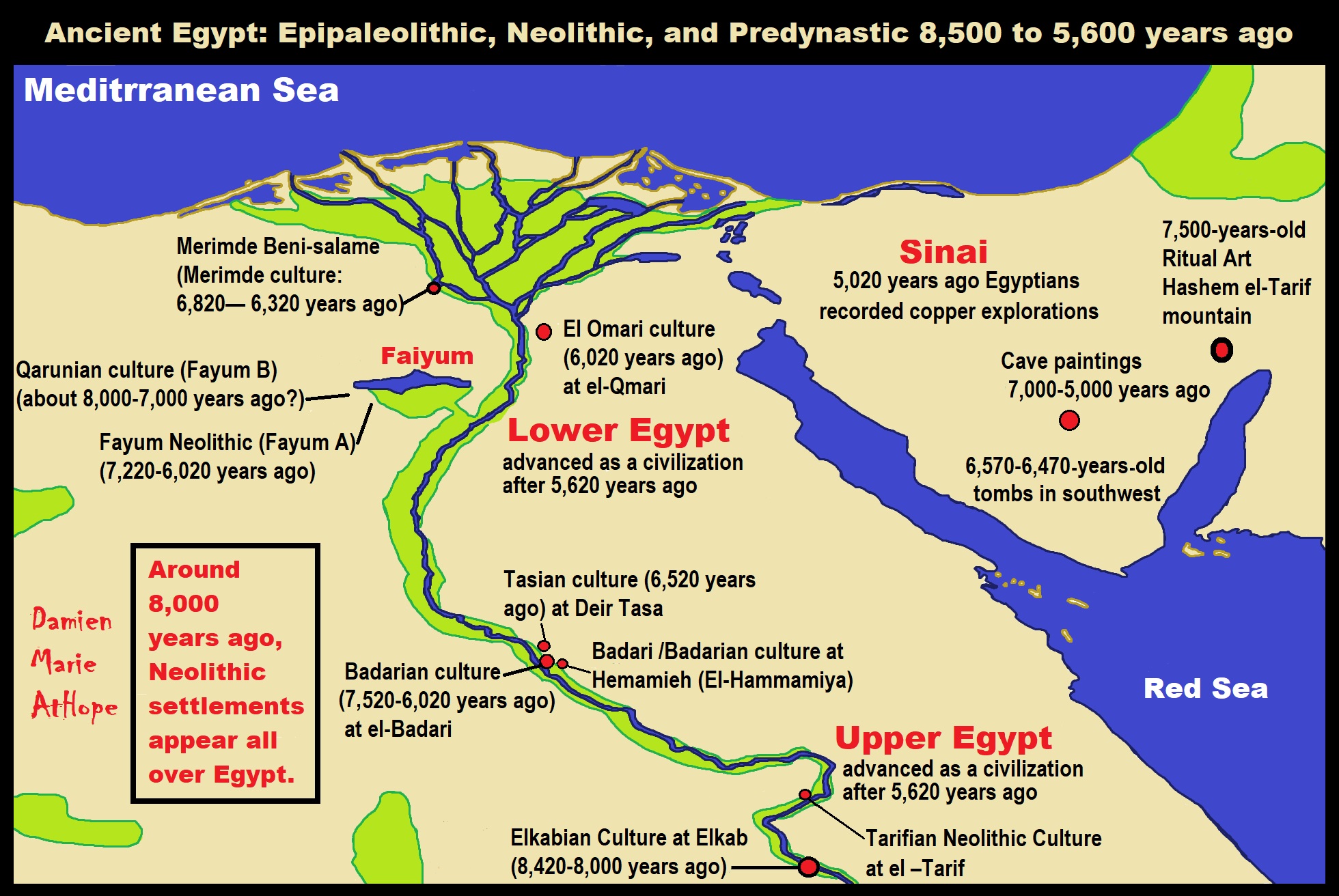
“Harifian culture (Harifian tool-making)
Dates: 8,800 — 8,000 B.C.E.
Major sites: Negev Desert
Preceded by: Qadan culture
Followed by: Faiyum A
“The Harifians are viewed as migrating out of the Fayyum and the Eastern Deserts of Egypt during the late Mesolithic to merge with the Pre-Pottery Neolithic B (PPNB) culture, whose tool assemblage resembles that of the Harifian. This assimilation led to the Circum-Arabian Nomadic Pastoral Complex, a group of cultures that invented nomadic pastoralism, and may have been the original culture which spread Proto-Semitic languages throughout Mesopotamia. The Harifian is a specialized regional cultural development of the Epipalaeolithic of the Negev Desert. It corresponds to the latest stages of the Natufian culture. Like the Natufian, it is characterized by semi-subterranean houses. These are often more elaborate than those found at Natufian sites. For the first-time arrowheads are found among the stone tool kit. Andy Burns states “The Harifian dates to between approximately 10,800/10,500bp and 10,000/10,200bp. It is restricted to the Sinai and Negev, and is probably broadly contemporary with the Late Natufian or Pre-Pottery Neolithic A. Microlithic points are a characteristic feature of the industry, with the Harif point being both new and particularly diagnostic – Bar-Yosef (1998) suggests that it is an indication of improved hunting techniques. Lunates, isosceles and other triangular forms were backed with retouch, and some Helwan lunates are found. This industry contrasts with the Desert Natufian which did not have the roughly triangular points in its assemblage. There are two main groups within the Harifian. One group consists of ephemeral base camps in the north of Sinai and western Negev, where stone points comprise up to 88% of all microliths, accompanied by only a few lunates and triangles. The other group consists of base camps and smaller campsites in the Negev and features a greater number of lunates and triangles than points. These sites probably represent functional rather than chronological differences. The presence of Khiam points in some sites indicates that there was communication with other areas in the Levant at this time.” Harifian has close connections with the late Mesolithic cultures of Fayyum and the Eastern Deserts of Egypt, whose tool assemblage resembles that of the Harifian. Fusion with animal domestication elements of the Pre-Pottery Neolithic B (PPNB) culture is hypothesised by Juris Zarins, to have led to the Circum Arabian Nomadic Pastoral Complex, a group of cultures that invented nomadic pastoralism, and may have been the original culture which spread Proto-Semitic languages throughout the region.” Ref Ref
Faiyum A (also called Fayum Neolithic) culture (Fayum tool-making)
Dates: 5,500 — 4,000 B.C.E.
Major sites: Faiyum
Preceded by: Sebilian
Followed by: Harifian
“There is a gap of around 1,000 years between the Epipaleolithi settlements (of the Faiyum B or Quarian culture) in the Faiyum and the establishment of earliest Neolithic settlements, at around 5500 BC. These early sites constitute the earliest fully Neolithic Culture in the Nile Valley. Like the people of the Western Desert the Neolithic peoples of the Faiyum do not seem to have been fully sedentary (although granaries and hearths seem to have been more permanent). They had seasonal camps composed of mat or reed huts with communal underground granaries to exploit the resources of the area. The most obvious difference between the two cultures is the domestication of sheep and goats, and the farming of emmer wheat and six row barley. Unlike other Neolithic cultures in the Nile Valley the Faiyum A culture never developed permanent agricultural villages, the only permanent features are hearths and granaries. The Faiyum was to some degree cut off from the Nile Valley cultures and lagged behind them in social and cultural development. They used sickle flints set in wooden handles, large thick flaked tools, and winged arrowheads and leaf-shaped pieces. Pottery did not develop beyond fairly crude open pots made with chaff tempered clay, but there is evidence of linen woven from flax and imported beads and shells being used as adornments. Wendorf and others have suggested, on the basis of differences in technology, pottery and tool use, that the Faiyum A culture did not derive from any local Paleolithic culture. Rather, the culture was formed by a group of settlers who may also have brought with them the prototype of the ancient Egyptian language. These settlers may have come from the Levant, they share some similar tools and domesticated the same animals. However, others (Hoffman, Hendrickx and Vermeersch) still consider the Faiyum A culture emerged from the peoples of the Saharan Neolithic culture with whom they also share many similarities. The evidence to date is not sufficient to confirm this issue one way or another. Faiyum or El Faiyūm is a city in Middle Egypt. Located 100 kilometres (62 miles) southwest of Cairo, in the Faiyum Oasis, it is the capital of the modern Faiyum Governorate. Originally called Shedet in Ancient Egypt, the Greeks called it Crocodilopolis or Krocodilopolis, the Romans Arsinoë. It is one of Egypt’s oldest cities due to its strategic location. Archaeological evidence has found occupations around the Fayum dating back to at least the Epipalaeolithic period (generally dated from 20,000 BP to about 10,500 BP). Epipalaeolithic hunter-gatherers, generally nomadic, made relatively advanced tools from small flint or obsidian blades, known as microliths. that were hafted in wooden implements. Around 5500–4500 BCE In the Middle and Lower Egyptian Nile Valley farming and herding were just beginning to be established. And therefore, nearly at the same time, when the Middle European landscape was transformed by the Linear Pottery Culture. Since the Neolithic transition had occurred much earlier in southwest Asia, it seems strange that the Neolithic economy appeared so much later in Egypt. For an explanation of this fact, several factors could be of importance: The Sinai Peninsula, too dry for farming, provided an effective barrier for the flow of farming technology between the southern Levant. And Egypt. None of the species of wild plants or animals that later became domesticated, with the possible exception of cattle, were present in Egypt at the end of the Pleistocene. During the early Holocene, the Nile Valley was extremely rich of natural resources, with no further need to supplement this subsistence with farming and herding. Much information about the final Epipaleolithic and early Neolithic transition in the Nil-valley is buried under thick sediments especially if such settlements were located next to the river. Most sites of the Fayum Neolithic (also called Fayum A) were found at the northern rim of the Fayum, first excavated by Caton-Thompson andGardner (1924-1926). While these sites show evidence of domesticated cereals, sheep and goat, there is no evidence of permanent houses or villages. Therefore many researchers have suggested that the inhabitants of Fayum were nomadic hunters and fishers that used only parts of the “Neolithic package” in addition to their original lifestyle. In this respect the Fayum people may be compared with the Ertebølle people 4000 km away at the Shores of the Baltic Sea(http://www.aggsbach.de/2010/09/the-erteb%c3%b8lle-lifestyle/) . Noriyuki Shirai from the Leiden University argued, that the timing of the advent of farming in the Fayum can be estimated by the presence of peculiar sickle blades during the early Neolithic of this area. Neolithic sickle blades at Fayum and in Lower Egypt are bifacially-retouched and deeply serrated on their working edge. Such sickle blades are known from early Levantine Pottery Neolithic sites (the Yarmukian, and Lodian [Jericho IX]), dated to the early 6th millennium cal. BC. It seems reasonable to consider that specific Neolithic techniques were accepted in Lower Egypt not earlier than during the early 6th millennium cal. BC. This process was possibly triggered by a climatic and environmental change around 6200 cal. BC, that finally lead to the desiccation of the southern Levant, Negev and Sinai and to changes of the rain regime in these areas and in Lower Egypt. These changes enabled for the first time during the Holocene winter crops like Levantine wheat and barley to thrive Northern Egypt. The people of Fayum adopted farming and herding into their lifestyle, but without abandon their major subsistence forms of hunting and fishing for the next millennium. The thesis of Noriyuki Shirai “The archaeology of the first farmer-herders in Egypt : new insights into the Fayum Epipalaeolithic and Neolithic” can be download at: https://openaccess.leidenuniv.nl/handle/1887/15339 Continued expansion of the desert forced the early ancestors of the Egyptians to settle around the Nile more permanently and adopt a more sedentary lifestyle. The period from 9000 to 6000 BC has left very little in the way of archaeological evidence. Around 6000 BC, Neolithic settlements appear all over Egypt. Studies based on morphological, genetic, and archaeological data have attributed these settlements to migrants from the Fertile Crescent in the Near East returning during the Egyptian and North African Neolithic, bringing agriculture to the region. However, other regions in Africa independently developed agriculture at about the same time: the Ethiopian highlands, the Sahel, and West Africa. Some morphological and post-cranial data has linked the earliest farming populations at Fayum, Merimde, and El-Badari, to Near Eastern populations. However, the archaeological data also suggests that Near Eastern domesticates were incorporated into a pre-existing foraging strategy and only slowly developed into a full-blown lifestyle, contrary to what would be expected from settler colonists from the Near East. Finally, the names for the Near Eastern domesticates imported into Egypt were not Sumerian or Proto-Semitic loan words, which further diminishes the likelihood of a mass immigrant colonization of lower Egypt during the transition to agriculture. Weaving is evidenced for the first time during the Faiyum A Period. People of this period, unlike later Egyptians, buried their dead very close to, and sometimes inside, their settlements. Although archaeological sites reveal very little about this time, an examination of the many Egyptian words for “city” provide a hypothetical list of reasons why the Egyptians settled. In Upper Egypt, terminology indicates trade, protection of livestock, high ground for flood refuge, and sacred sites for deities.” Ref Ref Ref Ref
*8.2 kiloyear event (Climatic Event 5,200 BCE or 8,200 years ago)
“The 8.2 kiloyear event is the term that climatologists have adopted for a sudden decrease in global temperatures that occurred approximately 8,200 years before the present, or c. 6,200 BCE, and which lasted for the next two to four centuries. Milder than the Younger Dryas cold spell that preceded it, but more severe than the Little Ice Age that would follow, the 8.2 kiloyear cooling was a significant exception to general trends of the Holocene climatic optimum. During the event, atmospheric methane concentration decreased by 80 ppb or an emission reduction of 15%, by cooling and drying at a hemispheric scale. A rapid cooling around 6200 BCE was first identified by Swiss botanist Heinrich Zoller in 1960, who named the event Misox oscillation (for the Val Mesolcina). It is also known as Finse event in Norway. Bond et al. argued that the origin of the 8.2 kiloyear event is linked to a 1,500-year climate cycle; it correlates with Bond event 5. The strongest evidence for the event comes from the North Atlantic region; the disruption in climate shows clearly in Greenland ice cores and in sedimentary and other records of the temperate and tropical North Atlantic. It is less evident in ice cores from Antarctica and in South American indices. The effects of the cold snap were global, however, most notably in changes in sea level during the relevant era. The 8.2 kiloyear cooling event may have been caused by a large meltwater pulse from the final collapse of the Laurentide ice sheet of northeastern North America, most likely when the glacial lakes Ojibway and Agassiz suddenly drained into the North Atlantic Ocean. The same type of action produced the Missoula floods that created the Channeled scablands of the Columbia River basin. The melt-water pulse may have affected the North Atlantic thermohaline circulation, reducing northward heat transport in the Atlantic and causing significant circum-North Atlantic cooling. Estimates of the cooling vary and depend somewhat on the interpretation of the proxy data, but drops of around 1 to 5 °C (1.8 to 9.0 °F) have been reported. In Greenland, the event started at 8175 BP, and the cooling was 3.3 °C (decadal average) in less than 20 years, and the coldest period lasted for about 60 years, and the total duration was about 150 years. The melt-water causation theory is, however, thrown in to speculation due to inconstancies with its onset and an unknown region of impact. Researchers suggest the discharge was probably superimposed upon a longer episode of cooler climate lasting up to 600 years, and merely one contributing factor the event as a whole. Further afield, some tropical records report a 3 °C (5.4 °F) cooling from cores drilled into an ancient coral reef in Indonesia. The event also caused a global CO2 decline of ~25 ppm over ~300 years. However, dating and interpretation other tropical sites are more ambiguous than the North Atlantic sites. In addition, climate modeling work shows that not only the amount of meltwater, but also the pathway of meltwater is important in perturbing the North Atlantic thermohaline circulation. Drier conditions were notable in North Africa while East Africa suffered five centuries of general drought. In West Asia and especially Mesopotamia, the 8.2 kiloyear event was a 300-year aridification and cooling episode, which may have provided the natural force for Mesopotamian irrigation agriculture and surplus production that were essential for the earliest class-formation and urban life. However, multi-centennial changes around the same period are difficult to link specifically to the approximately 100-year abrupt event as recorded most clearly in the Greenland ice cores. The initial meltwater pulse caused between 0.5 and 4 m (1 ft 8 in and 13 ft 1 in) of sea-level rise. Based on estimates of lake volume and decaying ice cap size, values of 0.4–1.2 m (1 ft 4 in–3 ft 11 in) circulate. Based on sea-level data from the Mississippi Delta, the very final stage of the Lake Agassiz–Ojibway (LAO) drainage occurred at 8.18 to 8.31 ka and ranges from 0.8 to 2.2 m. The sea-level data from the Rhine–Meuse Delta indicate a 2–4 m (6 ft 7 in–13 ft 1 in) of near-instantaneous rise at 8.54–8.2 ka, in addition to ‘normal’ post-glacial sea-level rise. Meltwater pulse sea-level rise was experienced fully at great distance from the release area. Gravity and rebound effects associated with the shifting of water masses meant that the sea-level fingerprint was smaller in areas closer to the Hudson Bay. The Mississippi delta records ~20%, NW Europe records ~70% and Asia records ~105% of the global averaged amount. The cooling of the 8.2 kiloyear event was a temporary feature; the sea-level rise of the meltwater pulse was permanent. In 2003, the Office of Net Assessment at the United States Department of Defense was commissioned to produce a study on the likely and potential effects of a modern climate change. The study, conducted under ONA head Andrew Marshall, modeled its prospective climate change on the 8.2 kiloyear event, precisely because it was the middle alternative between the Younger Dryas and the Little Ice Age.” Ref
Merimde culture (Merimde tool-making)
Dates: 4,800 — 4,200 B.C.E. (6,800 – 6,300 years ago)
Preceded by: Faiyum A culture
Followed by: Amratian culture
“The Merimde culture (also Merimde Beni-Salame or Benisalam) was a Neolithic culture in the West Nile Delta in Lower Egypt, which corresponds in its later phase to the Faiyum A culture and the Badari culture in Predynastic Egypt. It is estimated that the culture evolved between 4800 and 4300 BC. Merimde also refers to the archaeological site of the same name. The culture was concentrated around the main settlement site of 25 hectares in the West delta of the Nile in Lower Egypt 45 km northwest of Cairo. The site was discovered by German archaeologist and former Roman Catholic priest Hermann Junker, who excavated 6,400 m² of the site during his West Nile Delta expedition in 1928. The expedition was financed by Albert Rothbart from New York City for the account of the Vienna Academy. Later excavations in the 1970s performed by the Egyptian Antiquities Organization and the German Institute of Archaeology led to the establishment of the stratigraphical sequence. Characteristics, Merimde shows a sequence of occupations which lasted almost a millennium according to some estimates. While Junker identified three sequences, others such as Joseph Eiwanger established in 1977 that there are five with significantly different levels of development. Artifacts such as ceramics were quite primitive during phase I —a phase characterized by a light occupation. Eiwanger documented that storage areas appeared during phase II when the intensity of the occupation increased. Archaeological evidence suggests that the Merimde economy was dominated by agriculture although some fishing and hunting were practiced to a lesser degree. The settlement consisted of small huts made of wattle and reed with a round or elliptical ground plan. Merimde pottery lacked rippled marks. Burials had unique characteristics, different from those practiced in Upper Egyptian Predynastic Egypt and later Dynastic Egypt. There were no separate areas for cemeteries and the dead were buried within the settlement in a contracted position in oval pits without grave goods and offerings. In the time of the Maadi culture, the place was used as a cemetery. Excavations of Merimde burials have yielded a number of skeletons, chiefly those of females. The fossils are generally taller and more robust than later predynastic Egyptian specimens. In this regard, the Merimde skeletons are most similar to those associated with the Tasian culture. Furthermore, although the Merimde crania are dolichocephalic (long-headed) like many of the other predynastic skulls, they have a large and wide vault like the Tasian crania. Skulls excavated from Badarian, Amratian and Natufian sites tend instead to be smaller and narrow. From about 5000 to 4200 BC the Merimde culture, so far only known from a big settlement site at the edge of the Western Delta, flourished in Lower Egypt. The culture has strong connections to the Faiyum A culture as well as the Levant. People lived in small huts, produced a simple undecorated pottery and had stone tools. Cattle, sheep, goats and pigs were held. Wheat, sorghum and barley were planted. The Merimde people buried their dead within the settlement and produced clay figurines. The first Egyptian lifesize head made of clay comes from Merimde.” Ref Ref
Tasian culture (Tasian tool-making)
Dates: — 4,500 B.C.E. (unknown to 6,500 years ago)
“The Tasian culture is possibly the oldest-known Predynastic culture in Upper Egypt, which evolved around 4500 BC. It is named for the burials found at Deir Tasa, a site on the east bank of the Nile located between Asyut and Akhmim. The Tasian culture group is notable for producing the earliest blacktop-ware, a type of red and brown pottery, which has been painted black on its top and interior. This pottery is vital to the dating of the various predynastic Egyptian civilizations. Since all dates for the Predynastic period are tenuous at best, Flinders Petrie developed a system called Sequence Dating through which the relative date, if not the absolute date, of any given Predynastic site can be ascertained by examining the handles on pottery. As the Predynastic period in ancient Egypt progressed, the handles on pottery evolved from functional to ornamental, and the degree to which any given archaeological site has functional or ornamental pottery can be used to determine the relative date of the site. Since there is little difference between Tasian and Badarian pottery, the Tasian Culture overlaps the Badarian place on the scale between Sequence Dating 21 and 29 significantly. Excavations of Tasian burials have yielded a number of skeletons. The fossils are generally taller and more robust than later predynastic Egyptian specimens. In this regard, the Tasian skeletons are most similar to those associated with the Merimde culture. Furthermore, although the Tasian crania are dolichocephalic (long-headed) like many of the other predynastic skulls, they have a large and wide vault like the Merimde crania. Skulls excavated from Badarian, Amratian and Natufian sites tend instead to be smaller and narrow.” Ref
Badari culture (Badari tool-making)
Dates: 4400 — 4000 B.C.E. (6,800 – 6,300 years ago)
“The Badarian culture provides the earliest direct evidence of agriculture in Upper Egypt during the Predynastic Era. It flourished between 4400 and 4000 BCE, and might have already emerged by 5000 BCE. It was first identified in El-Badari, Asyut Governorate. About forty settlements and six hundred graves have been located. Social stratification has been inferred from the burying of more prosperous members of the community in a different part of the cemetery. The Badarian economy was based mostly on agriculture, fishing and animal husbandry. Tools included end-scrapers, perforators, axes, bifacial sickles and concave-base arrowheads. Remains of cattle, dogs and sheep were found in the cemeteries. Wheat, barley, lentils and tubers were consumed. The culture is known largely from cemeteries in the low desert. The deceased were placed on mats and buried in pits with their heads usually laid to the South, looking West. This seems contiguous with the later dynastic traditions regarding the West as the land of the dead. The pottery that was buried with them is the most characteristic element of the Badarian culture. It had been given a distinctive, decorative rippled surface. Badari culture is so named because of its discovery at El-Badari, an area in the Asyut Governorate in Upper Egypt. It is located between Matmar and Qau, approximately 200 km northwest of present-day Luxor (ancient Thebes). El-Badari includes numerous Predynastic cemeteries (notably Mostagedda, Deir Tasa and the cemetery of el-Badari itself), as well as at least one early Predynastic settlement at Hammamia. The area stretches for 30 km along the east bank of the Nile, was first excavated by Guy Brunton and Gertrude Caton-Thompson between 1922 and 1931. Most of the local cemeteries have yielded distinctive pottery vessels (particularly red-polished ware with blackened tops), as well as terracotta and ivory anthropomorphic figures, slate palettes, stone vases and flint tools. The contents of Predynastic cemeteries at el-Badari have been subjected to a number of analyses attempting to clarify the chronology and social history of the Badarian period. Populations in the Badari culture planted wheat and barley, and kept cattle, sheep, and goats. They fished from the Nile and hunted gazelle. Little is known of their buildings, although remains of wooden stumps have been found at one site and may have been associated with a hut or shelter of unknown construction. Pits that have been found may have served as granaries. Some Badarian sites also show evidence of later predynastic use. Badarian grave goods were relatively simple and the deceased wrapped in reed matting or animal skins and placed with personal items such as shell or stone beads. Green malachite ore, perhaps for personal decoration, has also been detected on stone palettes. Basalt vases found at Badari sites were most likely traded up the river from the Delta region or from the northwest. Shells came in quantities from the Red Sea. Turquoise possibly came from Sinai; copper from the North. A Syrian connection is suggested for a four-handled pot of hard pink ware. The black pottery, with white incised designs, may have come directly from the West, or from the South. The porphyry slabs are like the later ones in Nubia, but the material could have come from the Red Sea mountains. The glazed steatite beads were not made locally. These all suggest the Badarians were not an isolated tribe, but were in contact with the cultures on all sides of them. Nor were they nomadic, having pots of such size and fragility that would have been unsuitable for use by wanderers. Ancestral origins of the Badarian culture seems to have had multiple sources, of which the Western Desert was probably the most influential. Badari culture was likely not to have been solely restricted to the Badari region since related finds have been made farther to the south at Mahgar Dendera, Armant, Elkab and Nekhen (named Hierakonpolis by the Greeks), as well as to the east in the Wadi Hammamat.” Ref
Amratian culture (Amratian tool-making)
Dates: 4,400 — 3,500 B.C.E. (6,400 – 5,500 years ago)
Major sites: El-Amra
Preceded by: Tasian culture, Badari culture, Merimde culture
Followed by: Naqada culture, Gerzeh culture
“The Amratian culture was a culture of prehistoric Upper Egypt. It lasted approximately from 4000 to 3500 BCE. named after the archaeological site of el-Amra, located around 120 km (75 mi) south of Badari in Upper Egypt. El-Amra was the first site where this culture group was found without being mingled with the later Gerzeh culture (Naqada II). However, this period is better attested at the Nagada site, thus it also is referred to as the Naqada I culture. Black-topped ware continued to be produced, but white cross-line ware, a type of pottery which has been decorated with close parallel white lines being crossed by another set of close parallel white lines, begins to be produced during this time. The Amratian falls between S.D. 30 and 39 in Petrie’s sequence dating system. Trade between the Amratian culture bearers in Upper Egypt and populations of Lower Egypt is attested during this time through new excavated objects. A stone vase from the north has been found at el-Amra, and copper, which is not present in Egypt, apparently was imported from the Sinai Peninsula or perhaps from Nubia. Obsidian and an extremely small amount of gold were both definitively imported from Nubia during this time. Trade with the oases also was likely. New innovations such as adobe buildings, for which the Gerzeh culture is well-known, also begin to appear during this time, attesting to cultural continuity. However, they did not reach nearly the widespread use that they were known for in later times. Additionally, oval and theriomorphic cosmetic palettes appear to be used in this period. However, the workmanship was still very rudimentary and the relief artwork for which they were later known is not yet present.” Ref Ref
Naqada culture (Naqada tool-making)
Dates: 4,400 — 3,000 B.C.E. (6,400 – 5,000 years ago)
Preceded by: Amratian culture
Followed by: Gerzeh culture
“The Naqada culture is an archaeological culture of Chalcolithic Predynastic Egypt (ca. 4400–3000 BC), named for the town of Naqada, Qena Governorate. A 2013 Oxford University radio carbon dating study of the Predynastic period, however, suggests a much later date beginning sometime between 3,800-3,700 BC. Its final phase, Naqada III is coterminous with the so-called Protodynastic Period of Ancient Egypt (Early Bronze Age, 3200–3000 BCE). Naqada I a-b-c (about 4400–3500 BC) = black-topped and painted pottery trade with Nubia, Western Desert oases and Eastern Mediterranean obsidian from Ethiopia. Naqada II a-b-c (about 3500–3200 BC) = this culture represented throughout Egypt first marl pottery, and metalworking. Naqada III a-b-c (about 3200–3000 BC) = more elaborate grave goods, cylindrical jars, & writing. Predynastic Egyptians in the Naqada I period traded with Nubia to the south, the oases of the western desert to the west, and the cultures of the eastern Mediterranean to the east. They also imported obsidian from Ethiopia to shape blades and other objects from flakes. Charcoal samples found in the tombs of Nekhen, which were dated to the Naqada I and II periods, have been identified as cedar from Lebanon.” Ref
Maadi culture (Maadi tool-making)
Dates: 4000 – 3500 B.C.E. (6,000 – 5,500 years ago)
“The Maadi culture (also called Buto Maadi culture) is the most important Lower Egyptian prehistoric culture “Predynastic culture” contemporary with Naqada I and II phases in Upper Egypt. The culture is best known from the site Maadi near Cairo, but is also attested in many other places in the Delta to the Fayum region. Copper was known, and some copper adzes have been found. The pottery is simple and undecorated and shows, in some forms, strong connections to Southern Israel. People lived in small huts, partly dug into the ground. The dead were buried in cemeteries, but with few burial goods. The Maadi culture was replaced by the Naqada III culture; whether this happened by conquest or infiltration is still an open question. The Maadi culture seems to have its origins in the other cultures of Lower Egypt (Fayum Neolithic, Merimde Beni-salame, el-Omari). Pottery pots are shaped by hand. The clay has always a dark hue. Some large storage jars were found in the settlements. There are a few black-topped red pots (indicating contact with the south- Naqada) and many imported vessels from Palestine. There are many black basalt stone vessels. Burial customs involve cemeteries which are located some distance from the settlement; only infant burials were within a settlement, the bodies placed in vessels or directly into pits. The adult dead are buried in oval graves in a contracted position with the hand in front of the face. While the orientation of the dead in earlier graves shows no regular pattern, the dead are laid later always with the head to the south, the body on the right side. The graves have only a few goods.” Ref Ref
*The 5.9 kiloyear event (Climatic Event 3,900 BCE or 5,900 years ago)
“The 5.9 kiloyear event was one of the most intense aridification events during the Holocene Epoch. It occurred around 3900 BC (5900 years Before Present) and ended the Neolithic Subpluvial and probably initiating the most recent desiccation of the Sahara. It also triggered human migration to river valleys, such as from central North Africa to the Nile, which eventually led to the emergence of the first complex, highly organized, state-level societies in the 4th millennium BC. It is associated with the last round of the Sahara pump theory. Cause? A model by Claussen et al. (1999) suggested rapid desertification, associated with vegetation-atmosphere interactions following a cooling event, Bond event 4. Bond et al. (1997) identified a North Atlantic cooling episode 5900 years ago from ice-rafted debris as well as other such now called Bond events, which indicate the existence of a quasiperiodic cycle of Atlantic cooling events approximately every 1470 years ± 500 years. For some reason, all the earlier arid events (including the 8.2 kiloyear event) were followed by recovery, as is attested by the wealth of evidence of humid conditions in the Sahara between 10,000 and 6,000 BP. However, it appears that the 5.9 kiloyear event was followed by a partial recovery at best, with accelerated desiccation in the millennium that followed. For example, Cremaschi (1998) describes evidence of rapid aridification in Tadrart Acacus of southwestern Libya, in the form of increased aeolian erosion, sand incursions and the collapse of the roofs of rock shelters. The 5.9 kiloyear event was also recorded as a cold event in the Erhai Lake (China) sediments. Effects: In the eastern Arabian Peninsula, the 5.9 kiloyear event may have contributed to an increase in relatively greater social complexity and have corresponded to an end of the local Ubaid period. Also, it may have contributed to the decline of Old Europe and the first Indo-European migrations into the Balkans from the Pontic-Caspian Steppe, according to the book The Horse, the Wheel, and Language, by David W. Anthony.” Ref
***Bible Creation Timeline Begins***
(This is the thinking of young earth creationism)
“5,777 Years Ago – According to rabbinic tradition and based upon pertinent calculations that rely upon scriptural data as well as the start of the traditional jewish (or Hebrew) calendar year 5777 A.M. (“A.M.” here is short for Anno Mundi, which is Latin for “in the year of the world”). Finally, the bible allows us to have a “start date” the presumed time of all creation and no time before. Where did a young-earth worldview come from that contradicts the current scientific understanding that the earth is 4.55 billion years old? Simply put, it came from the bible. Of course, the bible does not say explicitly anywhere the earth is 5,777 or even 6,000 years old as it is usually stated in young earth creationism. So, what is their argument in Genesis 1 that says the earth was created on the first day of creation. From there, young earth creationists calculate the age of the earth’s creation by calculating bible genealogies from Adam to Abraham in Genesis 5 and 11, then adding in the time from Abraham to our current time. If we add up the dates from Adam to Abraham, we get about 2,000 years, whether christian or secular, most scholars would agree that Abraham claimed to have lived about 4,000 years ago. Therefore, a simple calculation is: 2,000 years + 4,000 years = 6,000 years old young earth creationism thinking for the age of the earth.” ref, ref
5,600-year-old tomb complete with mummy that PREDATES the First Dynasty of pharaohs?
“5,600 Years Ago – (Egypt), Hierakonpolis (Nekhen), “City of the Falcon,” found a tomb and mummy of a male along with several small items most notably a crude ivory figurine of a thin bearded man possibly a god or an ancestor. 5,100 years ago, this old tomb was built before the rule of Narmer/Menes, the founder of the First Pharaonic Dynasty who unified Lower Egypt (northern) and Upper Egypt (southern). There are two temple sites associated with the ancient city of Hierakonpolis: 5,400 – 5,200 years ago, the pre-dynastic structures that were initially built of wood and reed matting were replaced with mud brick and sits in a pre-dynastic settlement near the desert to the west of the main settlement of Nekhen. The second and later temple was built within the town stonewalls of the city of Nekhen consisting of a large mound of clean sand supported by limestone blocks on which there may have been an Early Dynasty shrine containing several artifacts. The Narmer Palette is one of the items found and is a famous artifact of ancient Egypt. Likewise, a variety of ivory carvings with some inscribed with the names of Narmer. Also, found in Hierakonpolis, were the tombs of King Narmer and King Ka/Sekhen, a pre-dynastic pharaoh who paved the way to Egypt’s unification. King Narmer and King Ka expanded Egyptian power which is evident in the activity found in southern Canaan by the discovery of 33 serekhs on pottery shards at sites in Canaan dating 3,200 – 3,000 years ago proto-dynastic to First Dynasty. Thirteen of these belong to Narmer from six sites: Tel Arad (central Israel), Ein HaBesor (southern Israel), Tel es-Sakan (Gaza region of Israel), Nahal Tillah, Tel Erani, and Lod. An additional serekh from Lod is attributed to Narmer’s probable predecessor, Ka. The Ka hieroglyph holds the serekh with the horus name of the king, while the Ka itself holds an ostrich feather, the symbol of world order or ma’at, in one hand, and a long staff with a finial shaped like the king’s head in the other hand. Hence, the royal ka is related to the horus name describing the presence of that god in the king. This shows the dual nature of the king, which combines divine and mortal components. Also at Hierakonpolis, a sanctuary temple was composed of five small chambers likely not until the Middle Kingdom 4,134 – 3,991 years ago. A golden statue of nekheny meaning “falcon” (the falcon god who was assimilated by or was an early form of horus) was found buried in the floor of the central chamber.” Ref Ref Ref
Gerzeh (Naqada II) culture (Gerzeh tool-making)
Dates: 3,500 — 3,200 B.C.E. (5,500 – 5,200 years ago)
Major sites: al-Girza
Preceded by: Amratian culture, Naqada culture
Preceded by: Amratian culture, Maadi culture, Naqada I
Followed by: Naqada III
“Gerzeh (also Girza or Jirzah) was a prehistoric Egyptian cemetery located along the west bank of the Nile. The necropolis is named after el-Girzeh, the nearby present day town in Egypt. Gerzeh is situated only several miles due east of the lake of the Faiyum. The Gerzean culture is a material culture identified by archaeologists. It is the second of three phases of the prehistoric Nagada cultures and so is also known as Naqada II. Gerzeh culture was preceded by the Amratian culture (“Naqada I”) and followed by the Naqada III (“protodynastic” or “Semainian culture”). Though varying dates have historically been assigned by sundry authorities, the Gerzean culture as used as follows distinguishes itself from the Amratian and begins circa 3500 BC lasting through circa 3200 BC. Accordingly, some authorities place the onset of the Gerzeh coincident with the Amratian or Badari cultures, i.e. c.3800 BC to 3650 BC even though some Badarian artifacts may in fact date earlier. Nevertheless, because the Naqada sites were first divided by the British Egyptologist Flinders Petrie in 1894, into Amratian (after the cemetery near el-Amrah) and “Gerzean” (after the cemetery near Gerzeh) sub-periods, the original convention is used in this text. The Gerzeh culture lasted through a period of time when the desertification of the Sahara had nearly reached its present state. The primary distinguishing feature between the earlier Amratian and the Gerzeh is the extra decorative effort exhibited in the pottery of the period. Artwork on Gerzeh ceramics features stylised animals and environment to a greater degree than the earlier Amratian artwork. Further, images of ostriches on the pottery artwork possibly indicate an inclination these early peoples may have felt to explore the Sahara desert. Some symbols on Gerzeh pottery resemble traditional Egyptian hieroglyphs, which were contemporaneous with the proto-cuneiform script of Sumer. Burial sites in Gerzeh have uncovered artifacts, such as cosmetic palettes, a bone harpoon, an ivory pot, stone vessels and several meteoritic iron beads. Technologies at Gerzeh also include fine ripple-flaked knives of exceptional workmanship. The meteoritic iron beads discovered in two Gerzean graves by Egyptologist Wainwright in 1911 are in fact the earliest artifacts of iron known. Lapis lazuli trade, in the form of beads, from its only known prehistoric source – Badakhshan in northeastern Afghanistan – also reached ancient Gerzeh. Other discovered grave goods are on display here. One burial uncovered evidence of dismemberment in the form of decapitation. The end of the Gerzeh culture is generally regarded as coinciding with the unification of Egypt, the Naqada III period.” Ref
Naqada III culture (Naqada III tool-making)
Dates: 3,500 — 3,200 B.C.E. (5,500 – 5,200 years ago)
Preceded by: Gerzeh (Naqada II) culture
Followed by: 5,150 years ago the First Dynasty appeared in Egypt
“Naqada III is the last phase of the Naqada culture of ancient Egyptian prehistory, dating approximately from 3200 to 3000 BC. It is the period during which the process of state formation, which had begun to take place in Naqada II, became highly visible, with named kings heading powerful polities. Naqada III is often referred to as Dynasty 0 or the Protodynastic Period to reflect the presence of kings at the head of influential states, although, in fact, the kings involved would not have been a part of a dynasty. They would more probably have been completely unrelated and very possibly in competition with each other. In this period, those kings’ names were inscribed in the form of serekhs on a variety of surfaces including pottery and tombs. The Protodynastic Period in ancient Egypt was characterised by an ongoing process of political unification, culminating in the formation of a single state to begin the Early Dynastic Period. Furthermore, it is during this time that the Egyptian language was first recorded in hieroglyphs. There is also strong archaeological evidence of Egyptian settlements in southern Canaan during the Protodynastic Period, which are regarded as colonies or trading entrepôts. State formation began during this era and perhaps even earlier. Various small city-states arose along the Nile. Centuries of conquest then reduced Upper Egypt to three major states: Thinis, Naqada, and Nekhen. Sandwiched between Thinis and Nekhen, Naqada was the first to fall. Thinis then conquered Lower Egypt. Nekhen’s relationship with Thinis is uncertain, but these two states may have merged peacefully, with the Thinite royal family ruling all of Egypt. The Thinite kings were buried at Abydos in the Umm el-Qa’ab cemetery. Most Egyptologists consider Narmer to be both the last king of this period and the first king of the First Dynasty. He was possibly preceded over some parts of Upper Egypt by Crocodile, Iry-Hor, Ka and perhaps by the so-called “Scorpion King(s)”, whose name may refer to, or be derived from, the goddess Serket, a special early protector of other deities and the rulers. Naqada III extended all over Egypt and was characterized by some notable firsts: The first hieroglyphs, The first graphical narratives on palettes, The first regular use of serekhs, The first truly royal cemeteries, and Possibly the first example of irrigation.” Ref
*The First Dynasty*
Date: 3,150 B.C.E. (5,150 years ago)
The Beginning Rise of the Unequal State Government Hierarchies, Religions and Cultures Merger
“The Pharaoh in ancient Egypt was the political and religious leader holding the titles ‘Lord of the Two Lands’ Upper and Lower Egypt and ‘High Priest of Every Temple’. In 5,150 years ago the First Dynasty appeared in Egypt and this reign was thought to be in accordance with the will of the gods; but the office of the king itself was not associated with the divine until later. Around 4,890 years ago during the Second Dynasty the King was linked with the divine and reign with the will of the gods. Following this rulers of the later dynasties were equated with the gods and with the duties and obligations due those gods. As supreme ruler of the people, the pharaoh was considered a god on earth, the intermediary between the gods and the people, and when he died, he was thought to become Osiris, the god of the dead. As such, in his role of ‘High Priest of Every Temple’, it was the pharaoh’s duty to build great temples and monuments celebrating his own achievements and paying homage to the gods of the land. Among the earliest civilizations that exhibit the phenomenon of divinized kings are early Mesopotamia and ancient Egypt. In 5,150 years ago the First Dynasty appeared in Egypt with the unification of Upper and Lower Egypt by the king Menes (now believed to be Narmer). Menes/Narmer is depicted on inscriptions wearing the two crowns of Egypt, signifying unification, and his reign was thought to be in accordance with the will of the gods; but the office of the king itself was not associated with the divine until later. During the Second Dynasty of Egypt 4,890-4,670 years ago King Raneb (also known as Nebra) linked his name with the divine and his reign with the will of the gods. Following Raneb, the rulers of the later dynasties were equated with the gods and with the duties and obligations due those gods. As supreme ruler of the people, the pharaoh was considered a god on earth. The honorific title of `pharaoh’ for a ruler did not appear until the period known as the New Kingdom 3,570-3,069 years ago. Monarchs of the dynasties before the title of `pharaoh’ from the New Kingdom were addressed as `your majesty’ by foreign dignitaries and members of the court and as `brother’ by foreign rulers; both practices would continue after the king of Egypt came to be known as a pharaoh.” Ref Ref
*4.2 kiloyear event (Climatic Event 4,200 years ago)
“The 4.2 kiloyear BP aridification event was one of the most severe climatic events of the Holocene period in terms of impact on cultural upheaval. Starting in about 2200 BC, it probably lasted the entire 22nd century BC. It is very likely to have caused the collapse of the Old Kingdom in Egypt as well as the Akkadian Empire in Mesopotamia. The drought may have also initiated southeastward habitat tracking within the Indus Valley Civilization. Evidence? A phase of intense aridity about 4.2 ka BP is recorded across North Africa, the Middle East, the Red Sea, the Arabian peninsula, the Indian subcontinent, and midcontinental North America. Glaciers throughout the mountain ranges of western Canada advanced at about this time. Evidence has also been found in an Italian cave flowstone, the Kilimanjaro Ice sheet, and in Andean glacier ice. The onset of the aridification in Mesopotamia about 4100 BP also coincided with a cooling event in the North Atlantic, known as Bond event 3. Despite this, evidence for the 4.2 kyr event in northern Europe is ambiguous, suggesting the origin and impact of this event is spatially complex.” Ref
4.2 kiloyear event Aftermath?
Ancient Egypt: “In c. 2150 BC the Old Kingdom was hit by a series of exceptionally low Nile floods, which was instrumental in the sudden collapse of centralized government in ancient Egypt. Famines, social disorder, and fragmentation during approximately 40 years were followed by a phase of rehabilitation and restoration of order in various provinces. Egypt was eventually reunified within a new paradigm of kingship. The process of recovery depended on capable provincial administrators, the deployment of the idea of justice, irrigation projects, and an administrative reform.” Ref
Mesopotamia: “The aridification of Mesopotamia may have been related to the onset of cooler sea surface temperatures in the North Atlantic (Bond event 3), as analysis of the modern instrumental record shows that large (50%) interannual reductions in Mesopotamian water supply result when subpolar northwest Atlantic sea surface temperatures are anomalously cool. The headwaters of the Tigris and Euphrates Rivers are fed by elevation-induced capture of winter Mediterranean rainfall. The Akkadian Empire—which in 2300 BC was the second civilization to subsume independent societies into a single state (the first being ancient Egypt at around 3100 BC) —was brought low by a wide-ranging, centuries-long drought. Archaeological evidence documents widespread abandonment of the agricultural plains of northern Mesopotamia and dramatic influxes of refugees into southern Mesopotamia around 2170 BC. A 180-km-long wall, the “Repeller of the Amorites,” was built across central Mesopotamia to stem nomadic incursions to the south. Around 2150 BC, the Gutian people, who originally inhabited the Zagros Mountains, defeated the demoralized Akkadian army, took Akkad, and destroyed it around 2115 BC. Widespread agricultural change in the Near East is visible at the end of the third millennium BC. Resettlement of the northern plains by smaller sedentary populations occurred near 1900 BC, three centuries after the collapse.” Ref
Arabian peninsula: “In the Persian Gulf region, there is a sudden change in settlement pattern, style of pottery and tombs at this time. The 22nd century BC drought marks the end of the Umm an-Nar Culture and the change to the Wadi Suq period.” Ref
Spain: “On the Iberian peninsula, the construction of Motillas type settlements in the period after 2200 BCE is believed to be the consequence of severe aridification that affected this area. According to Moreno et al., who reported the first palaeohydrogeological interdisciplinary research in La Mancha, Spain, “Recent studies show that the “motilla” sites from the Bronze Age in La Mancha may be the most ancient system of groundwater collection in the Iberian Peninsula. … These were built during the Climatic Event 4,200 years ago in a time of environmental stress due to a period of severe, prolonged drought.” The authors’ analysis verified a relationship between the geological substrate and the spatial distribution of the “motillas.” Ref
China: “The drought may have caused the collapse of Neolithic Cultures around Central China during the late third millennium BC. At the same time, the middle reaches of the Yellow River saw a series of extraordinary floods. In the Yishu River Basin, the flourishing Longshan culture was hit by a cooling that made the paddies shortfall in output or even no seeds were gathered. The scarcity in natural resource led to substantial decrease in population and subsequent drop in archaeological sites. About 4000 years BP Longshan was displaced by the Yueshi culture which was relatively underdeveloped.” Ref
Population history of Egypt
“Egypt has a long and involved demographic history. This is partly due to the territory’s geographical location at the crossroads of several major cultural areas: Northeast Africa, the Maghreb, the Sahara, Sub-Saharan Africa, the Middle East, and the Mediterranean. In addition, Egypt has experienced several invasions during its long history, including by the Canaanites, the Ancient Libyans, the Assyrians, the Kushites (a Nubian civilization), the Persians, the Greeks, the Romans, and the Arabs. During the Paleolithic period, the Nile Valley was inhabited by various hunter-gatherer populations. Around 10,000 years ago, the Sahara had a wet phase, the Neolithic Subpluvial (Holocene Wet Phase). People from the surrounding areas moved into the Sahara, and evidence suggests that the populations of the Nile Valley reduced in size. Around 5,000 years ago, the wet phase of the Sahara came to an end. The Saharan populations retreated to the south towards the Sahel, and east in the direction of the Nile Valley. It was these populations, in addition to Neolithic farmers from the Near East, that played a major role in the formation of the Egyptian state as they brought their food crops, sheep, goats and cattle to the Nile Valley. Prehistoric Egypt (also known as “Predynastic Egypt”) dates to the end of the fourth millennium. From around 4800 to 4300, the Merimde culture (Merimde Beni-Salame) flourished in Lower Egypt. This culture, among others, has links to the Levant. The pottery of the Buto Maadi culture, best known from the site at Maadi near Cairo, also shows connections with the southern Levant. In Upper Egypt, the predynastic Badari culture was followed by the Naqada culture (Amratian).” Ref Ref Ref
Biogeographic origin based on cultural data
“Located in the extreme north-east corner of Africa, Ancient Egyptian society was at a crossroads between the African and Near Eastern regions. Early proponents of the dynastic race theory based this on the increased novelty and seemingly rapid change in Predynastic pottery and noted trade contacts between ancient Egypt and the Middle East. This is no longer the dominant view in Egyptology; however, the evidence on which it was based still suggests influence from these regions. Fekri Hassan and Edwin et al. point to mutual influence from both inner Africa as well as the Levant. This evidence suggests that Ancient Egypt was populated by Afro-Asiatic-speaking peoples from Northeast Africa and the Near East. Maria Gatto has suggested that the makers of the predynastic Egyptian Naqada culture centered in Upper Egypt shared an almost identical culture with the A-Group peoples in Lower Nubia. This is based in part on the similarities with the royal tombs at Qustul. Joseph Vogel, Cheikh Diop, Volney, and other scholars have even proposed an Egyptian origin in Nubia among the A-Group. In 1996, Lovell and Prowse reported the presence of individual rulers buried at Naqada in what they interpreted to be elite, high status tombs, showing them to be more closely related morphologically to populations in Northern Nubia than those in Southern Egypt. However, most scholars have rejected this hypothesis and cite the presence of royal tombs that are contemporaneous with those in Qustul and just as elaborate, together with problems with the dating techniques. Toby Wilkinson, in his book Genesis of the Pharaohs, proposes an origin for the Egyptians somewhere in the Eastern Desert. In addition, there is evidence that sheep and goats were introduced into the Nabta Playa from Western Asia about 8,000 years ago. There is some speculation that this culture is likely to have been the predecessor of the Egyptians, based on cultural similarities and social complexity which is thought to be reflective of the Old Kingdom of Egypt.” Ref Ref Ref
DNA history of Egypt
“Contamination from handling and intrusion from microbes create obstacles to the recovery of ancient DNA. Consequently, most DNA studies have been carried out on modern Egyptian populations with the intent of learning about the influences of historical migrations on the population of Egypt. Blood typing and DNA sampling on ancient Egyptian mummies is scant; however, blood typing of dynastic mummies found ABO frequencies to be most similar to modern Egyptians, and some also to Northern Haratin populations. ABO blood group distribution shows that the Egyptians form a sister group to North African populations Egyptologist. The use of craniofacial criteria as reliable indicators of population grouping or ethnicity has been a longstanding focus of biological anthropology. In 1912, Franz Boas argued that cranial shape was heavily influenced by environmental factors and could change within a few generations under differing conditions, thereby making the cephalic index an unreliable indicator of inherited influences such as ethnicity. Gravlee, Bernard and Leonard (2003), Beals, Smith, and Dodd (1984) and Williams and Armelagos (2005) similarly posited that “race” and cranial variation had low correlations, and proposed that cranial variation was instead strongly correlated with climate variables. Brace (1993) differentiated adaptive cranial traits from non-adaptive cranial traits, asserting that only the non-adaptive cranial traits served as reliable indicators of genetic relatedness between populations. This was further corroborated in studies by von Cramon-Taubadel (2008, 2009a, 2011). Clement and Ranson (1998) estimated that cranial analysis yields a 77%-95% rate of accuracy in determining the racial origins of human skeletal remains. A craniofacial study by C. Loring Brace et al. (1993) concluded that the Predynastic Egyptians of Upper Egypt and the Late Dynastic Egyptians of Lower Egypt were most closely related to each other. They also showed general ties with other Afro-Asiatic-speaking populations in Northeast Africa and Northwest Africa, as well as Nubians, Neolithic and modern Europe, and India, but not at all with populations of sub-Saharan Africa, eastern Asia, Oceania, or the New World. “Adjacent people in the Nile valley show similarities in trivial traits in an unbroken series from the delta in the north southward through Nubia and all the way to Somalia at the equator. At the same time, the gradient in skin color and body proportions suggests long-term adaptive response to selective forces appropriate to the latitude where they occur. An assessment of “race” is as useless as it is impossible. Neither clines nor clusters alone suffice to deal with the biological nature of a widely distributed population. Both must be used.” He also commented, “We conclude that the Egyptians have been in place since back in the Pleistocene and have been largely unaffected by either invasions or migrations. As others have noted, Egyptians are Egyptians, and they were so in the past as well.” Joseph Deniker and other early anthropologists similarly noted that the overall cranial form of Ethiopic, Arab and Berber ethnic groups, all of whom speak Hamito-Semitic languages, are largely the same.” Ref Ref Ref
Modern and ancient Egyptians
“A survey cited by Kemp (2005) of pooled ancient Egyptian crania spanning all time periods found that the ancient Egyptian population clustered closest to modern Egyptians. Egyptians in general, ancient and modern, also clustered closely with Nubian and Ethiopic populations, and more remotely with Northwest African, Near Eastern and Southern European populations. However, they were distant from Negroid populations. In Kemp’s unpooled dendrogram, the Pre-Dynastic Upper Egyptians (El Bardi and Naqada) samples further clustered closest to certain ancient samples from the Nubia region as well as modern Ethiopic populations, 5-26th dynasty Egyptians grouped New Kingdom Lower Nubians and with the ancient Levant, whereas Late Kingdom and some modern Egyptians leaned toward some Middle Eastern and modern European populations. Kemp also noted that Egypt conquered and settled Nubia beginning in the 1st Dynasty. Anthropologist Nancy Lovell states the following: “There is now a sufficient body of evidence from modern studies of skeletal remains to indicate that the ancient Egyptians, especially southern Egyptians, exhibited physical characteristics that are within the range of variation for ancient and modern indigenous peoples of the Sub Sahara and tropical Africa. In general, the inhabitants of Upper Egypt and Nubia had the greatest biological affinity to people of the Sahara and more southerly areas.” And, “must be placed in the context of hypotheses informed by archaeological, linguistic, geographic and other data. In such contexts, the physical anthropological evidence indicates that early Nile Valley populations can be identified as part of an African lineage, but exhibiting local variation. This variation represents the short- and long-term effects of evolutionary forces, such as gene flow, genetic drift, and natural selection, influenced by culture and geography.” This view was also shared by the late Egyptologist Frank Yurco.” Ref Ref Ref
“A 2005 study by Keita of predynastic Badarian (Southern Egyptian) crania found that the Badarian samples cluster more closely with East African (Ethiopic) samples than they do with Northern European (Berg and Norse) samples, though importantly no Asian and Southern Africa samples were included in the study. Sonia Zakrzewski in 2007 noted that population continuity occurs over the Egyptian Predynastic into the Greco-Roman periods, and that a relatively high level of genetic differentiation was sustained over this time period. She concluded therefore that the process of state formation itself may have been mainly an indigenous process, but that it may have occurred in association with in-migration, particularly during the Early Dynastic and Old Kingdom periods. In 2008 Keita found that the early predynastic groups in Southern Egypt were similar craniometrically to Nile valley groups of Ethiopic extraction, and as a whole the dynastic Egyptians (includes both Upper and Lower Egyptians) show much closer affinities with these particular Northeast African populations. He also concluded that more material was needed to make a firm conclusion about the relationship between the early Holocene Nile valley populations and later ancient Egyptians. Anthropologist C. Loring Brace points out that limb elongation is “clearly related to the dissipation of metabolically generated heat” in areas of higher ambient temperature. He also stated that “skin color intensification and distal limb elongation is apparent wherever people have been long-term residents of the tropics”. He also points out that the term “super negroid” is inappropriate, as it is also applied to non negroid populations. These features have been observed among Egyptian samples. According to Robins and Shute the average limb elongation ratios among ancient Egyptians is higher than that of modern West Africans who reside much closer to the equator. Robins and Shute therefore term the ancient Egyptians to be “super-negroid” but state that although the body plans of the ancient Egyptians were closer to those of modern negroes than for modern whites, “this does not mean that the ancient Egyptians were negroes”. Anthropologist S.O.Y. Keita criticized Robins and Shute, stating they do not interpret their results within an adaptive context, and stating that they imply “misleadingly” that early southern Egyptians were not a “part of the Saharo-tropical group, which included Negroes”. Gallagher et al. also points out that “body proportions are under strong climatic selection and evidence remarkable stability within regional lineages”. Zakrzewski (2003) studied skeletal samples from the Badarian period to the Middle Kingdom. She confirmed the results of Robins and Shute that Ancient Egyptians in general had “tropical body plans” but that their proportions were actually “super-negroid”. Trikhanus (1981) found Egyptians to plot closest to tropical Africans and not Mediterranean Europeans residing in a roughly similar climatic area. A more recent study compared ancient Egyptian osteology to that of African-Americans and White Americans, and found that the stature of the Ancient Egyptians was more similar to the stature of African-Americans, although it was not identical: Our results confirm that, although ancient Egyptians are closer in body proportion to modern American Blacks than they are to American Whites, proportions in Blacks and Egyptians are not identical.” Ref Ref Ref
Dental morphology
“Modern studies on ancient Egyptian dentition clusters the Ancient Egyptians with Caucasoids (Europeans, Western Asians, and Northeast Africans such as Somalis and Ethiopians) who have small teeth, as opposed to Negroids (Western Sub-Saharan Africans) who have megadont/large teeth. A 2006 bioarchaeological study on the dental morphology of ancient Egyptians in Upper Egypt by Joel Irish found that their dental traits were most similar to those of other Nile Valley populations, with more remote ties with Bronze Age to Christian period Nubians (e.g. A-Group, C-Group, Kerma) and other Afro-Asiatic speaking populations in Northeast Africa (Tigrean). However, the Egyptian groups were generally distinct from the sampled West and Central African populations. Among the samples included in the study is skeletal material from the Hawara tombs of Fayum, (from the Roman period) which clustered very closely with the Badarian series of the predynastic period. All the samples, particularly those of the Dynastic period, were significantly divergent from a neolithic West Saharan sample from Lower Nubia. Biological continuity was also found intact from the dynastic to the post-pharaonic periods. According to Irish: [The Egyptian] samples [of 996 mummies] exhibit morphologically simple, mass-reduced dentitions that are similar to those in populations from greater North Africa and, to a lesser extent, western Asia and Europe. Anthropologist Shomarka Keita takes issue with the suggestion of Irish that Egyptians and Nubians were not primary descendants of the African epipaleolithic and Neolithic populations. Keita also criticizes him for ignoring the possibility that the dentition of the ancient Egyptians could have been caused by “in situ microevolution” driven by dietary change, rather than by racial admixture.” Ref Ref Ref
Egyptian Language element
“Egyptian language: “The language spoken in ancient Egypt was a branch of the Afroasiatic language family. The earliest known complete written sentence in the Egyptian language has been dated to about 2690 BCE, making it one of the oldest recorded languages known, along with Sumerian. Egyptian was spoken until the late seventeenth century in the form of Coptic. The national language of modern Egypt is Egyptian Arabic, which gradually replaced Coptic as the language of daily life in the centuries after the Muslim conquest of Egypt. Coptic is still used as the liturgical language of the Coptic Orthodox Church of Alexandria. It has several hundred fluent speakers today. The Egyptian language belongs to the Afroasiatic language family. Among the typological features of Egyptian that are typically Afroasiatic are fusional morphology, nonconcatenative morphology, a series of emphatic consonants, a three-vowel system /a i u/, nominal feminine suffix *-at, nominal m-, adjectival *-ī, and characteristic personal verbal affixes. Of the other Afroasiatic branches, Egyptian shows its greatest affinities with Semitic, and to a lesser extent Cushitic. In Egyptian, the Proto-Afroasiatic voiced consonants */d z ð/ developed into pharyngeal ⟨ꜥ⟩ /ʕ/, e.g. Eg. ꜥr.t ‘portal’, Sem. *dalt ‘door’. Afroasiatic */l/ merged with Egyptian ⟨n⟩, ⟨r⟩, ⟨ꜣ⟩, and ⟨j⟩ in the dialect on which the written language was based, while being preserved in other Egyptian varieties. Original */k g ḳ/ palatalize to ⟨ṯ j ḏ⟩ in some environments and are preserved as ⟨k g q⟩ in others. Egyptian has many biradical and perhaps monoradical roots, in contrast to the Semitic preference for triradical roots. Egyptian probably is more archaic in this regard, whereas Semitic likely underwent later regularizations converting roots into the triradical pattern. Although Egyptian is the oldest Afroasiatic language documented in written form, its morphological repertoire is greatly different from that of the rest of the Afroasiatic in general and Semitic in particular. This suggests that Egyptian had already undergone radical changes from Proto-Afroasiatic before being recorded, that the Afroasiatic family has so far been studied with an excessively Semito-centric approach, or that Afroasiatic is a typological rather than genetic grouping of languages. The earliest Egyptian glyphs date back to around 3300 BC. These early texts are generally lumped together under the general term “Archaic Egyptian.” They record names, titles and labels, but a few of them show morphological and syntactic features familiar from later, more complete, texts. Old Egyptian is dated from the oldest known complete sentence, found in the tomb of Seth-Peribsen and dated to around 2690 BCE. Extensive texts appear from about 2600 BCE.” Ref Ref Ref
“Middle Egyptian was spoken from about 2000 BCE for a further 700 years, when Late Egyptian made its appearance; Middle Egyptian did, however, survive until the first few centuries CE as a written language, similar to the use of Latin during the Middle Ages and that of Classical Arabic today. Demotic first appears about 650 BCE and survived as a written language until the fifth century CE. Coptic appeared in the first century CE and survived as a living language until the sixteenth century, when European scholars traveled to Egypt to learn it from native speakers during the Renaissance. It probably survived in the Egyptian countryside as a spoken language for several centuries after that. Pre-Coptic Egyptian does not show great dialectal differences in the written language due to the centralized nature of Egyptian society. However, they must have existed in speech; this is evidenced by a letter from c. 1200 BCE complaining that the language of a correspondent is as unintelligible as the speech of a northern Egyptian to a southerner. Recently, some evidence of internal dialects has been found in pairs of similar words in Egyptian, which, based on similarities with later dialects of Coptic, may be derived from Northern and Southern dialects of Egyptian. Written Coptic has five major dialects which differ mainly in graphic conventions, most notably the southern Saidic dialect which was the main classical dialect and the northern Bohairic dialect which is currently used in Coptic Church services. The Ancient Egyptian language has been classified as a member of the Afroasiatic language family. There is no agreement on when and where these languages originated, though the language is generally believed to have originated somewhere in or near the region stretching from the Levant in the Near East to northern Kenya, and from the Eastern Sahara in North Africa to the Red Sea, or Southern Arabia, Ethiopia and Sudan. The language of the neighboring Nubian people is one of the Nilo-Saharan languages, and is not one of the Afroasiatic languages. (The general consensus is that Afroasiatic is indeed a genetic grouping, and that Egyptian did in fact diverge greatly in its prerecorded history, although there is almost certainly a Semitic bias in Afroasiatic reconstruction.” Ref Ref Ref
“Scholars group the Egyptian language into six major chronological divisions:
*Archaic Egyptian language (before 2600 BCE, the language of the Early Dynastic Period)
*Old Egyptian language (2686 BC – 2181 BCE, the language of the Old Kingdom)
*Middle Egyptian language (2055 BC – 1650 BCE), characterizing Middle Kingdom (2055 BC – 1650 BC, but enduring through the early 18th Dynasty until the Amarna Period (1353 BCE), and continuing on as a literary language into the fourth century CE).
*Late Egyptian language (1353–700 BCE, characterizing the Third Intermediate Period (1069–700 BC), but starting earlier with the Amarna Period).
*Demotic (7th century BCE – 5th century CE, Late Period through Roman Egypt)
*Coptic (first century CE – 17th century, early Roman Egypt to the early modern period)”
Genetic history of North Africa?
“The genetic history of North Africa has been heavily influenced by geography. The Sahara desert to the south and the Mediterranean Sea to the North were important barriers to gene flow in prehistoric times. However, Northeast Africa and the Levant form a single land mass at the Suez. At the Straits of Gibraltar, North Africa and Europe are separated by only 15 km (9 mi). At periods of low sea-levels, such as during a glacial maximum, islands that are currently submerged would appear in the Mediterranean and possibly in between the Gibraltar straits. These may have encouraged humans to “island hop” between Africa and Europe. During wetter phases of the Sahara, some Saharan inhabitants would have expanded north into southern parts of North Africa. West Asian populations would have also been attracted to a wet Sahara. West Asian populations could also migrate into Africa via the coastal regions of the Mediterranean. As a result of these geographic influences, the genetic profile of North African populations is a complex mosaic of European, West Asian and Sub-Saharan African influences to variable degrees. Though North Africa has experienced gene-flow from the surrounding regions, it has also experienced long periods of genetic isolation in some parts, allowing a distinctive genetic markers to evolve in some Maghrebi populations, especially in some isolated Berber speaking people. Current scientific debate is concerned with determining the relative contributions of different periods of gene flow to the current gene pool of North Africans. Anatomically modern humans are known to have been present in North Africa during the Upper Paleolithic, 45,000 years ago, as attested by the Aterian culture. With no apparent continuity, 22,000 years ago, the Aterian was succeeded by the Iberomaurusian industry, whose lithic assemblages bore relations with the Cro-Magnon cultures. The Iberomaurusian was succeeded by the Capsian, a pre-Neolithic culture.” Ref
“Around 9,000 years ago, the Sahara desert entered a wet phase, the Neolithic Subpluvial, which attracted Neolithic peoples from elsewhere in Africa and the Near East. In historic times, North Africa was occupied by various populations, including the Phoenicians (814–146 BCE), Romans (146 BCE–439 CE), Vandals and Alains (439–534 CE), and Byzantines (534–647 CE). In the 7th century, Islam was diffused in the area. Under the unifying framework of Islam, on the one hand, and the settlement of some Middle Eastern tribes together with the migration of the Moors of Andalusia into the Maghreb (after the Spanish Catholic Reconquista) on the other, a fusion took place that resulted in a new ethnocultural entity all over the Maghreb and Egypt and all contributed to the diffusion of the Arab-Islamic culture among the North African populations. On 13 January 2012, an exhaustive genetic study of North Africa’s human populations was published in PLoS Genetics and was undertaken jointly by researchers in the Evolutionary Biology Institute (CSIC-UPF) and Stanford University, among other institutions. The study reveals that the genetic composition of North Africa’s human populations is extremely complex, and the result of a local component dating back thirteen thousand years and the varied genetic influence of neighboring populations on North African groups during successive migrations. According to David Comas, coordinator of the study and researcher at the Institute for Evolutionary Biology (CSIC-UPF), “some of the questions we wanted to answer were whether today’s inhabitants are direct descendants of the populations with the oldest archaeological remains in the region, dating back fifty thousand years, or whether they are descendants of the Neolithic populations in the Middle East, which introduced agriculture to the region around eight thousand years ago. We also wondered if there had been any genetic exchange between the North African populations and the neighboring regions and if so, when these took place.” Ref
“To answer these questions, the researchers analyzed around 800,000 genetic markers, distributed throughout the entire genome in 125 North African individuals belonging to seven representative populations in the whole region, and the information obtained was compared with the information from the neighbouring populations. The results of this study show that there is a native genetic component that defines North Africans. In-depth study of these markers shows that the people inhabiting North Africa today are not descendants of either the earliest occupants of this region fifty thousand years ago, or of the most recent Neolithic populations. The data shows that the ancestors of today’s North Africans were a group of populations that already lived in the region around thirteen thousand years ago. Furthermore, this local North African genetic component is very different from the one found in the populations in the south of the Sahara, which shows that the ancestors of today’s North Africans were members of a subgroup of humanity who left Africa to conquer the rest of the world and who subsequently returned to the north of the continent to settle in the region. As well as this local component, North African populations were also observed to share genetic markers with all the neighboring regions, as a result of more recent migrations, although these appear in different proportions. There is an influence from the Middle East, which becomes less marked as the distance from the Arabian Peninsula increases, similar proportions of European influence in all North African populations, and, in some populations, there are even individuals who present a large proportion of influence from the South of the Sahara in their genome. A 2015 study by Dobon et al. identified an ancestral autosomal component of West Eurasian origin that is common to many modern Afro-Asiatic-speaking populations in Northeast Africa. Known as the Coptic component, it peaks among Egyptian Copts who settled in Sudan over the past two centuries. The Coptic component evolved out of a main North African and Middle Eastern ancestral component that is shared by other Egyptians and also found at high frequencies among other Afro-Asiatic populations in Northeast Africa (~70%). The scientists suggest that this points to a common origin for the general population of Egypt. They also associate the Coptic component with Ancient Egyptian ancestry, without the later Arabian influence that is present among other Egyptians.” Ref
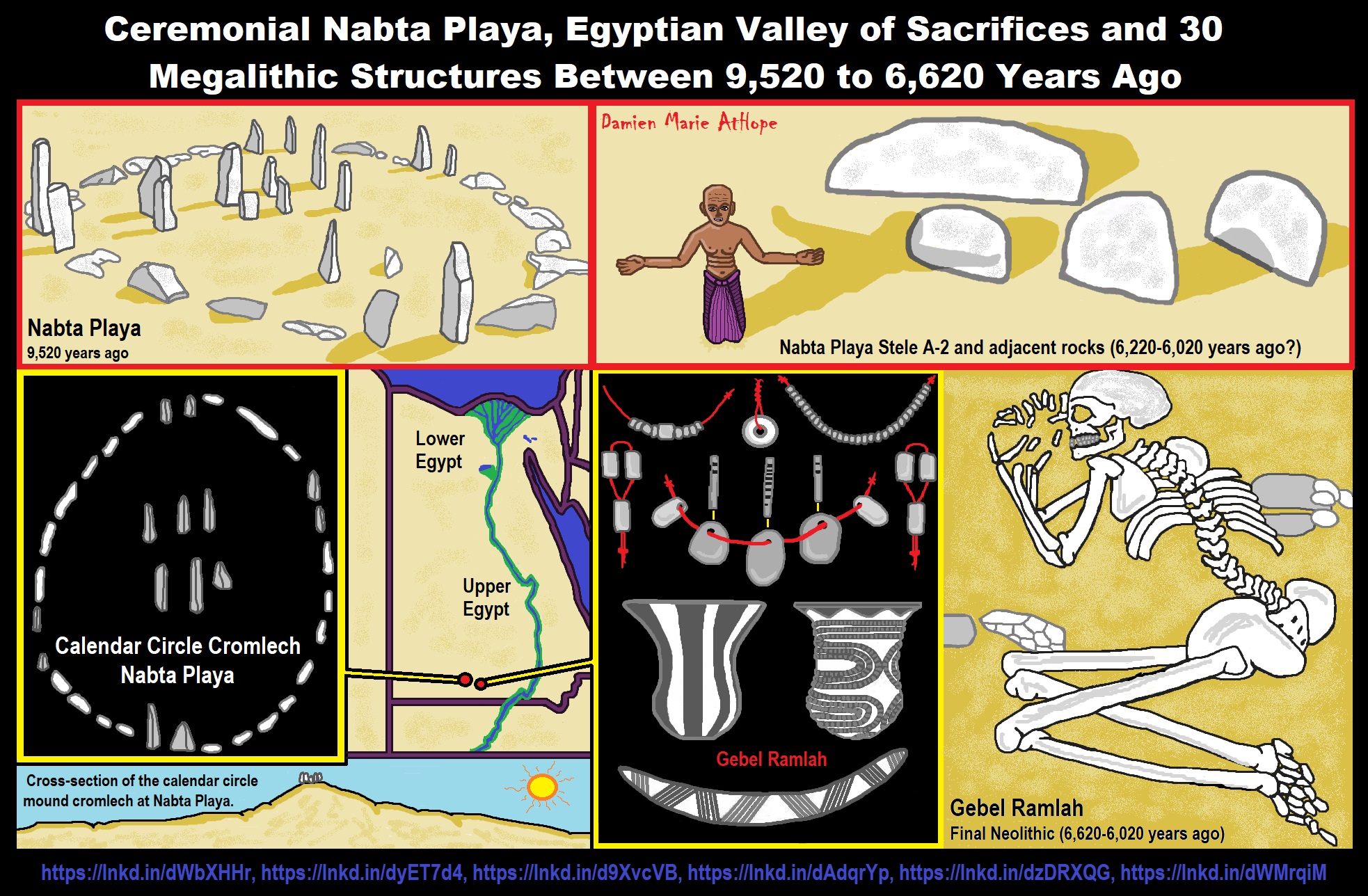
Nabta Playa
“Nabta Playa was once a large endorheic basin in the Nubian Desert, located approximately 800 kilometers south of modern-day Cairo or about 100 kilometers west of Abu Simbel in southern Egypt, 22.51° north, 30.73° east. Today the region is characterized by numerous archaeological sites. The Nabta Playa archaeological site, one of the earliest of the Egyptian Neolithic Period, is dated to circa 7500 BCE or around 9,500 years ago. Although today the western Egyptian desert is totally dry, this was not always the case. There is good evidence that there were several humid periods in the past (when up to 500 mm of rain would fall per year), the most recent one during the last interglacial and early last glaciation periods which stretched between 130,000 and 70,000 years ago. During this time, the area was a savanna and supported numerous animals such as extinct buffalo and large giraffes, varieties of antelope and gazelle. Beginning around the 10th millennium BC, this region of the Nubian Desert began to receive more rainfall, filling a lake. Early people may have been attracted to the region due to the source of water.” ref
“Archaeological findings indicate the presence of small seasonal camps in the region dating to the 9th–8th millennia BC. Fred Wendorf, the site’s discoverer, and ethno-linguist Christopher Ehret have suggested that the people who occupied this region at that time may have been early pastoralists, or like the Saami practiced semi-pastoralism. This is disputed by other sources as the cattle remains found at Nabta have been shown to be morphologically wild in several studies, and hunter-gatherers at the nearby Saharan site of Uan Afada in Libya were penning wild Barbary sheep, an animal that was never domesticated. According to Michael Brass (2018) early cattle remains from Nabta Playa were wild hunted aurochs, whilst domesticated cattle were introduced to northeast Africa in the late 7th millennium BC, originating from cattle domesticated in the Euphrates valley.” ref
“The Nabta Playa—Bir Kiseiba region of southern Egypt, and the initial rigorous debates. More recently, geneticists have entered the fray with determinations on the spread of haplotypes, and the timing thereof, that extend the scope and increase the complexity of the debate. Here, a new look at the botanical data and a re-analysis of the geology of Bir Kiseiba–Nabta Playa rejects the ecological foundations of the early African domestication model, while a detailed examination of the published osteological and radiometric data from the same area reveals a more nuanced picture than has been recognized to date. These results are placed into context by a wider review of the genetic and other archaeological evidence from the Western Desert of Northeast Africa, where no other cattle remains designated as domesticated have been found. It is concluded that (a) Bos remains from the early Holocene at Nabta Playa—Bir Kiseiba were those of hunted aurochs; (b) domesticated caprines were likely present in Northeast Africa before domesticated cattle; and (c) the domesticated cattle spreading across Northeast and northern Africa, including Nabta Playa—Bir Kiseiba, from the late seventh millennium BCE or early sixth millennium BCE onwards were descendants of Bos taurus domesticated in the Middle Euphrates area of the Middle East.” ref
“Most researchers thought the first domesticated cattle in Africa arrived from the Near East, perhaps as early as 7800 years ago. But in the 1980s, a few archaeologists began to argue that inhabitants of northeastern Africa had domesticated cattle independently some 10,000 years ago. A statistical analysis revealed three major genetic trends within current cattle populations across Africa. Two influences came from outside Africa. The genetic signature of zebu–a type of humped cattle domesticated some 8000 years ago in the area of Pakistan–was most prominent in cattle in the Horn of Africa. From this, the team concluded that zebu were introduced to that region primarily through sea trade. Cattle populations across northern Africa, in contrast, contained genetic influence from taurine cattle, which were domesticated at least 8000 years ago in the Fertile Crescent of Turkey and other countries. Another sizable component of the genetic variation featured neither of these influences, leading Hanotte’s team to suspect that it represents a unique domestication of native wild cattle in Africa. A few skeptics remain. “The article does not prove an earlier independent domestication event in Africa,” says Andrew Smith of the University of Cape Town, South Africa. For that, he wants to see archaeological evidence for African cattle domestication that might place it before the same achievement in Near East Asia. Fiona Marshall of Washington University in St. Louis, Missouri, however, is more impressed. To her, the new finding reinforces the idea that people living in Africa during the last 10,000 or so years took an unusual path to food production: domesticating livestock before plants.” ref
“Larger settlements began to appear at Nabta Playa by the 7th millennium BC, relying on deep wells for sources of water. Small huts were constructed in straight rows. Sustenance included wild plants, such as legumes, millets, sorghum, tubers, and fruit. Around 6800 BCE or around 8,800 years ago they began to make pottery locally. In the late 7th millennium BCE goats and sheep, apparently imported from Western Asia, appear. Many large hearths also appear. Early pottery from the Nabta Playa-Bir Kiseiba area has characteristics unlike pottery from surrounding regions. This is followed by pottery with characteristics found only in the Western Desert. Later pottery from c. 5500 BCE (Al Jerar phase) has similarities with pottery from the Sudanese region. Pottery decorations included complex patterns of impressions applied with a comb in a rocking motion.” ref
“Northwest African Neolithic initiated by migrants from Iberia (Portugal and Spain) and the Levant (includes present-day Israel, Jordan, Lebanon, Syria, the Palestinian territories, and most of Turkey southwest of the middle Euphrates). During the Neolithic expansion, various megalithic cultures developed in the Iberian Peninsula. An open seas navigation culture from the east Mediterranean, called the Cardium culture, also extended its influence to the eastern coasts of the peninsula, possibly as early as the 5th millennium BCE. These people may have had some relation to the subsequent development of the Iberian civilization. This pottery style gives its name to the main culture of the Mediterranean Neolithic: Cardium pottery culture or Cardial culture, or impressed ware culture, which eventually extended from the Adriatic sea to the Atlantic coasts of Portugal and south to Morocco. Older Neolithic cultures existed already at this time in eastern Greece and Crete, apparently having arrived from Anatolia, but they appear distinct from the Cardial or impressed ware culture. The ceramic tradition in the central Balkans also remained distinct from that along the Adriatic coastline in both style and manufacturing techniques for almost 1,000 years from the 6th millennium BCE. Early Neolithic impressed pottery is found in the Levant, and certain parts of Anatolia, including Mezraa-Teleilat, and in North Africa at Tunus-Redeyef, Tunisia. Impressed pottery also appears in Egypt. Along the East Mediterranean coast impressed ware has been found in North Syria, Israel, and Lebanon. In northwestern Africa, lifestyle transitioned from foraging to food production around 7,400 years ago but what sparked that change remains unclear. Archaeological data support conflicting views: (1) that migrant European Neolithic farmers brought the new way of life to North Africa or (2) that local hunter-gatherers adopted technological innovations. The latter view is also supported by archaeogenetic data. Here we fill key chronological and archaeogenetic gaps for the Maghreb, from Epipalaeolithic to Middle Neolithic, by sequencing the genomes of nine individuals (to between 45.8- and 0.2-fold genome coverage). Notably, we trace 8,000 years of population continuity and isolation from the Upper Palaeolithic, via the Epipaleolithic, to some Maghrebi Neolithic farming groups. However, remains from the earliest Neolithic contexts showed mostly European Neolithic ancestry. We suggest that farming was introduced by European migrants and was then rapidly adopted by local groups. During the Middle Neolithic a new ancestry from the Levant appears in the Maghreb, coinciding with the arrival of pastoralism in the region, and all three ancestries blend together during the Late Neolithic. Our results show ancestry shifts in the Neolithization of northwestern Africa that probably mirrored a heterogeneous economic and cultural landscape, in a more multifaceted process than observed in other regions.” ref, ref, ref
“Joel D. Irish (2001), reported in “Holocene Settlement of the Egyptian Sahara”, based on osteological and dental data suggested a mainly sub-Saharan African affinity and origin at Nabta (with sub-Saharan tendencies most commonly detected), but also possible North African tendencies, concluding that, “Henneberg et al. suggest that the Nabta Playa people may have been most similar to Negroes from south of the Sahara. The present qualitative dental comparison tentatively supports this conclusion.”. Some researchers, including Christopher Ehret, have suggested a Nilo-Saharan linguistic affinity for the Nabta people.” ref
“By the 6th millennium BC or between 8,000 to 7,000 years ago, evidence of a prehistoric religion or cult appears. From 5500 BCE or around 7,500 years ago the Late Neolithic period began, with “a new group that had a complex social system expressed in a degree of organisation and control not previously seen.” These new people were responsible for sacrificial cattle burials in clay-lined and roofed chambers covered by rough stone tumuli. It has been suggested that the associated cattle cult indicated in Nabta Playa marks an early evolution of Ancient Egypt‘s Hathor cult. For example, Hathor was worshipped as a nighttime protector in desert regions (see Serabit el-Khadim). To directly quote professors Wendorf and Schild: “… there are many aspects of political and ceremonial life in prehistoric Egypt and the Old Kingdom that reflects a strong impact from Saharan cattle pastoralists …” Rough megalithic stone structures buried underground are also found in Nabta Playa, one of which included evidence of what Wendorf described as perhaps “the oldest known sculpture in Egypt.” ref
“In the 5th millennium BC or between 7,000 to 6,000 years agothese peoples fashioned what may be among the world’s earliest known archeoastronomical devices (roughly contemporary to the Goseck circle in Germany and the Mnajdra megalithic temple complex in Malta). These include alignments of stones that may have indicated the rising of certain stars and a “calendar circle” that indicates the approximate direction of summer solstice sunrise. “Calendar circle” may be a misnomer as the spaces between the pairs of stones in the gates are a bit too wide, and the distances between the gates are too short for accurate calendar measurements.” An inventory of Egyptian archaeoastronomical sites for the UNESCO World Heritage Convention evaluated Nabta Playa as having “hypothetical solar and stellar alignments.” ref
“Astrophysicist Thomas G. Brophy suggests the hypothesis that the southerly line of three stones inside the Calendar Circle represented the three stars of Orion’s Belt and the other three stones inside the calendar circle represented the shoulders and head stars of Orion as they appeared in the sky. These correspondences were for two dates – circa 4800 BC and at precessional opposition – representing how the sky “moves” long term. Brophy proposes that the circle was constructed and used circa the later date, and the dual date representation was a conceptual representation of the motion of the sky over a precession cycle. Near the Calendar Circle, which is made of smaller stones, there are alignments of large megalithic stones. The southerly lines of these megaliths, Brophy argues, aligned to the same stars as represented in the Calendar Circle, all at the same epoch, circa 6270 BCE. Brophy argues that the Calendar Circle correlation with Orion’s belt occurred between 6400 and 4900 BCE or around 8,400 to 6,900 years ago, matching radio-carbon dates of some campfires in the area.” ref
“A 2007 article by a team of University of Colorado archaeoastronomers and archaeologists (Malville, Schild, Wendorf and Brenmer, three of whom had been involved in the original discovery of the site and its astronomical alignment) responded to the work of Brophy and Rosen, in particular their claims for an alignment with Sirius in 6088 BC and other alignments which they dated to 6270 BC, saying that these dates “are about 1500 years earlier than our best estimates for the Terminal Neolithic and the construction of megalithic structures” at Nabta Playa.” ref
“The Sirius alignment in question was originally proposed by Wendorf and Malville, for one of the most prominent alignments of megaliths labelled the “C-line”, which they said aligned to the rising of Sirius circa 4820 BCE or around 6,820 years ago. Brophy and Rosen stated in 2005 that megalith orientations and star positions reported by Wendorf and Malville were in error, noting that “Given these corrected data, we see that Sirius actually aligned with the C-line circa 6000 BCE. We estimate that 6088 BCE or around 8,088 years ago Sirius had a declination of -36.51 degrees, for a rising azimuth exactly on the C-line average”. However, according to Malville, Schild et al. (2007) the dates proposed by Brophy are inconsistent with the archaeological evidence, and “inference in archaeoastronomy must always be guided and informed by archaeology, especially when substantial field work has been performed in the region”. They also concluded that, on closer inspection, the C-line of megaliths “consists of stones resting on the sides and tops of dunes and may not represent an original set of aligned stele.” ref
“More complex structures followed during a megalith period the researchers dated to between about 4500 to 3600 BCE or around 6,500 to 5,600 years ago. Using their original measurements, complemented by satellite imagery and GPS measurements by Brophy and Rosen, they confirmed possible alignments with Sirius, Arcturus, Alpha Centauri, and the Belt of Orion. They suggest that there are three pieces of evidence suggesting astronomical observations by the herdsmen using the site, which may have functioned as a necropolis. “The repetitive orientation of megaliths, stele, human burials and cattle burials reveals a very early symbolic connection to the north.” Secondly, there is the orientation of the cromlech mentioned above. The third piece of evidence is the fifth millennium alignments of stele to bright stars. They conclude their report by writing that “The symbolism embedded in the archaeological record of Nabta Playa in the Fifth Millennium BCE is very basic, focussed on issues of major practical importance to the nomads: cattle, water, death, earth, sun and stars.” ref
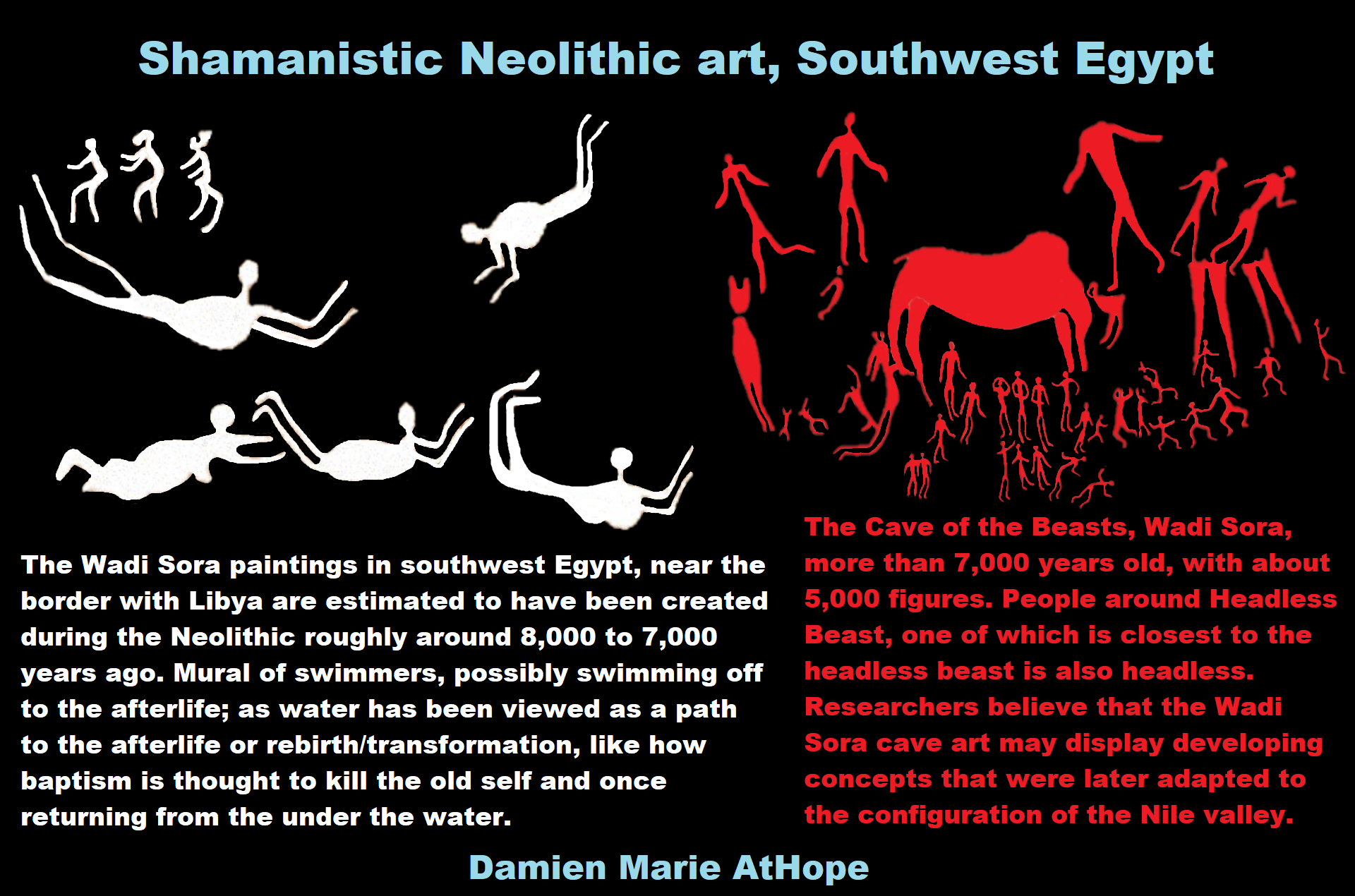
“The Cave of Swimmers is a cave with ancient rock art in the mountainous Gilf Kebir plateau of the Libyan Desert section of the Sahara. It is located in the New Valley Governorate of southwest Egypt, near the border with Libya. It contains Neolithic pictographs (rock painting images) and is named due to the depictions of people with their limbs bent as if they were swimming. The drawings include those of giraffe and hippopotamus. They are estimated to have been created as early as 10,000 years ago with the beginning of the African Humid Period, when the Sahara was significantly greener and wetter than it is today. The cause of the climate change 10,000 years ago was due to changes in summer solar insolation and vegetation and dust feedbacks. Due to similar artwork being found in nearby caves, such as the Cave of Beasts, and the continuous line that the figures create extending across a majority of the cave’s interior has led researchers to believe that the cave art may display developing concepts that were later adapted to the configuration of the Nile valley.” ref
“The African humid period (AHP; also known by other names) is a climate period in Africa during the late Pleistocene and Holocene geologic epochs, when northern Africa was wetter than today. The covering of much of the Sahara desert by grasses, trees and lakes was caused by changes in the Earth’s axial tilt; changes in vegetation and dust in the Sahara which strengthened the African monsoon; and increased greenhouse gases. During the preceding Last Glacial Maximum, the Sahara contained extensive dune fields and was mostly uninhabited. It was much larger than today, and its lakes and rivers such as Lake Victoria and the White Nile were either dry or at low levels. The humid period began about 14,600–14,500 years ago at the end of Heinrich event 1, simultaneously to the Bølling–Allerød warming. Rivers and lakes such as Lake Chad formed or expanded, glaciers grew on Mount Kilimanjaro and the Sahara retreated. Two major dry fluctuations occurred; during the Younger Dryas and the short 8.2 kiloyear event. The African humid period ended 6,000–5,000 years ago during the Piora Oscillation cold period. While some evidence points to an end 5,500 years ago, in the Sahel, Arabia, and East Africa, the end of the period appears to have taken place in several steps, such as the 4.2-kiloyear event.” ref
“The African humid period took place in the late Pleistocene and early-middle Holocene, and saw increased precipitation in Northern and Western Africa due to a northward migration of the tropical rainbelt. The AHP is the most profound climate change of the low latitudes during the last 100,000 years and stands out within the otherwise relatively climatically stable Holocene. It is part of the so-called Holocene climatic optimum and coincides with a global warm phase, the Holocene Thermal Maximum. Liu et al. 2017 subdivided the humid period into an “AHP I” which lasted until 8,000 years ago, and an “AHP II” from 8,000 years onward, with the former being wetter than the latter. The AHP led to a widespread settlement of the Sahara and the Arabian Deserts, and had a profound effect on African cultures, such as the birth of the Ancient Egyptian civilization. People in the Sahara lived as hunter-gatherers and domesticated cattle, goats and sheep. They left archaeological sites and artifacts such as one of the oldest ships in the world, and rock paintings such as those in the Cave of Swimmers and in the Acacus Mountains. Earlier humid periods in Africa were postulated after the discovery of these rock paintings in now-inhospitable parts of the Sahara. When the period ended, humans gradually abandoned the desert in favour of regions with more secure water supplies, such as the Nile Valley and Mesopotamia, where they gave rise to early complex societies.” ref
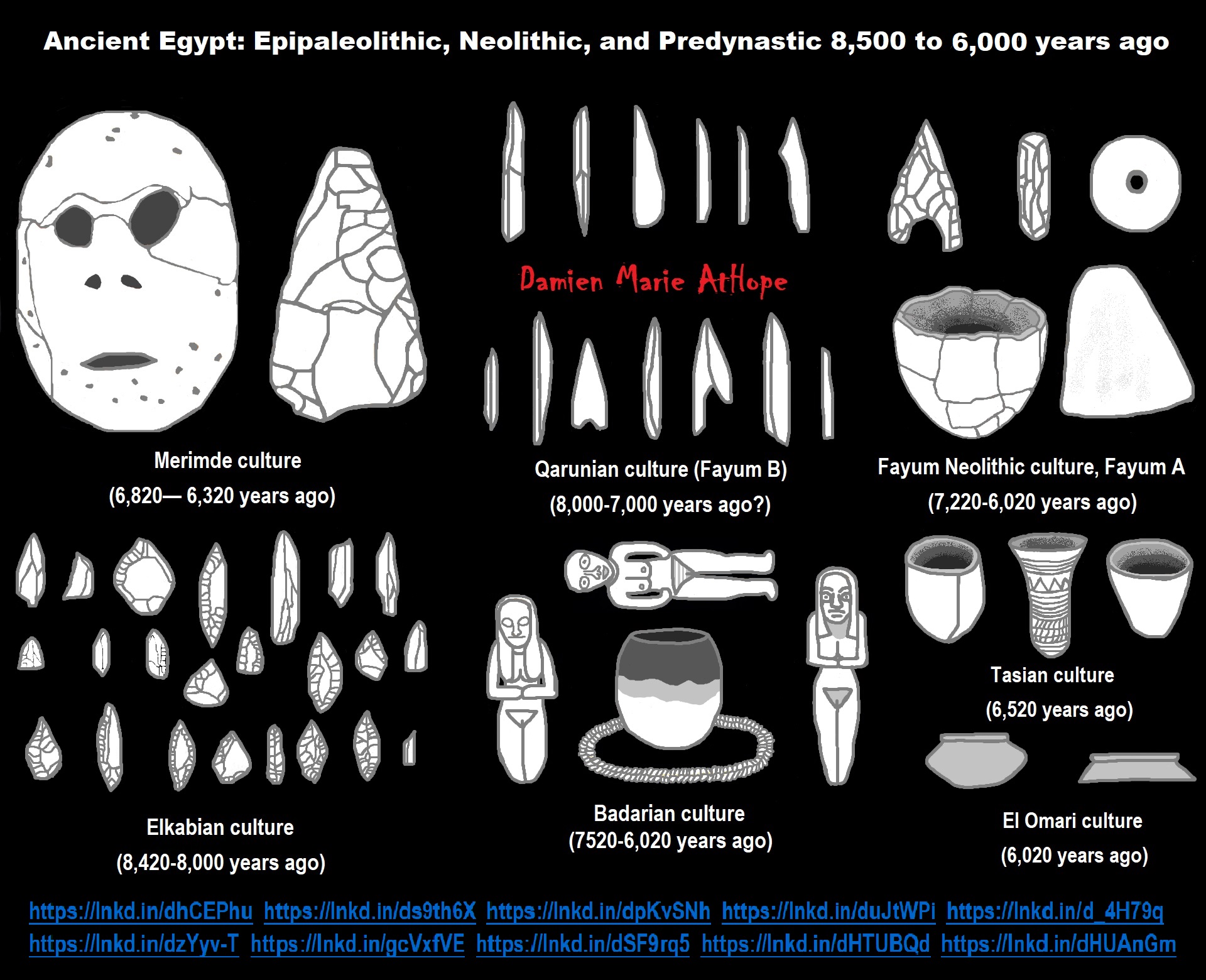
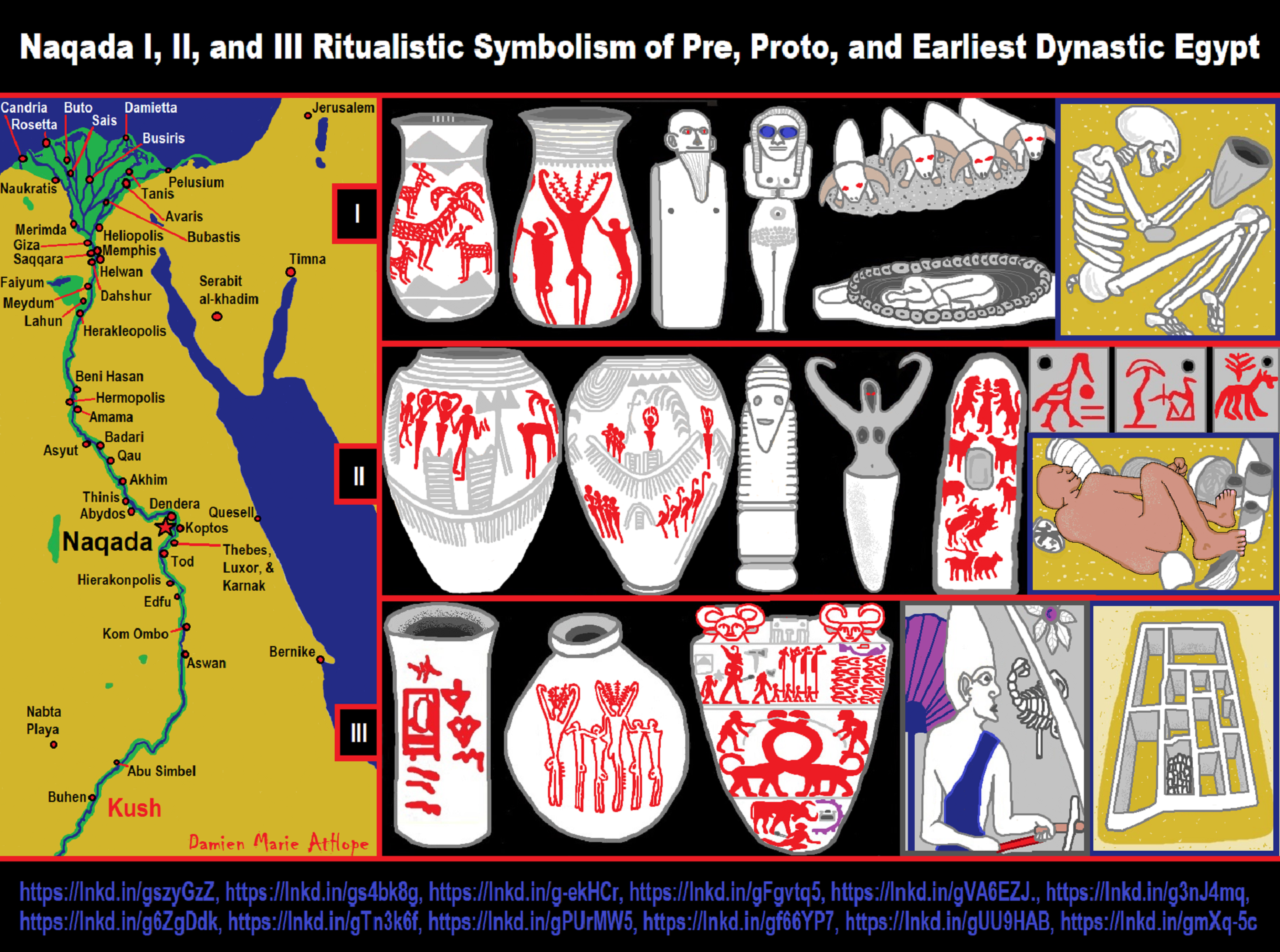
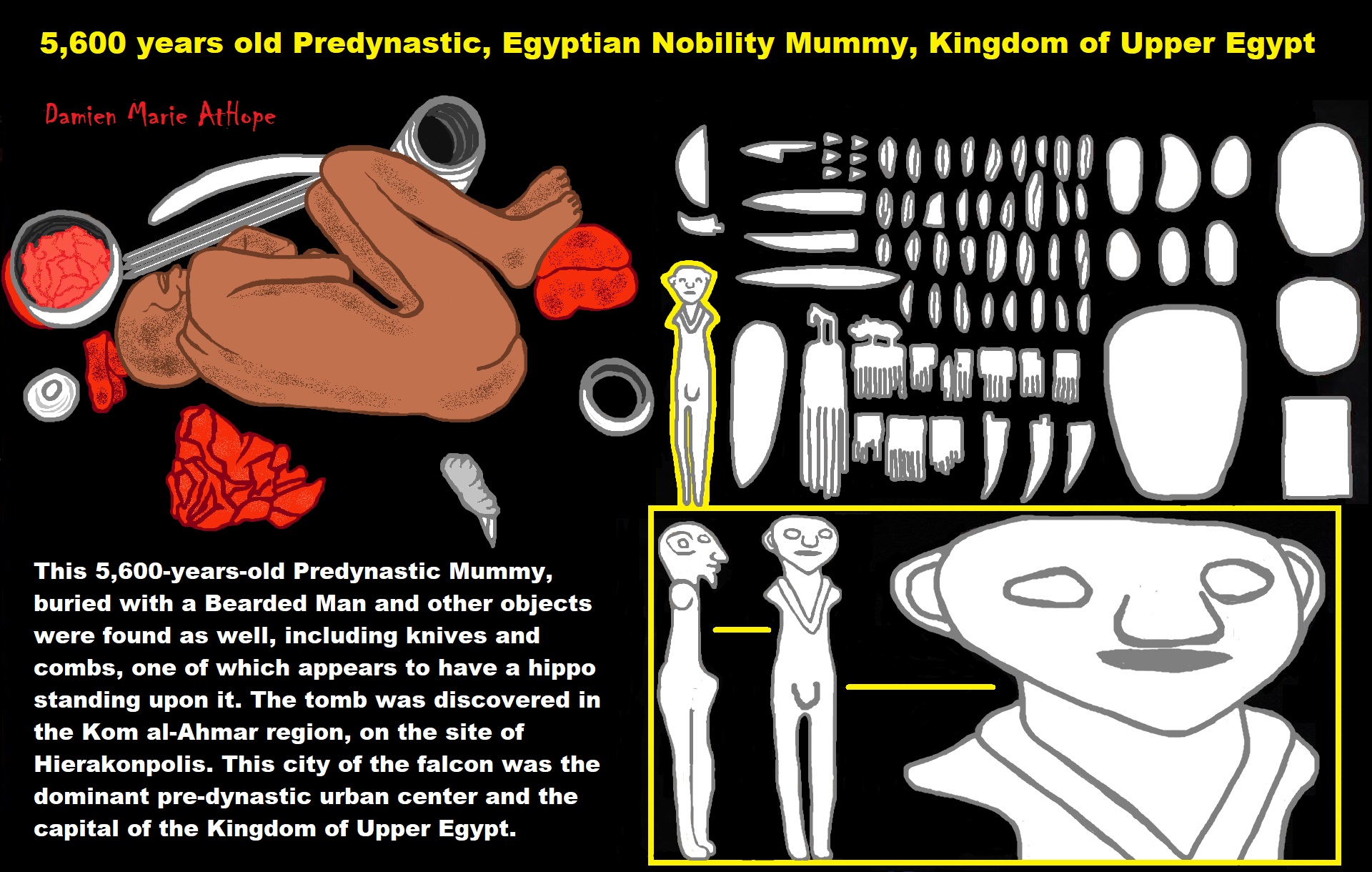
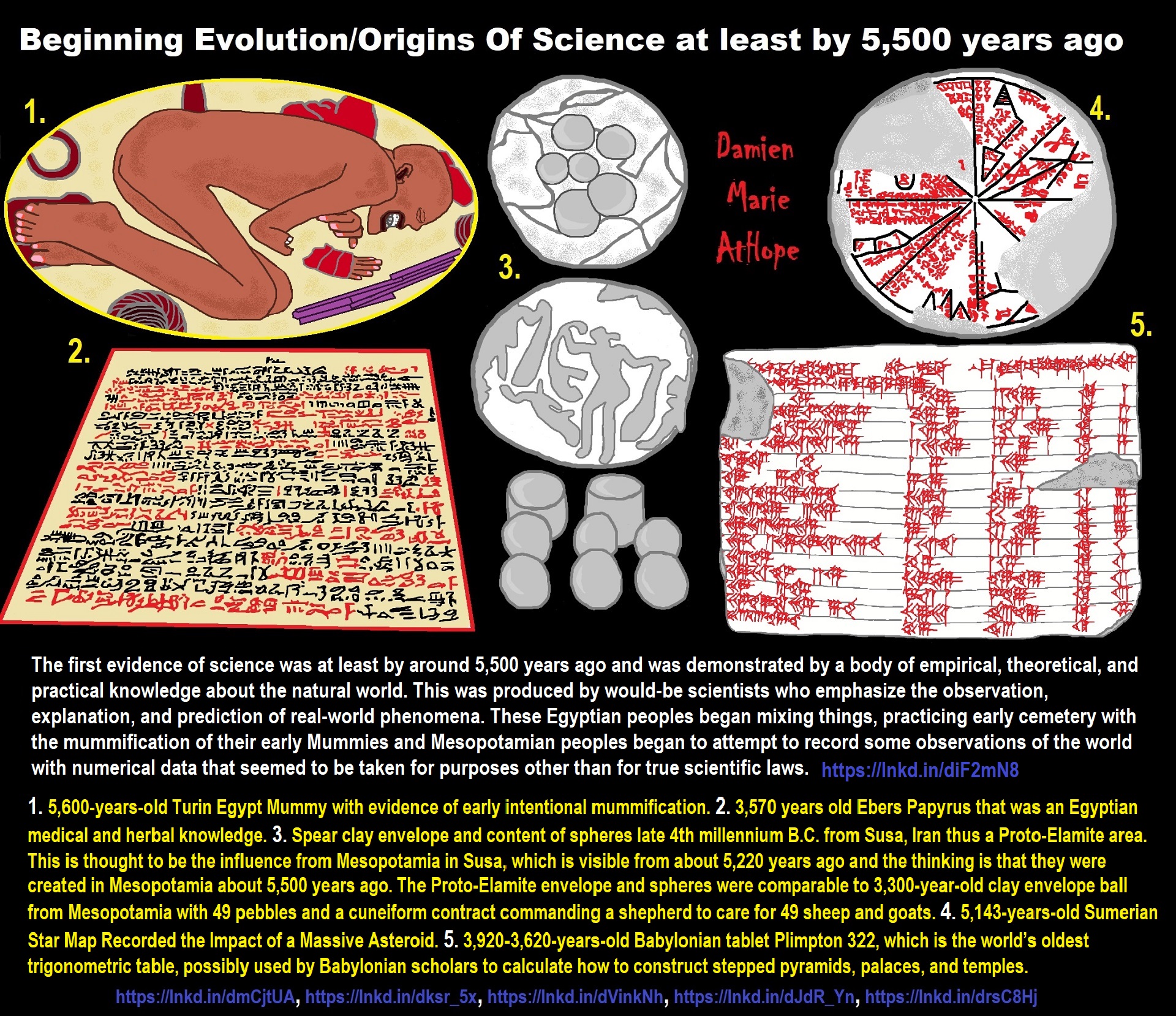
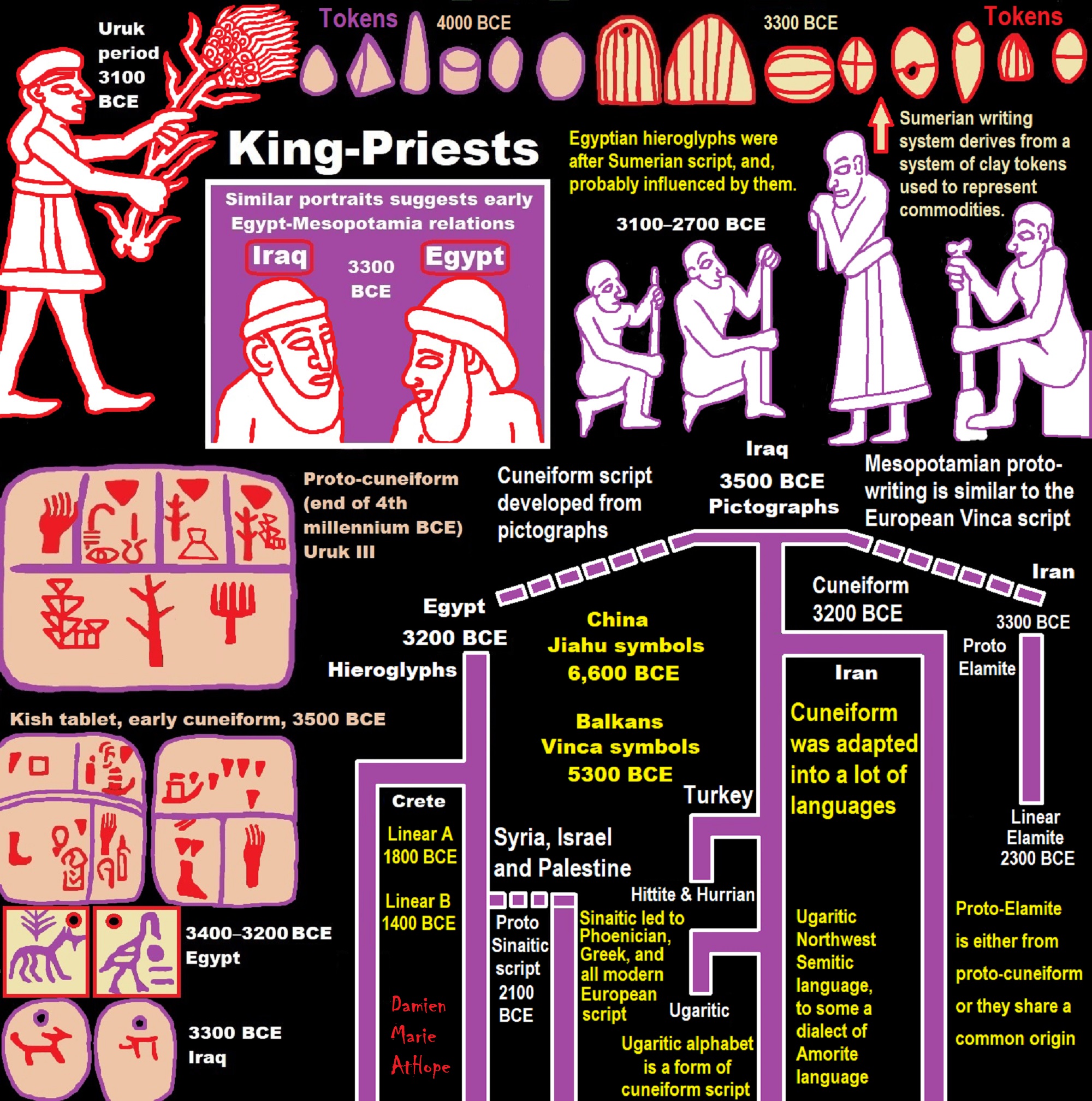
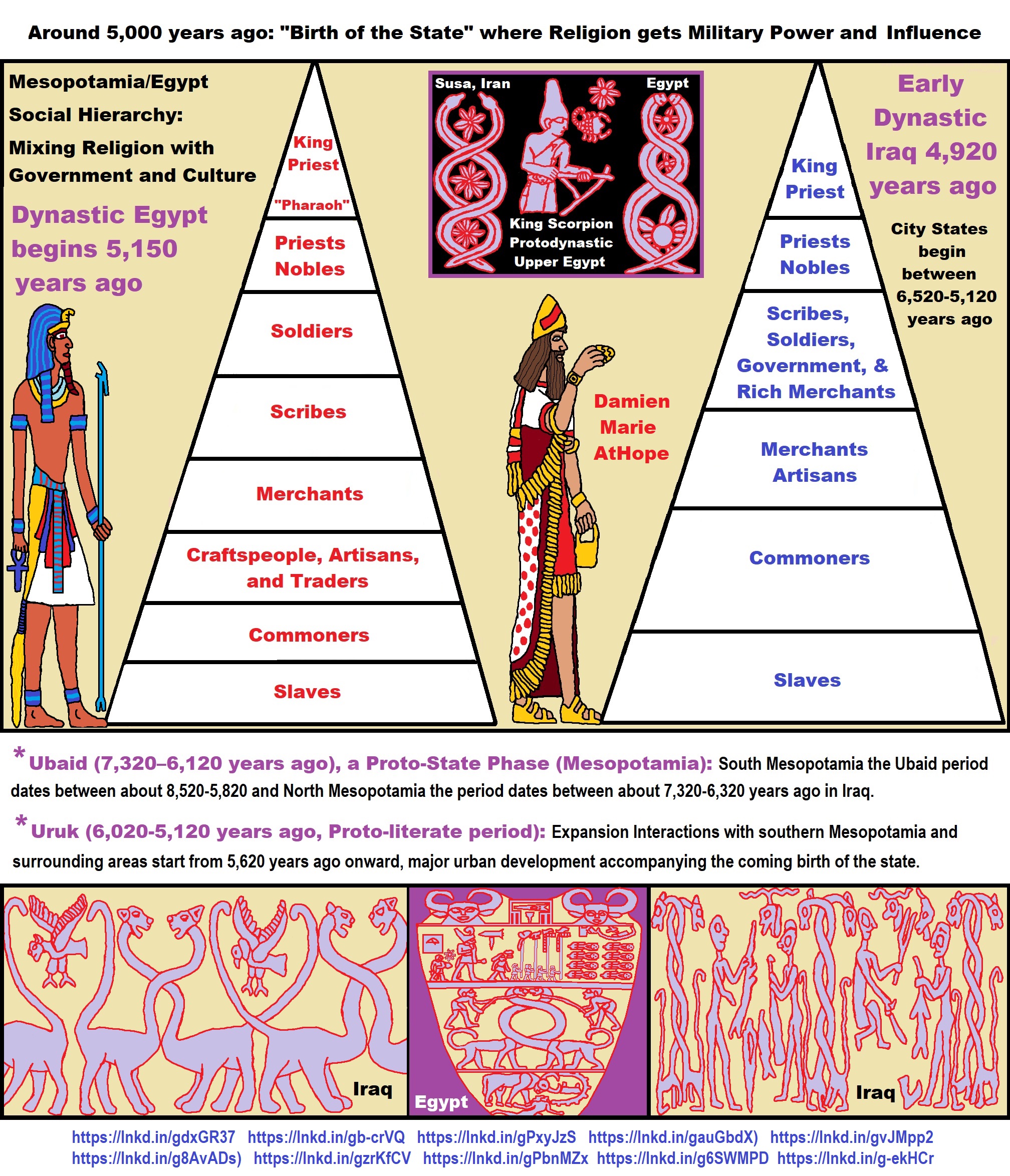

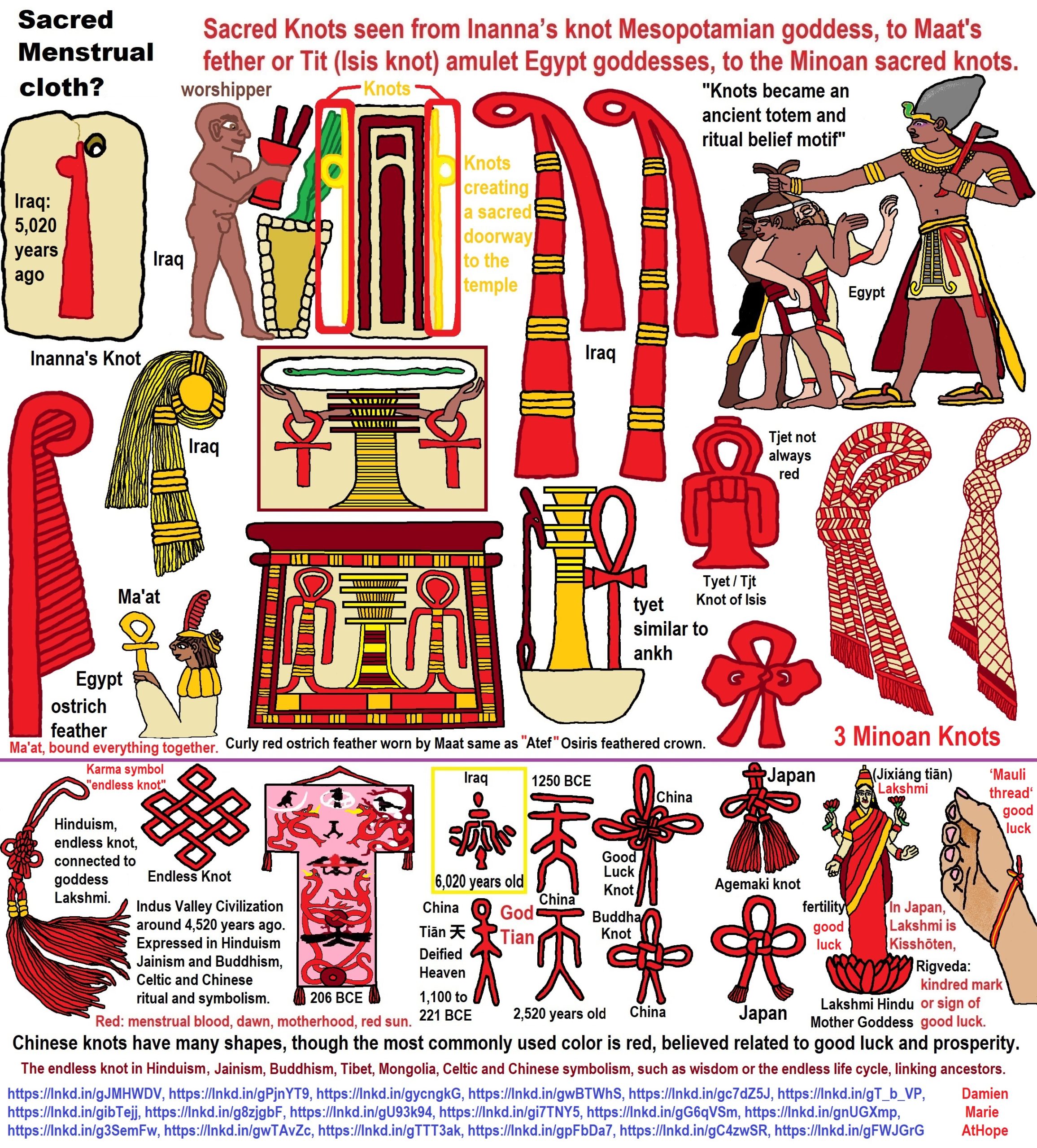
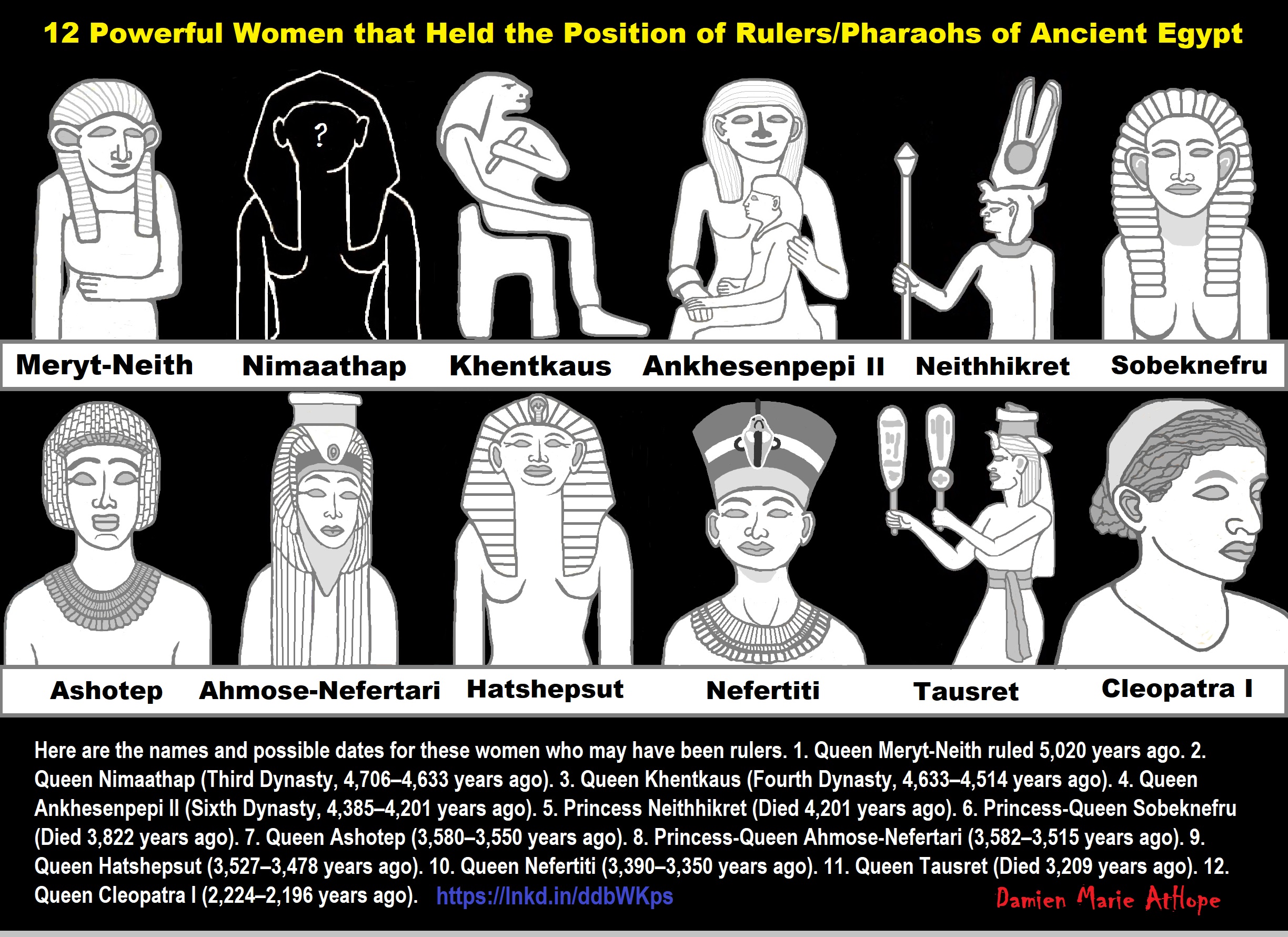
ref, ref, ref, ref, ref, ref, ref, ref, ref, ref, ref, ref, ref, ref, ref, ref
12 Powerful Women that Held the Position of Rulers/Pharaohs of Ancient Egypt
Here are the names and possible dates for these women who may have been rulers. 1. Queen Meryt-Neith ruled 5,020 years ago. 2. Queen Nimaathap (Third Dynasty, 4,706–4,633 years ago). 3. Queen Khentkaus (Fourth Dynasty, 4,633–4,514 years ago). 4. Queen Ankhesenpepi II (Sixth Dynasty, 4,385–4,201 years ago). 5. Princess Neithhikret (Died 4,201 years ago). 6. Princess-Queen Sobeknefru (Died 3,822 years ago). 7. Queen Ashotep (3,580–3,550 years ago). 8. Princess-Queen Ahmose-Nefertari (3,582–3,515 years ago). 9. Queen Hatshepsut (3,527–3,478 years ago). 10. Queen Nefertiti (3,390–3,350 years ago). 11. Queen Tausret (Died 3,209 years ago). 12. Queen Cleopatra I (2,224–2,196 years ago).
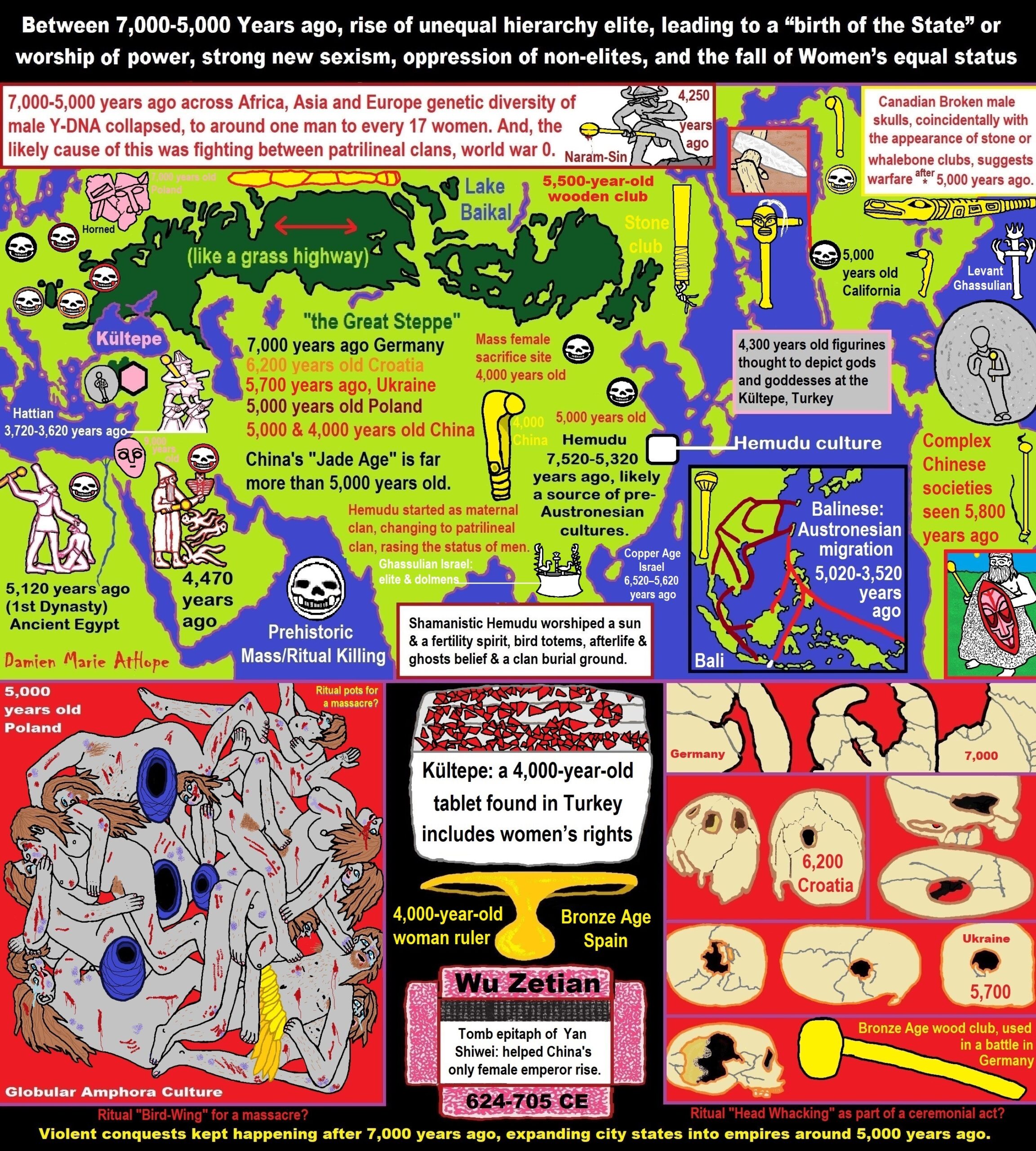
ref, ref, ref, ref, ref, ref, ref, ref, ref, ref, ref, ref, ref, ref, ref, ref, ref, ref, ref, ref, ref, ref, ref, ref, ref, ref, ref, ref, ref, ref, ref, ref, ref, ref, ref, ref, ref, ref, ref, ref, ref, ref, ref, ref, ref, ref, ref, ref, ref, ref, ref, ref, ref, ref, ref, ref, ref, ref, ref, ref, ref, ref, ref, ref, ref, ref, ref, ref, ref, ref, ref, ref, ref, ref, ref, ref, ref, ref, ref, ref, ref, ref, ref, ref, ref, ref, ref, ref, ref, ref
- Paganism 7,000-5,000 years old: related to “Anarchism and Socialism” (Capitalism) (World War 0) Elite and their slaves!
- Evolution of human skin color, White-Skin is really under 10,000 years old? Yet, Racism is something Terrible and New, under 7,000 years ago!
- White (light complexion skin) Bigotry and Sexism started 7,000 years ago?
- The First Expression of the Male God around 7,000 years ago?
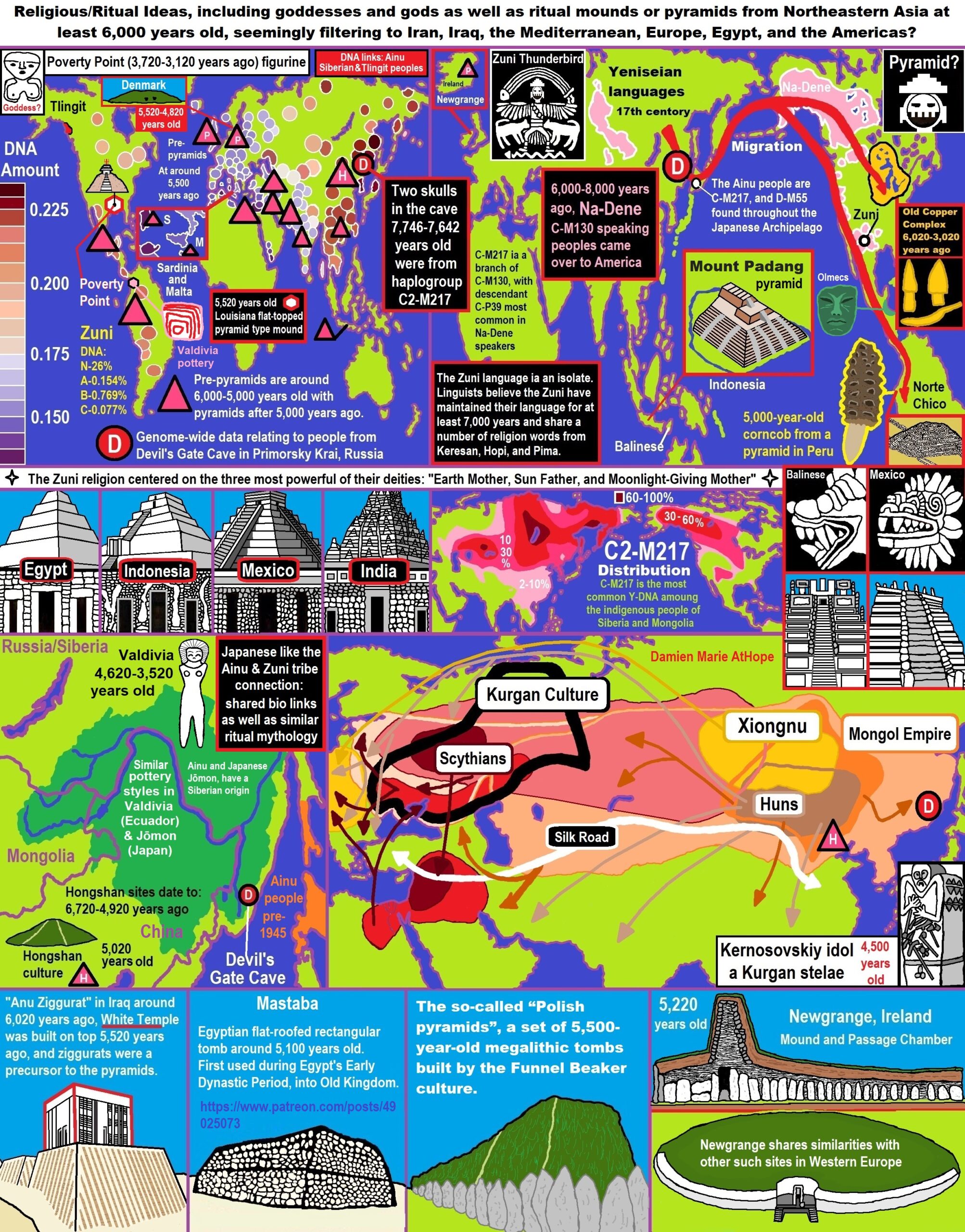
- Sacred Mounds, Mountains, Kurgans, and Pyramids may hold deep Mythology connections?
- Shell Mounds, Earth Mounds, Raised Platforms, and Pyramids: which I think are somewhat related in mythology thinking and culture beliefs
- Dené–Yeniseian language, Old Copper Complex, and Pre-Columbian Mound Builders?
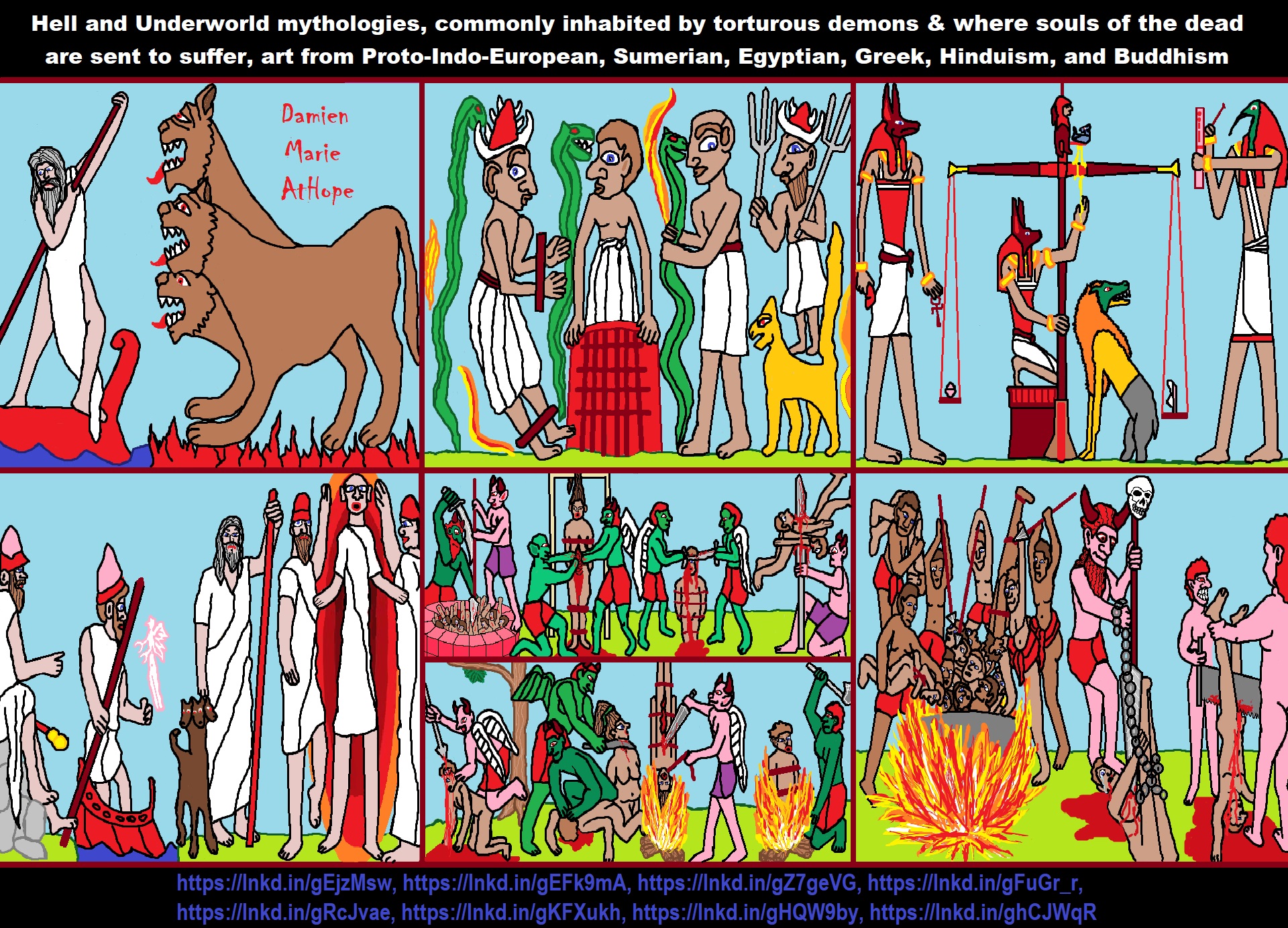
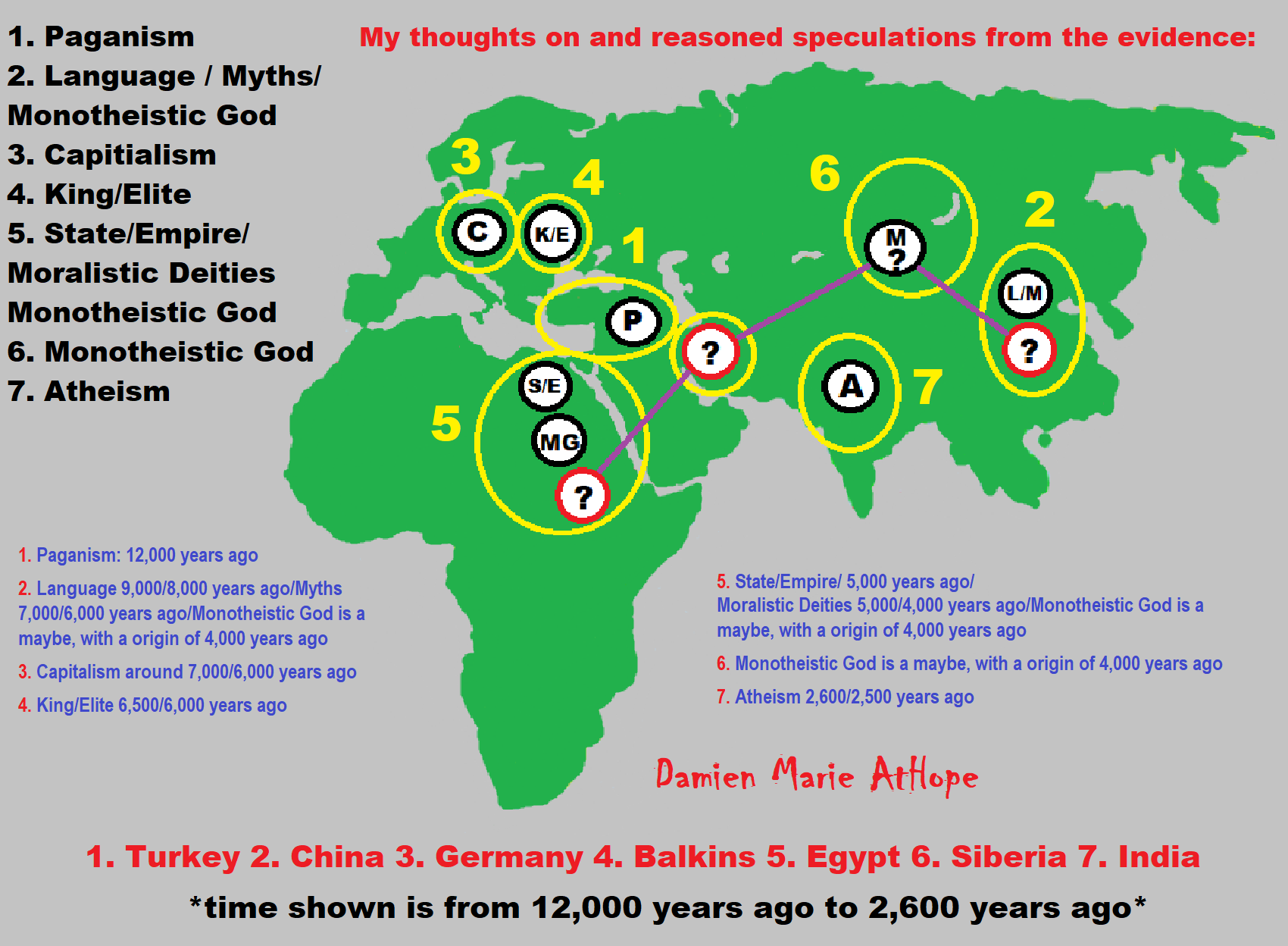
If you are a religious believer, may I remind you that faith in the acquisition of knowledge is not a valid method worth believing in. Because, what proof is “faith”, of anything religion claims by faith, as many people have different faith even in the same religion?
Religious Sexism
- Speech on the Evolution of Religion & Religious Sexism
- Sexism in the Major World Religions
- Sexism in the BIBLE: chapter and verse!
- Sexism in Christianity (New Testament)
- Sexism in Judaism (old Testament)
- Sexism in Islam? Face Covering: Religious Freedom or Religious Oppression
- Sexism in Islam
- Sexism in Protestantism
- Sexism in Catholicism
- Sexism in Mormonism
- Sexism in Jehovah Witness
- Sexism in Bahaism
- Sexism in Sikhism
- Sexism in Confucianism
- Sexism in Taoism
- Sexism in Jainism
- Sexism in Shintoism
- Sexism in Buddhism
- Sexist Buddha
- Sexism in Hinduism
- Taoism yang and yin is very sexist
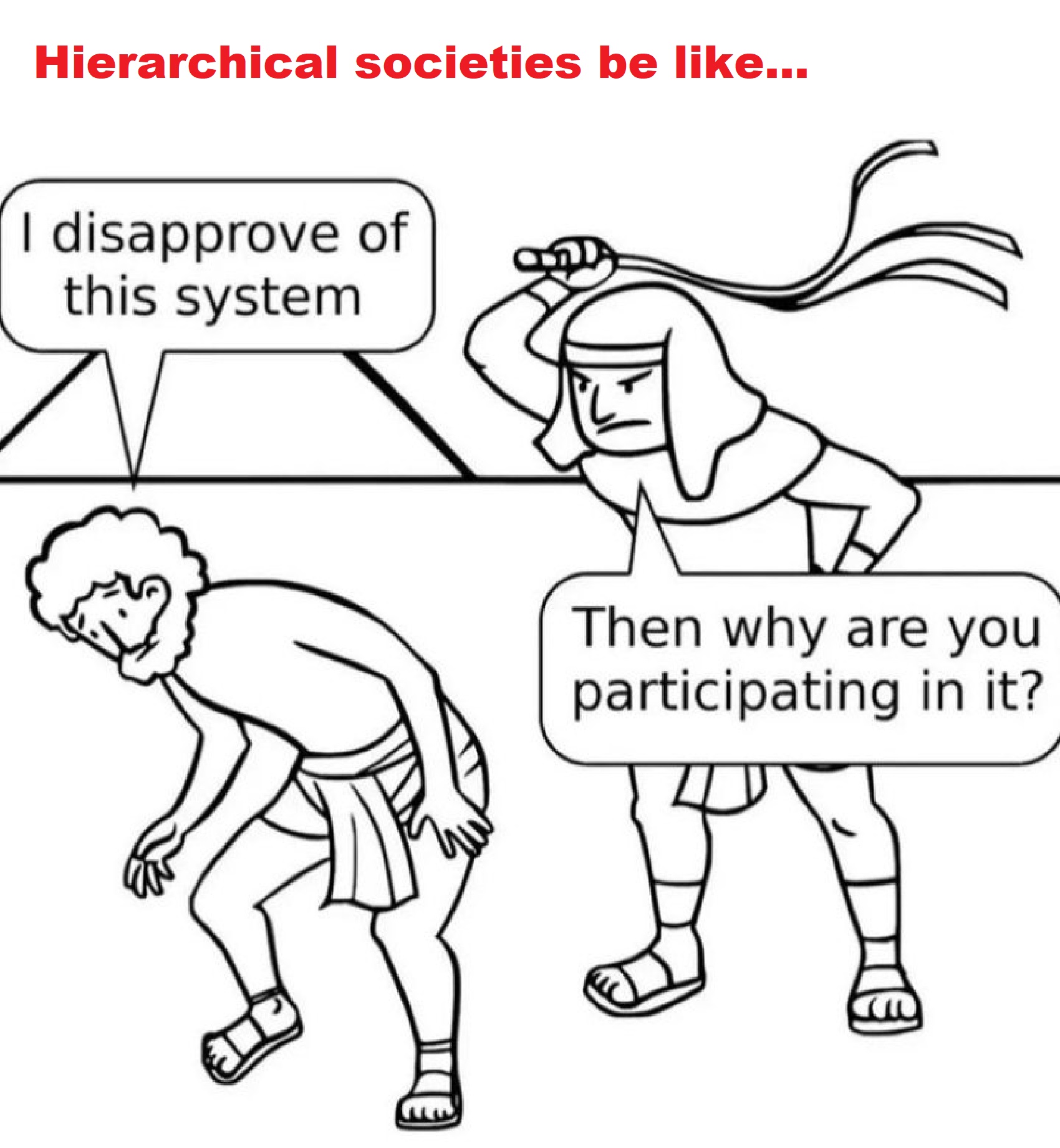
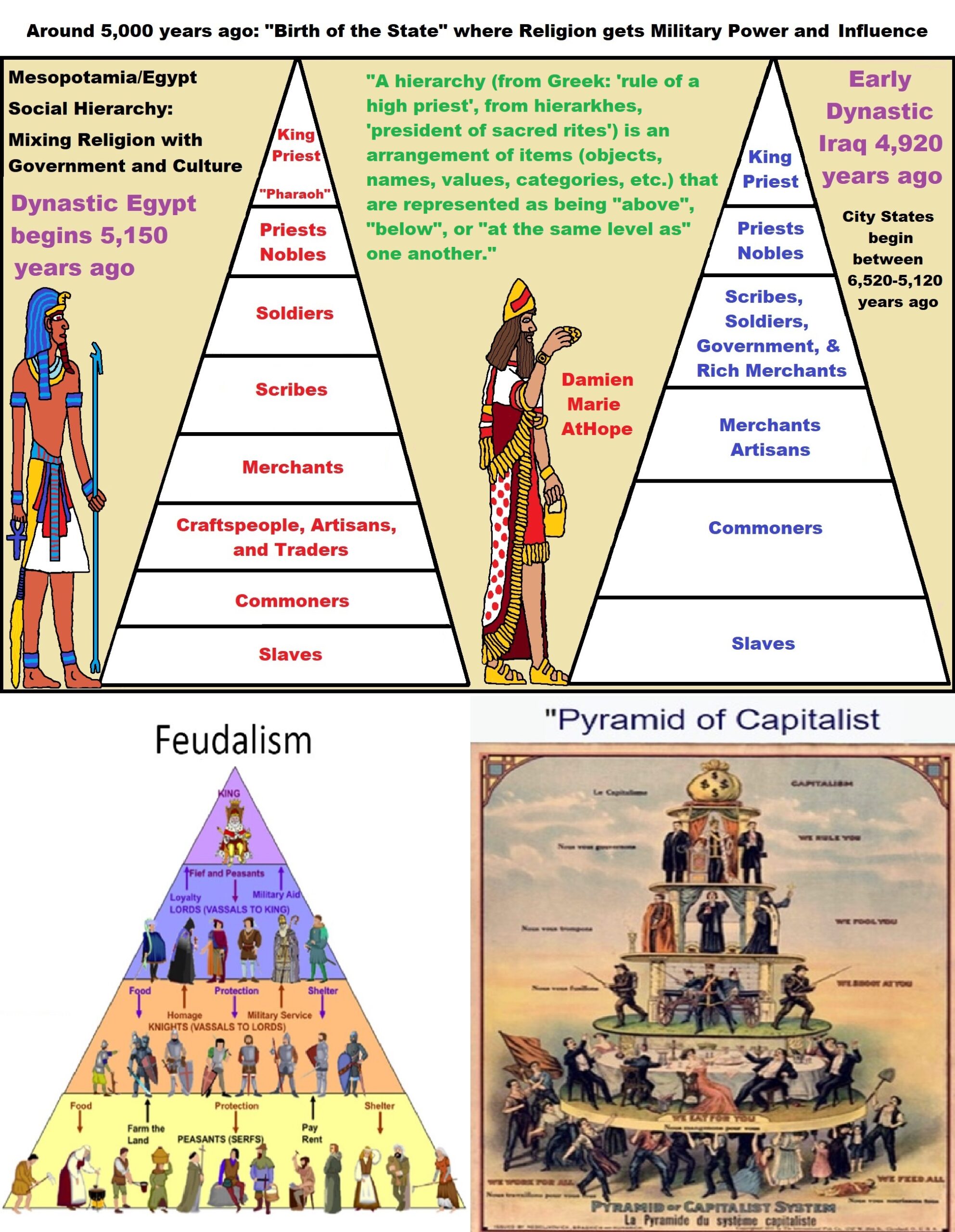
“The Pyramid of Capitalist System is a common name of a 1911 American cartoon caricature critical of capitalism, based on older similar pictures. In 1900, the Belgian Labour Party used a picture called “Pyramide à renverser” (lit. ’a pyramid that has to be overthrown’) during its electoral campaign. The basic message of the image is a critique of the capitalist system, depicting a hierarchy of power and wealth. It illustrates a working class supporting all others, and if it would withdraw their support from the system it could topple the existing social order.” ref
“Anti-capitalism is a political ideology and movement encompassing a variety of attitudes and ideas that oppose capitalism. In this sense, anti-capitalists are those who wish to replace capitalism with another type of economic system, such as socialism or communism. Socialism advocates public or direct worker ownership and administration of the means of production and allocation of resources, and a society characterized by equal access to resources for all individuals, with an egalitarian method of compensation. Karl Marx saw capitalism as a historical stage, once progressive but which would eventually stagnate due to internal contradictions and would eventually be followed by socialism. Marx claimed that capitalism was nothing more than a necessary stepping stone for the progression of man, which would then face a political revolution before embracing the classless society.” ref
“In addition to individualist anarchist Benjamin Tucker‘s “big four” monopolies (land, money, tariffs, and patents), Kevin Carson argues that the state has also transferred wealth to the wealthy by subsidizing organizational centralization, in the form of transportation and communication subsidies. He believes that Tucker overlooked this issue due to Tucker’s focus on individual market transactions, whereas Carson also focuses on organizational issues. Carson holds that “capitalism, arising as a new class society directly from the old class society of the Middle Ages, was founded on an act of robbery as massive as the earlier feudal conquest of the land. It has been sustained to the present by continual state intervention to protect its system of privilege without which its survival is unimaginable.” ref
“Within anarchism there emerged a critique of wage slavery, which refers to a situation perceived as quasi-voluntary slavery, where a person’s livelihood depends on wages, especially when the dependence is total and immediate. It is a negatively connoted term used to draw an analogy between slavery and wage labor by focusing on similarities between owning and renting a person. The term wage slavery has been used to criticize economic exploitation and social stratification, with the former seen primarily as unequal bargaining power between labor and capital (particularly when workers are paid comparatively low wages, e.g. in sweatshops), and the latter as a lack of workers’ self-management, fulfilling job choices and leisure in an economy. Libertarian socialists believe if freedom is valued, then society must work towards a system in which individuals have the power to decide economic issues along with political issues. Libertarian socialists seek to replace unjustified authority with direct democracy, voluntary federation, and popular autonomy in all aspects of life, including physical communities and economic enterprises.” ref

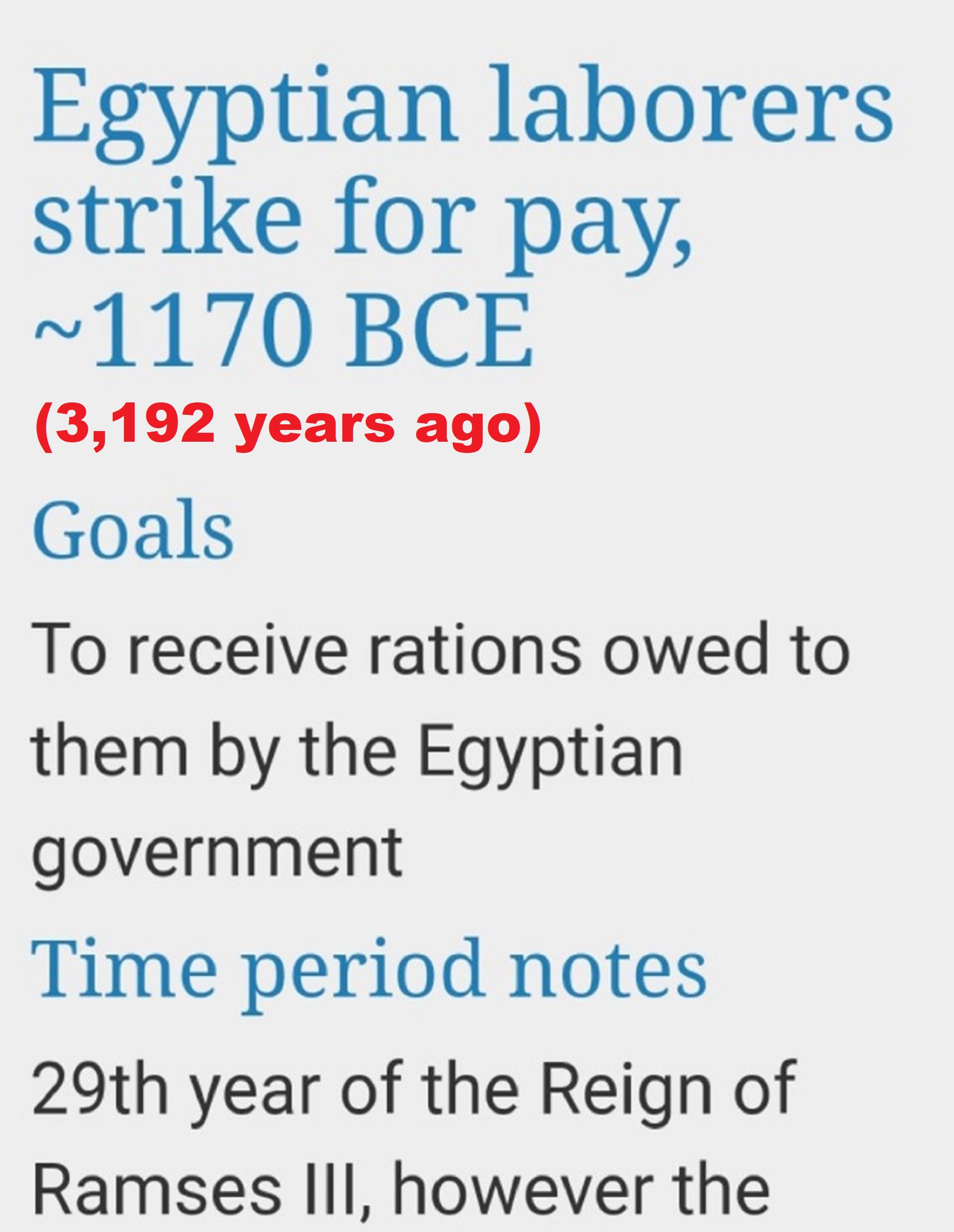

People don’t commonly teach religious history, even that of their own claimed religion. No, rather they teach a limited “pro their religion” history of their religion from a religious perspective favorable to the religion of choice.

Do you truly think “Religious Belief” is only a matter of some personal choice?
Do you not see how coercive one’s world of choice is limited to the obvious hereditary belief, in most religious choices available to the child of religious parents or caregivers? Religion is more commonly like a family, culture, society, etc. available belief that limits the belief choices of the child and that is when “Religious Belief” is not only a matter of some personal choice and when it becomes hereditary faith, not because of the quality of its alleged facts or proposed truths but because everyone else important to the child believes similarly so they do as well simply mimicking authority beliefs handed to them. Because children are raised in religion rather than being presented all possible choices but rather one limited dogmatic brand of “Religious Belief” where children only have a choice of following the belief as instructed, and then personally claim the faith hereditary belief seen in the confirming to the belief they have held themselves all their lives. This is obvious in statements asked and answered by children claiming a faith they barely understand but they do understand that their family believes “this or that” faith, so they feel obligated to believe it too. While I do agree that “Religious Belief” should only be a matter of some personal choice, it rarely is… End Hereditary Religion!

Animism: Respecting the Living World by Graham Harvey
“How have human cultures engaged with and thought about animals, plants, rocks, clouds, and other elements in their natural surroundings? Do animals and other natural objects have a spirit or soul? What is their relationship to humans? In this new study, Graham Harvey explores current and past animistic beliefs and practices of Native Americans, Maori, Aboriginal Australians, and eco-pagans. He considers the varieties of animism found in these cultures as well as their shared desire to live respectfully within larger natural communities. Drawing on his extensive casework, Harvey also considers the linguistic, performative, ecological, and activist implications of these different animisms.” ref
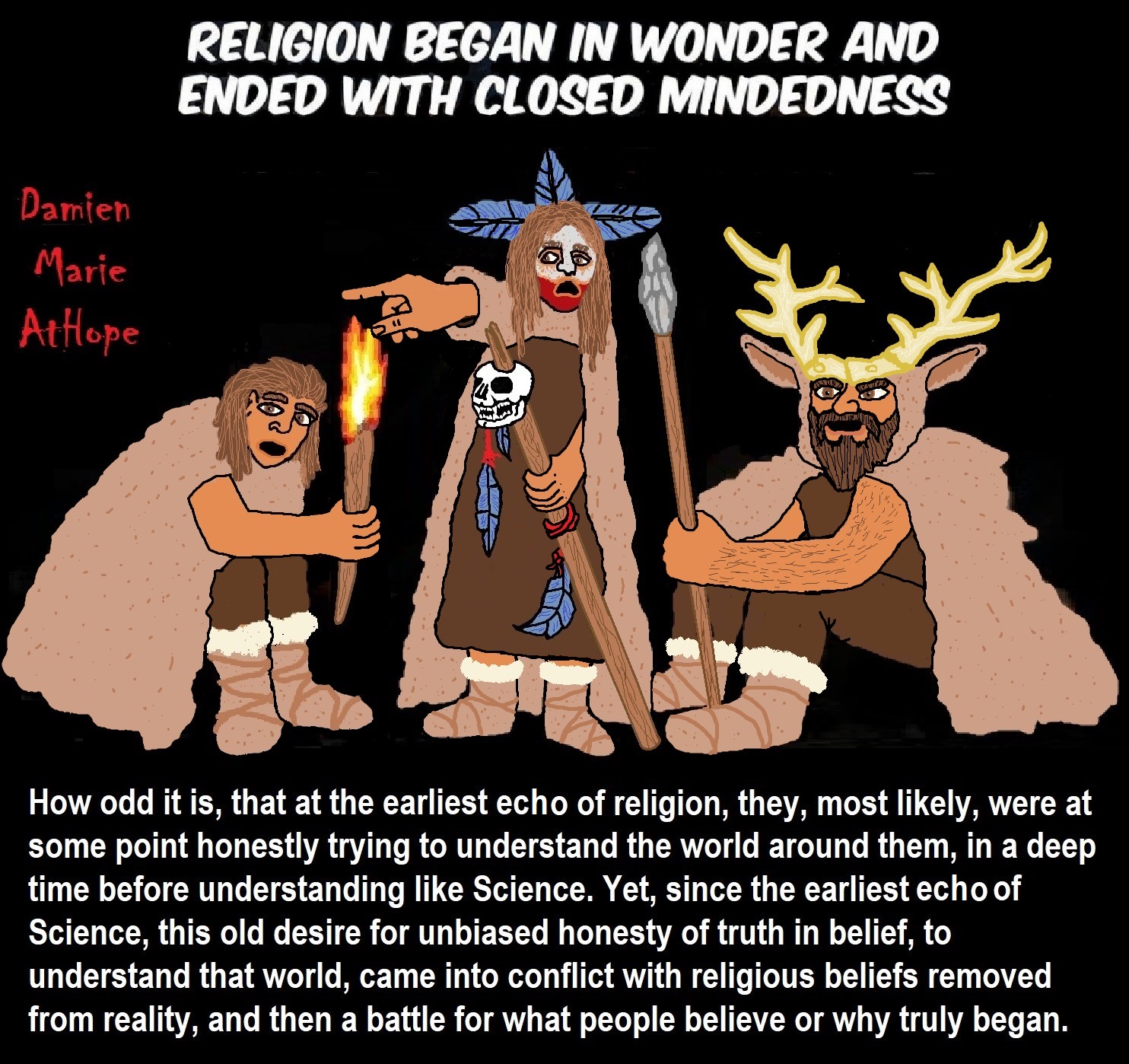
We are like believing machines we vacuum up ideas, like Velcro sticks to almost everything. We accumulate beliefs that we allow to negatively influence our lives, often without realizing it. Our willingness must be to alter skewed beliefs that impend our balance or reason, which allows us to achieve new positive thinking and accurate outcomes.
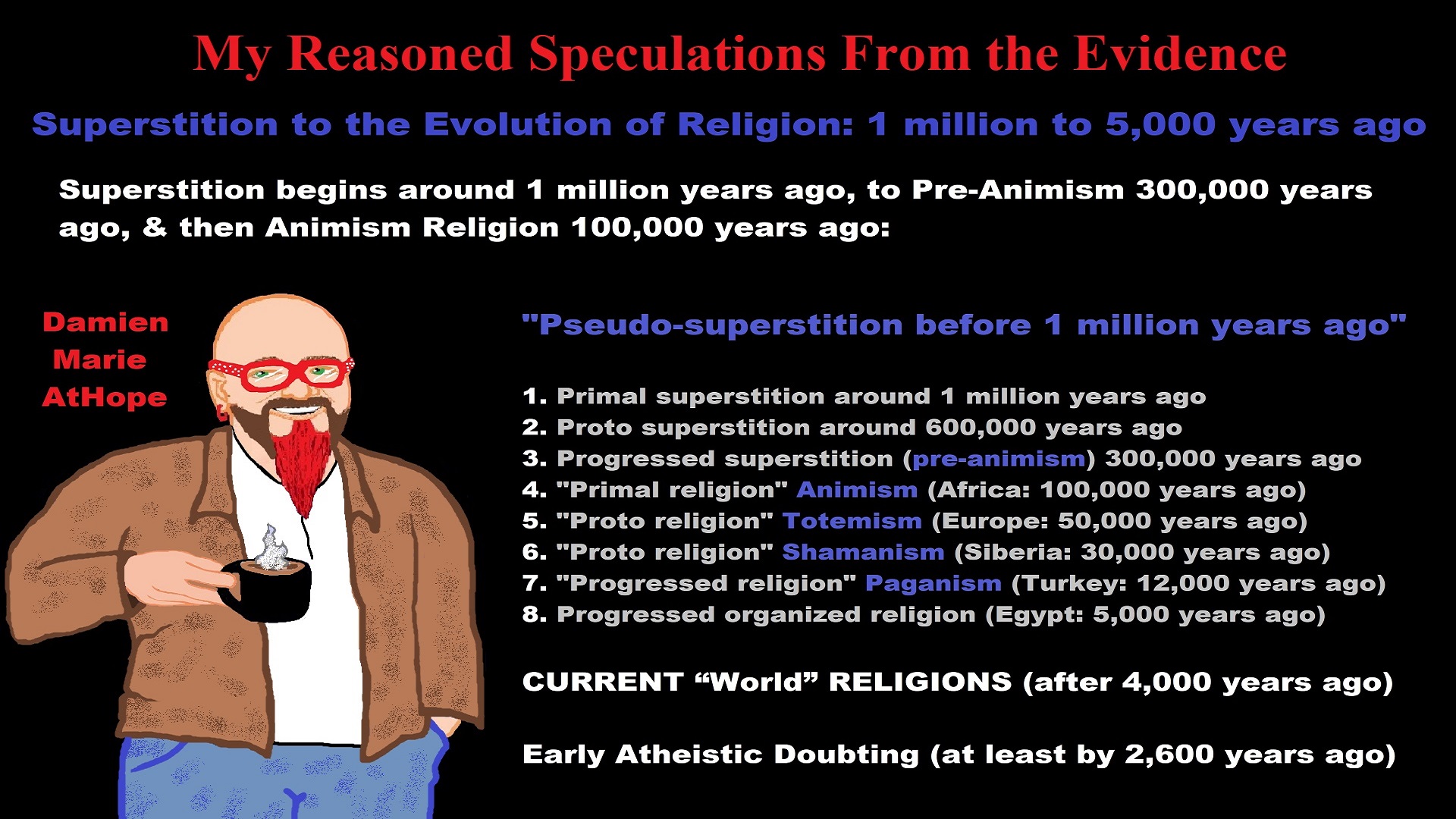
My thoughts on Religion Evolution with external links for more info:
- (Pre-Animism Africa mainly, but also Europe, and Asia at least 300,000 years ago), (Pre-Animism – Oxford Dictionaries)
- (Animism Africa around 100,000 years ago), (Animism – Britannica.com)
- (Totemism Europe around 50,000 years ago), (Totemism – Anthropology)
- (Shamanism Siberia around 30,000 years ago), (Shamanism – Britannica.com)
- (Paganism Turkey around 12,000 years ago), (Paganism – BBC Religion)
- (Progressed Organized Religion “Institutional Religion” Egypt around 5,000 years ago), (Ancient Egyptian Religion – Britannica.com)
- (CURRENT “World” RELIGIONS after 4,000 years ago) (Origin of Major Religions – Sacred Texts)
- (Early Atheistic Doubting at least by 2,600 years ago) (History of Atheism – Wikipedia)
“Religion is an Evolved Product” and Yes, Religion is Like Fear Given Wings…
Atheists talk about gods and religions for the same reason doctors talk about cancer, they are looking for a cure, or a firefighter talks about fires because they burn people and they care to stop them. We atheists too often feel a need to help the victims of mental slavery, held in the bondage that is the false beliefs of gods and the conspiracy theories of reality found in religions.
Understanding Religion Evolution:
- Pre-Animism (at least 300,000 years ago)
- Animism (Africa: 100,000 years ago)
- Totemism (Europe: 50,000 years ago)
- Shamanism (Siberia: 30,000 years ago)
- Paganism (Turkey: 12,000 years ago)
- Progressed organized religion (Egypt: 5,000 years ago), (Egypt, the First Dynasty 5,150 years ago)
- CURRENT “World” RELIGIONS (after 4,000 years ago)
- Early Atheistic Doubting (at least by 2,600 years ago)
“An Archaeological/Anthropological Understanding of Religion Evolution”
It seems ancient peoples had to survived amazing threats in a “dangerous universe (by superstition perceived as good and evil),” and human “immorality or imperfection of the soul” which was thought to affect the still living, leading to ancestor worship. This ancestor worship presumably led to the belief in supernatural beings, and then some of these were turned into the belief in gods. This feeble myth called gods were just a human conceived “made from nothing into something over and over, changing, again and again, taking on more as they evolve, all the while they are thought to be special,” but it is just supernatural animistic spirit-belief perceived as sacred.
Quick Evolution of Religion?
Pre-Animism (at least 300,000 years ago) pre-religion is a beginning that evolves into later Animism. So, Religion as we think of it, to me, all starts in a general way with Animism (Africa: 100,000 years ago) (theoretical belief in supernatural powers/spirits), then this is physically expressed in or with Totemism (Europe: 50,000 years ago) (theoretical belief in mythical relationship with powers/spirits through a totem item), which then enlists a full-time specific person to do this worship and believed interacting Shamanism (Siberia/Russia: 30,000 years ago) (theoretical belief in access and influence with spirits through ritual), and then there is the further employment of myths and gods added to all the above giving you Paganism (Turkey: 12,000 years ago) (often a lot more nature-based than most current top world religions, thus hinting to their close link to more ancient religious thinking it stems from). My hypothesis is expressed with an explanation of the building of a theatrical house (modern religions development). Progressed organized religion (Egypt: 5,000 years ago) with CURRENT “World” RELIGIONS (after 4,000 years ago).
Historically, in large city-state societies (such as Egypt or Iraq) starting around 5,000 years ago culminated to make religion something kind of new, a sociocultural-governmental-religious monarchy, where all or at least many of the people of such large city-state societies seem familiar with and committed to the existence of “religion” as the integrated life identity package of control dynamics with a fixed closed magical doctrine, but this juggernaut integrated religion identity package of Dogmatic-Propaganda certainly did not exist or if developed to an extent it was highly limited in most smaller prehistoric societies as they seem to lack most of the strong control dynamics with a fixed closed magical doctrine (magical beliefs could be at times be added or removed). Many people just want to see developed religious dynamics everywhere even if it is not. Instead, all that is found is largely fragments until the domestication of religion.
Religions, as we think of them today, are a new fad, even if they go back to around 6,000 years in the timeline of human existence, this amounts to almost nothing when seen in the long slow evolution of religion at least around 70,000 years ago with one of the oldest ritual worship. Stone Snake of South Africa: “first human worship” 70,000 years ago. This message of how religion and gods among them are clearly a man-made thing that was developed slowly as it was invented and then implemented peace by peace discrediting them all. Which seems to be a simple point some are just not grasping how devastating to any claims of truth when we can see the lie clearly in the archeological sites.
I wish people fought as hard for the actual values as they fight for the group/clan names political or otherwise they think support values. Every amount spent on war is theft to children in need of food or the homeless kept from shelter.
Here are several of my blog posts on history:
- To Find Truth You Must First Look
- (Magdalenian/Iberomaurusian) Connections to the First Paganists of the early Neolithic Near East Dating from around 17,000 to 12,000 Years Ago
- Natufians: an Ancient People at the Origins of Agriculture and Sedentary Life
- Possible Clan Leader/Special “MALE” Ancestor Totem Poles At Least 13,500 years ago?
- Jewish People with DNA at least 13,200 years old, Judaism, and the Origins of Some of its Ideas
- Baltic Reindeer Hunters: Swiderian, Lyngby, Ahrensburgian, and Krasnosillya cultures 12,020 to 11,020 years ago are evidence of powerful migratory waves during the last 13,000 years and a genetic link to Saami and the Finno-Ugric peoples.
- The Rise of Inequality: patriarchy and state hierarchy inequality
- Fertile Crescent 12,500 – 9,500 Years Ago: fertility and death cult belief system?
- 12,400 – 11,700 Years Ago – Kortik Tepe (Turkey) Pre/early-Agriculture Cultic Ritualism
- Ritualistic Bird Symbolism at Gobekli Tepe and its “Ancestor Cult”
- Male-Homosexual (female-like) / Trans-woman (female) Seated Figurine from Gobekli Tepe
- Could a 12,000-year-old Bull Geoglyph at Göbekli Tepe relate to older Bull and Female Art 25,000 years ago and Later Goddess and the Bull cults like Catal Huyuk?
- Sedentism and the Creation of goddesses around 12,000 years ago as well as male gods after 7,000 years ago.
- Alcohol, where Agriculture and Religion Become one? Such as Gobekli Tepe’s Ritualistic use of Grain as Food and Ritual Drink
- Neolithic Ritual Sites with T-Pillars and other Cultic Pillars
- Paganism: Goddesses around 12,000 years ago then Male Gods after 7,000 years ago
- First Patriarchy: Split of Women’s Status around 12,000 years ago & First Hierarchy: fall of Women’s Status around 5,000 years ago.
- Natufians: an Ancient People at the Origins of Agriculture and Sedentary Life
- J DNA and the Spread of Agricultural Religion (paganism)
- Paganism: an approximately 12,000-year-old belief system
- Paganism 12,000 years old: related to “Anarchism and Socialism” (Pre-Capitalism)
- Shaman burial in Israel 12,000 years ago and the Shamanism Phenomena
- Need to Mythicized: gods and goddesses
- 12,000 – 7,000 Years Ago – Paleo-Indian Culture (The Americas)
- 12,000 – 2,000 Years Ago – Indigenous-Scandinavians (Nordic)
- Norse did not wear helmets with horns?
- Pre-Pottery Neolithic Skull Cult around 11,500 to 8,400 Years Ago?
- 10,400 – 10,100 Years Ago, in Turkey the Nevail Cori Religious Settlement
- 9,000-6,500 Years Old Submerged Pre-Pottery/Pottery Neolithic Ritual Settlements off Israel’s Coast
- Catal Huyuk “first religious designed city” around 9,500 to 7,700 years ago (Turkey)
- Cultic Hunting at Catal Huyuk “first religious designed city”
- Special Items and Art as well as Special Elite Burials at Catal Huyuk
- New Rituals and Violence with the appearance of Pottery and People?
- Haplogroup N and its related Uralic Languages and Cultures
- Ainu people, Sámi people, Native Americans, the Ancient North Eurasians, and Paganistic-Shamanism with Totemism
- Ideas, Technology and People from Turkey, Europe, to China and Back again 9,000 to 5,000 years ago?
- First Pottery of Europe and the Related Cultures
- 9,000 years old Neolithic Artifacts Judean Desert and Hills Israel
- 9,000-7,000 years-old Sex and Death Rituals: Cult Sites in Israel, Jordan, and the Sinai
- 9,000-8500 year old Horned Female shaman Bad Dürrenberg Germany
- Neolithic Jewelry and the Spread of Farming in Europe Emerging out of West Turkey
- 8,600-year-old Tortoise Shells in Neolithic graves in central China have Early Writing and Shamanism
- Swing of the Mace: the rise of Elite, Forced Authority, and Inequality begin to Emerge 8,500 years ago?
- Migrations and Changing Europeans Beginning around 8,000 Years Ago
- My “Steppe-Anatolian-Kurgan hypothesis” 8,000/7,000 years ago
- Around 8,000-year-old Shared Idea of the Mistress of Animals, “Ritual” Motif
- Pre-Columbian Red-Paint (red ochre) Maritime Archaic Culture 8,000-3,000 years ago
- 7,522-6,522 years ago Linear Pottery culture which I think relates to Arcane Capitalism’s origins
- Arcane Capitalism: Primitive socialism, Primitive capital, Private ownership, Means of production, Market capitalism, Class discrimination, and Petite bourgeoisie (smaller capitalists)
- 7,500-4,750 years old Ritualistic Cucuteni-Trypillian culture of Moldova, Romania, and Ukraine
- Roots of a changing early society 7,200-6,700 years ago Jordan and Israel
- Agriculture religion (Paganism) with farming reached Britain between about 7,000 to 6,500 or so years ago and seemingly expressed in things like Western Europe’s Long Barrows
- My Thoughts on Possible Migrations of “R” DNA and Proto-Indo-European?
- “Millet” Spreading from China 7,022 years ago to Europe and related Language may have Spread with it leading to Proto-Indo-European
- Proto-Indo-European (PIE), ancestor of Indo-European languages: DNA, Society, Language, and Mythology
- The Dnieper–Donets culture and Asian varieties of Millet from China to the Black Sea region of Europe by 7,022 years ago
- Kurgan 6,000 years ago/dolmens 7,000 years ago: funeral, ritual, and other?
- 7,020 to 6,020-year-old Proto-Indo-European Homeland of Urheimat or proposed home of their Language and Religion
- Ancient Megaliths: Kurgan, Ziggurat, Pyramid, Menhir, Trilithon, Dolman, Kromlech, and Kromlech of Trilithons
- The Mytheme of Ancient North Eurasian Sacred-Dog belief and similar motifs are found in Indo-European, Native American, and Siberian comparative mythology
- Elite Power Accumulation: Ancient Trade, Tokens, Writing, Wealth, Merchants, and Priest-Kings
- Sacred Mounds, Mountains, Kurgans, and Pyramids may hold deep connections?
- Between 7,000-5,000 Years ago, rise of unequal hierarchy elite, leading to a “birth of the State” or worship of power, strong new sexism, oppression of non-elites, and the fall of Women’s equal status
- Paganism 7,000-5,000 years old: related to “Anarchism and Socialism” (Capitalism) (World War 0) Elite & their slaves
- Hell and Underworld mythologies starting maybe as far back as 7,000 to 5,000 years ago with the Proto-Indo-Europeans?
- The First Expression of the Male God around 7,000 years ago?
- White (light complexion skin) Bigotry and Sexism started 7,000 years ago?
- Around 7,000-year-old Shared Idea of the Divine Bird (Tutelary and/or Trickster spirit/deity), “Ritual” Motif
- Nekhbet an Ancient Egyptian Vulture Goddess and Tutelary Deity
- 6,720 to 4,920 years old Ritualistic Hongshan Culture of Inner Mongolia with 5,000-year-old Pyramid Mounds and Temples
- First proto-king in the Balkans, Varna culture around 6,500 years ago?
- 6,500–5,800 years ago in Israel Late Chalcolithic (Copper Age) Period in the Southern Levant Seems to Express Northern Levant Migrations, Cultural and Religious Transfer
- KING OF BEASTS: Master of Animals “Ritual” Motif, around 6,000 years old or older…
- Around 6000-year-old Shared Idea of the Solid Wheel & the Spoked Wheel-Shaped Ritual Motif
- “The Ghassulian Star,” a mysterious 6,000-year-old mural from Jordan; a Proto-Star of Ishtar, Star of Inanna or Star of Venus?
- Religious/Ritual Ideas, including goddesses and gods as well as ritual mounds or pyramids from Northeastern Asia at least 6,000 years old, seemingly filtering to Iran, Iraq, the Mediterranean, Europe, Egypt, and the Americas?
- Maykop (5,720–5,020 years ago) Caucasus region Bronze Age culture-related to Copper Age farmers from the south, influenced by the Ubaid period and Leyla-Tepe culture, as well as influencing the Kura-Araxes culture
- 5-600-year-old Tomb, Mummy, and First Bearded Male Figurine in a Grave
- Kura-Araxes Cultural 5,520 to 4,470 years old DNA traces to the Canaanites, Arabs, and Jews
- Minoan/Cretan (Keftiu) Civilization and Religion around 5,520 to 3,120 years ago
- Evolution Of Science at least by 5,500 years ago
- 5,500 Years old birth of the State, the rise of Hierarchy, and the fall of Women’s status
- “Jiroft culture” 5,100 – 4,200 years ago and the History of Iran
- Stonehenge: Paganistic Burial and Astrological Ritual Complex, England (5,100-3,600 years ago)
- Around 5,000-year-old Shared Idea of the “Tree of Life” Ritual Motif
- Complex rituals for elite, seen from China to Egypt, at least by 5,000 years ago
- Around 5,000 years ago: “Birth of the State” where Religion gets Military Power and Influence
- The Center of the World “Axis Mundi” and/or “Sacred Mountains” Mythology Could Relate to the Altai Mountains, Heart of the Steppe
- Progressed organized religion starts, an approximately 5,000-year-old belief system
- China’s Civilization between 5,000-3,000 years ago, was a time of war and class struggle, violent transition from free clans to a Slave or Elite society
- Origin of Logics is Naturalistic Observation at least by around 5,000 years ago.
- Paganism 5,000 years old: progressed organized religion and the state: related to “Anarchism and Socialism” (Kings and the Rise of the State)
- Ziggurats (multi-platform temples: 4,900 years old) to Pyramids (multi-platform tombs: 4,700 years old)
- Did a 4,520–4,420-year-old Volcano In Turkey Inspire the Bible God?
- Finland’s Horned Shaman and Pre-Horned-God at least 4,500 years ago?
- 4,000-year-Old Dolmens in Israel: A Connected Dolmen Religious Phenomenon?
- Creation myths: From chaos, Ex nihilo, Earth-diver, Emergence, World egg, and World parent
- Bronze Age “Ritual” connections of the Bell Beaker culture with the Corded Ware/Single Grave culture, which were related to the Yamnaya culture and Proto-Indo-European Languages/Religions
- Low Gods (Earth/ Tutelary deity), High Gods (Sky/Supreme deity), and Moralistic Gods (Deity enforcement/divine order)
- The exchange of people, ideas, and material-culture including, to me, the new god (Sky Father) and goddess (Earth Mother) religion between the Cucuteni-Trypillians and others which is then spread far and wide
- Koryaks: Indigenous People of the Russian Far East and Big Raven myths also found in Tlingit, Haida, Tsimshian, and other Indigenous People of North America
- 42 Principles Of Maat (Egyptian Goddess of the justice) around 4,400 years ago, 2000 Years Before Ten Commandments
- “Happy Easter” Well Happy Eostre/Ishter
- 4,320-3,820 years old “Shimao” (North China) site with Totemistic-Shamanistic Paganism and a Stepped Pyramid
- 4,250 to 3,400 Year old Stonehenge from Russia: Arkaim?
- 4,100-year-old beaker with medicinal & flowering plants in a grave of a woman in Scotland
- Early European Farmer ancestry, Kelif el Boroud people with the Cardial Ware culture, and the Bell Beaker culture Paganists too, spread into North Africa, then to the Canary Islands off West Africa
- Flood Accounts: Gilgamesh epic (4,100 years ago) Noah in Genesis (2,600 years ago)
- Paganism 4,000 years old: related to “Anarchism and Socialism” (First Moralistic gods, then the Origin time of Monotheism)
- When was the beginning: TIMELINE OF CURRENT RELIGIONS, which start around 4,000 years ago.
- Early Religions Thought to Express Proto-Monotheistic Systems around 4,000 years ago
- Kultepe? An archaeological site with a 4,000 years old women’s rights document.
- Single God Religions (Monotheism) = “Man-o-theism” started around 4,000 years ago with the Great Sky Spirit/God Tiān (天)?
- Confucianism’s Tiān (Shangdi god 4,000 years old): Supernaturalism, Pantheism or Theism?
- Yes, Your Male God is Ridiculous
- Mythology, a Lunar Deity is a Goddess or God of the Moon
- Sacred Land, Hills, and Mountains: Sami Mythology (Paganistic Shamanism)
- Horse Worship/Sacrifice: mythical union of Ruling Elite/Kingship and the Horse
- The Amorite/Amurru people’s God Amurru “Lord of the Steppe”, relates to the Origins of the Bible God?
- Bronze Age Exotic Trade Routes Spread Quite Far as well as Spread Religious Ideas with Them
- Sami and the Northern Indigenous Peoples Landscape, Language, and its Connection to Religion
- Prototype of Ancient Analemmatic Sundials around 3,900-3,150 years ago and a Possible Solar Connection to gods?
- Judaism is around 3,450 or 3,250 years old. (“Paleo-Hebrew” 3,000 years ago and Torah 2,500 years ago)
- The Weakening of Ancient Trade and the Strengthening of Religions around 3000 years ago?
- Are you aware that there are religions that worship women gods, explain now religion tears women down?
- Animistic, Totemistic, and Paganistic Superstition Origins of bible god and the bible’s Religion.
- Myths and Folklore: “Trickster gods and goddesses”
- Jews, Judaism, and the Origins of Some of its Ideas
- An Old Branch of Religion Still Giving Fruit: Sacred Trees
- Dating the BIBLE: naming names and telling times (written less than 3,000 years ago, provable to 2,200 years ago)
- Did a Volcano Inspire the bible god?
- The Amorite/Amurru people’s God Amurru “Lord of the Steppe”, relates to the Origins of the Bible God?
- Dené–Yeniseian language, Old Copper Complex, and Pre-Columbian Mound Builders?
- No “dinosaurs and humans didn’t exist together just because some think they are in the bible itself”
- Sacred Shit and Sacred Animals?
- Everyone Killed in the Bible Flood? “Nephilim” (giants)?
- Hey, Damien dude, I have a question for you regarding “the bible” Exodus.
- Archaeology Disproves the Bible
- Bible Battle, Just More, Bible Babble
- The Jericho Conquest lie?
- Canaanites and Israelites?
- Accurate Account on how did Christianity Began?
- Let’s talk about Christianity.
- So the 10 commandments isn’t anything to go by either right?
- Misinformed christian
- Debunking Jesus?
- Paulism vs Jesus
- Ok, you seem confused so let’s talk about Buddhism.
- Unacknowledged Buddhism: Gods, Savior, Demons, Rebirth, Heavens, Hells, and Terrorism
- His Foolishness The Dalai Lama
- Yin and Yang is sexist with an ORIGIN around 2,300 years ago?
- I Believe Archaeology, not Myths & Why Not, as the Religious Myths Already Violate Reason!
- Archaeological, Scientific, & Philosophic evidence shows the god myth is man-made nonsense.
- Aquatic Ape Theory/Hypothesis? As Always, Just Pseudoscience.
- Ancient Aliens Conspiracy Theorists are Pseudohistorians
- The Pseudohistoric and Pseudoscientific claims about “Bakoni Ruins” of South Africa
- Why do people think Religion is much more than supernaturalism and superstitionism?
- Religion is an Evolved Product
- Was the Value of Ancient Women Different?
- 1000 to 1100 CE, human sacrifice Cahokia Mounds a pre-Columbian Native American site
- Feminist atheists as far back as the 1800s?
- Promoting Religion as Real is Mentally Harmful to a Flourishing Humanity
- Screw All Religions and Their Toxic lies, they are all fraud
- Forget Religions’ Unfounded Myths, I Have Substantiated “Archaeology Facts.”
- Religion Dispersal throughout the World
- I Hate Religion Just as I Hate all Pseudoscience
- Exposing Scientology, Eckankar, Wicca and Other Nonsense?
- Main deity or religious belief systems
- Quit Trying to Invent Your God From the Scraps of Science.
- Archaeological, Scientific, & Philosophic evidence shows the god myth is man-made nonsense.
- Ancient Alien Conspiracy Theorists: Misunderstanding, Rhetoric, Misinformation, Fabrications, and Lies
- Misinformation, Distortion, and Pseudoscience in Talking with a Christian Creationist
- Judging the Lack of Goodness in Gods, Even the Norse God Odin
- Challenging the Belief in God-like Aliens and Gods in General
- A Challenge to Christian use of Torture Devices?
- Yes, Hinduism is a Religion
- Trump is One of the Most Reactionary Forces of Far-right Christian Extremism
- Was the Bull Head a Symbol of God? Yes!
- Primate Death Rituals
- Christian – “God and Christianity are objectively true”
- Australopithecus afarensis Death Ritual?
- You Claim Global Warming is a Hoax?
- Doubter of Science and Defamer of Atheists?
- I think that sounds like the Bible?
- History of the Antifa (“anti-fascist”) Movements
- Indianapolis Anti-Blasphemy Laws #Free Soheil Rally
- Damien, you repeat the golden rule in so many forms then you say religion is dogmatic?
- Science is a Trustable Methodology whereas Faith is not Trustable at all!
- Was I ever a believer, before I was an atheist?
- Atheists rise in reason
- Mistrust of science?
- Open to Talking About the Definition of ‘God’? But first, we address Faith.
- ‘United Monarchy’ full of splendor and power – Saul, David, and Solomon? Most likely not.
- Is there EXODUS ARCHAEOLOGY? The short answer is “no.”
- Lacking Proof of Bigfoots, Unicorns, and Gods is Just a Lack of Research?
- Religion and Politics: Faith Beliefs vs. Rational Thinking
- Hammer of Truth that lying pig RELIGION: challenged by an archaeologist
- “The Hammer of Truth” -ontology question- What do You Mean by That?
- Navigation of a bad argument: Ad Hominem vs. Attack
- Why is it Often Claimed that Gods have a Gender?
- Why are basically all monotheistic religions ones that have a male god?
- Shifting through the Claims in support of Faith
- Dear Mr. AtHope, The 20th Century is an Indictment of Secularism and a Failed Atheist Century
- An Understanding of the Worldwide Statistics and Dynamics of Terrorist Incidents and Suicide Attacks
- Intoxication and Evolution? Addressing and Assessing the “Stoned Ape” or “Drunken Monkey” Theories as Catalysts in Human Evolution
- Sacred Menstrual cloth? Inanna’s knot, Isis knot, and maybe Ma’at’s feather?
- Damien, why don’t the Hebrews accept the bible stories?
- Dealing with a Troll and Arguing Over Word Meaning
- Knowledge without Belief? Justified beliefs or disbeliefs worthy of Knowledge?
- Afrocentrism and African Religions
- Crecganford @crecganford offers history & stories of the people, places, gods, & culture
- Empiricism-Denier?
I am not an academic. I am a revolutionary that teaches in public, in places like social media, and in the streets. I am not a leader by some title given but from my commanding leadership style of simply to start teaching everywhere to everyone, all manner of positive education.
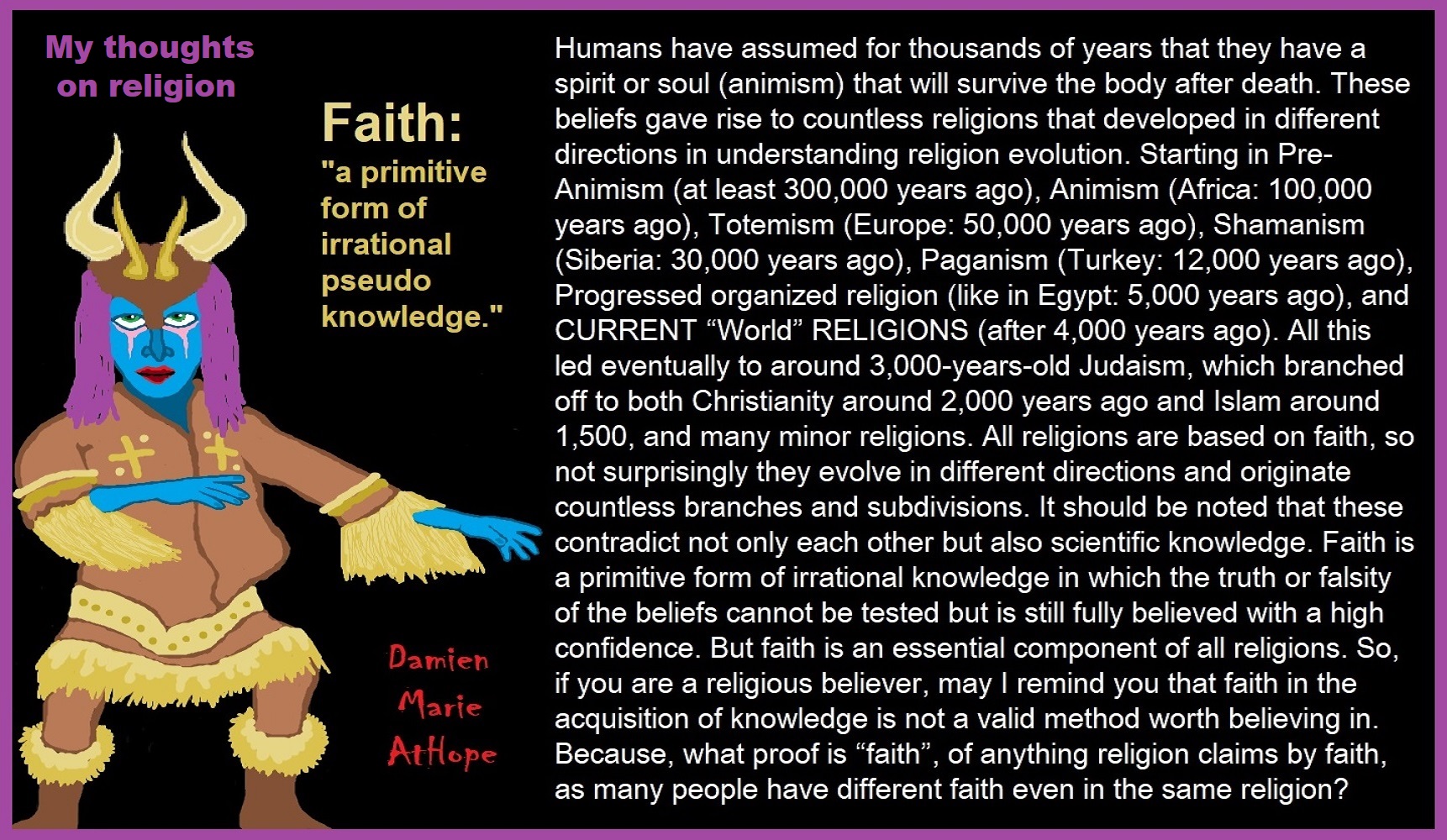
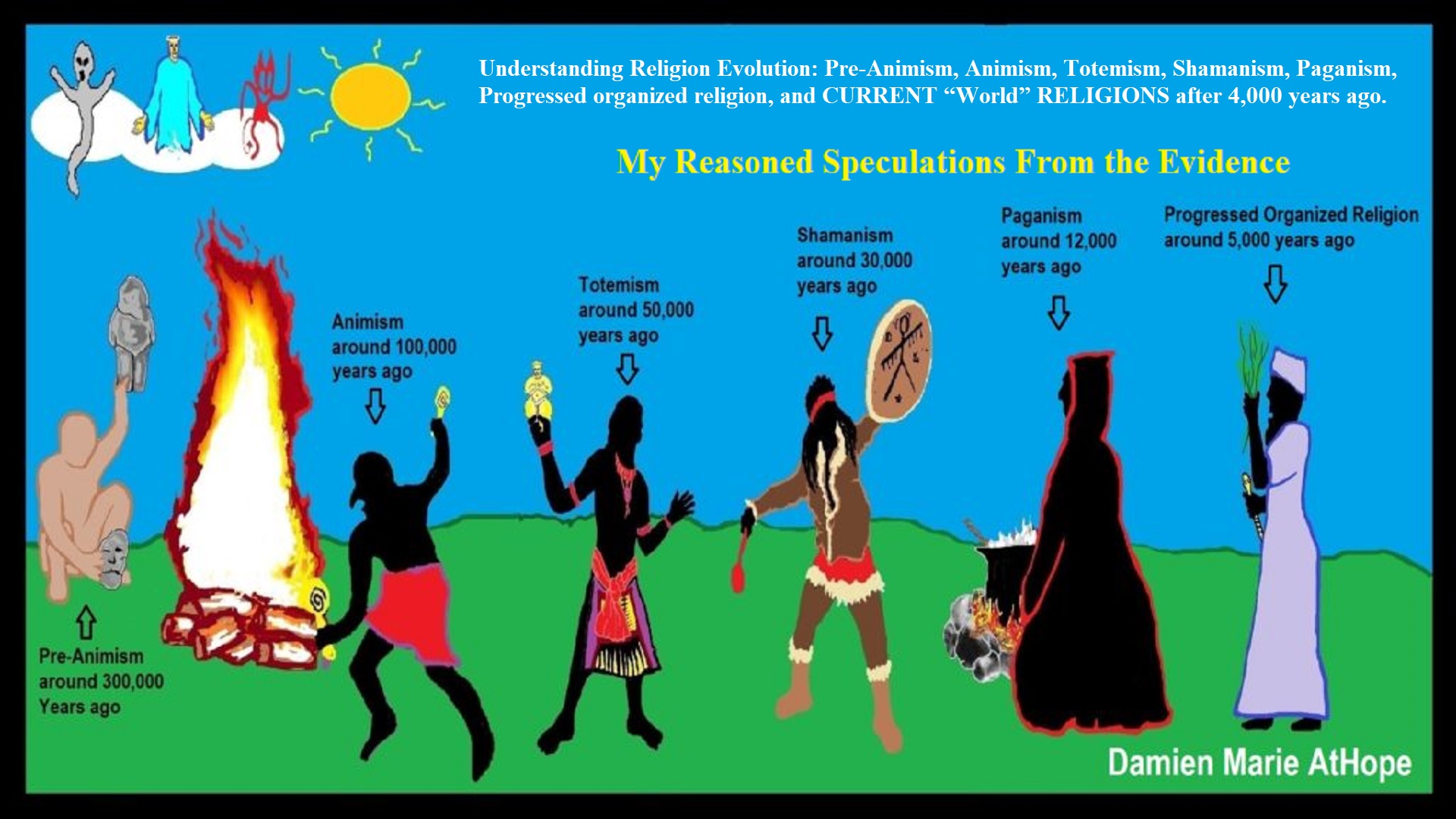
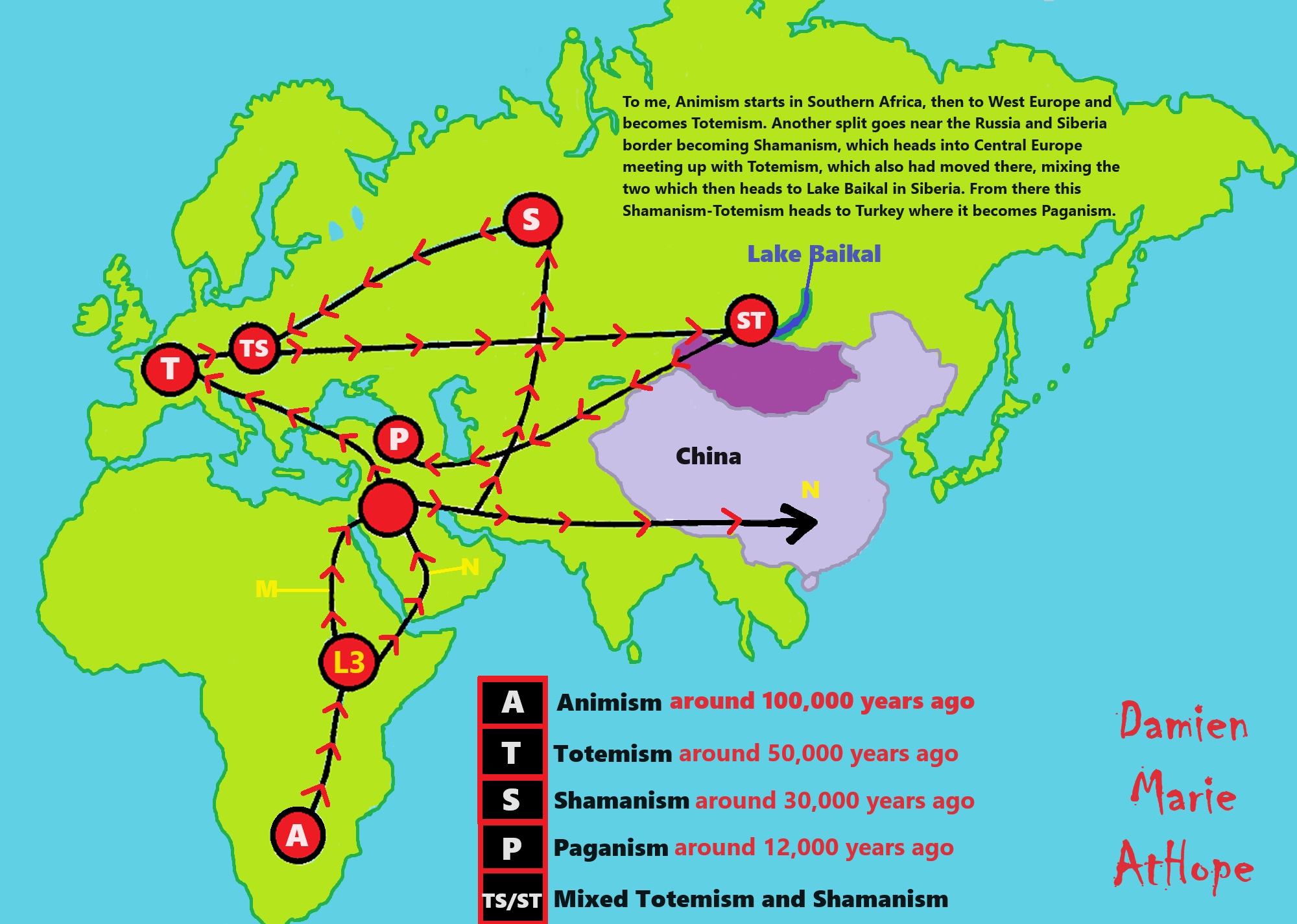
To me, Animism starts in Southern Africa, then to West Europe, and becomes Totemism. Another split goes near the Russia and Siberia border becoming Shamanism, which heads into Central Europe meeting up with Totemism, which also had moved there, mixing the two which then heads to Lake Baikal in Siberia. From there this Shamanism-Totemism heads to Turkey where it becomes Paganism.
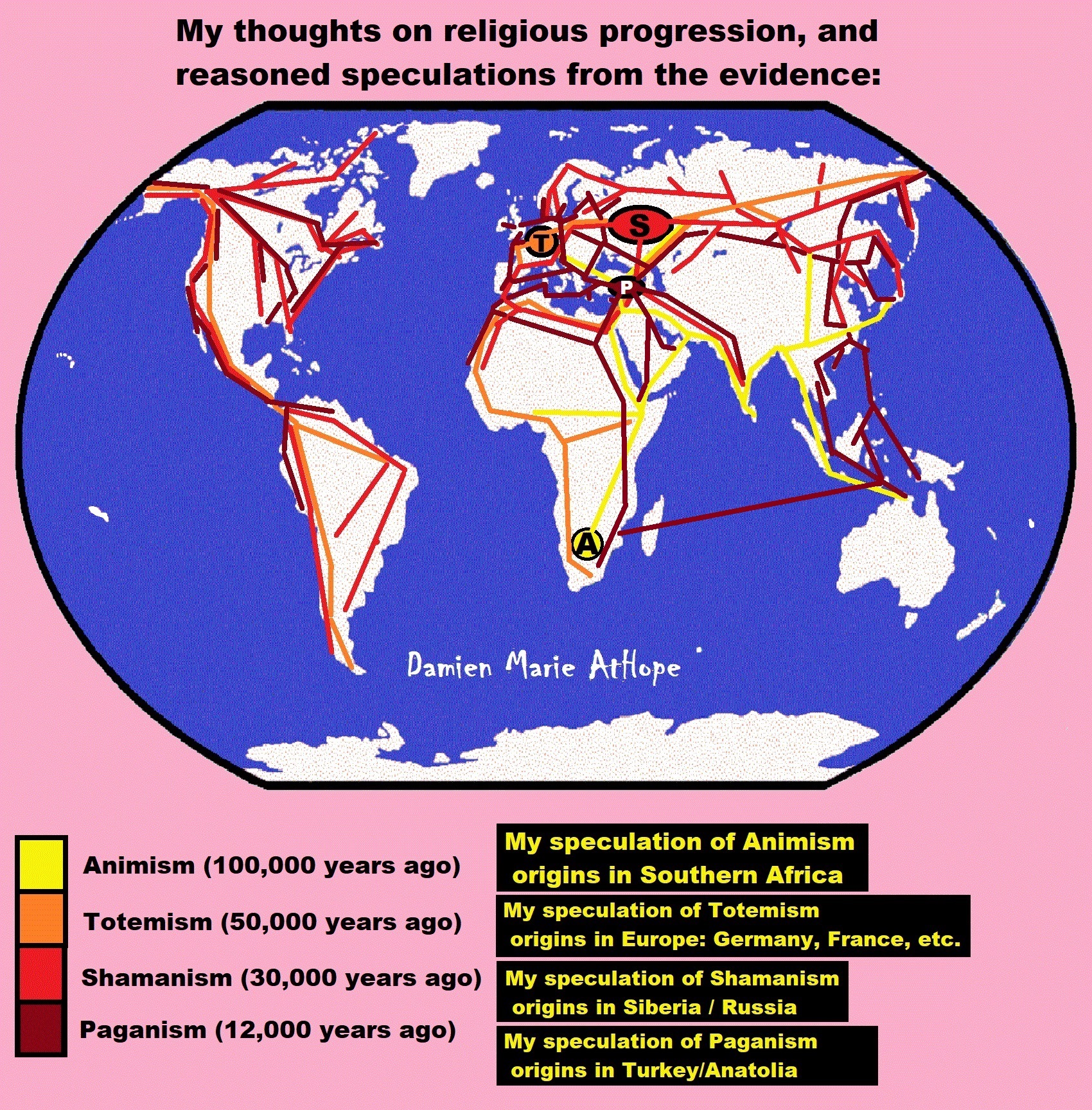
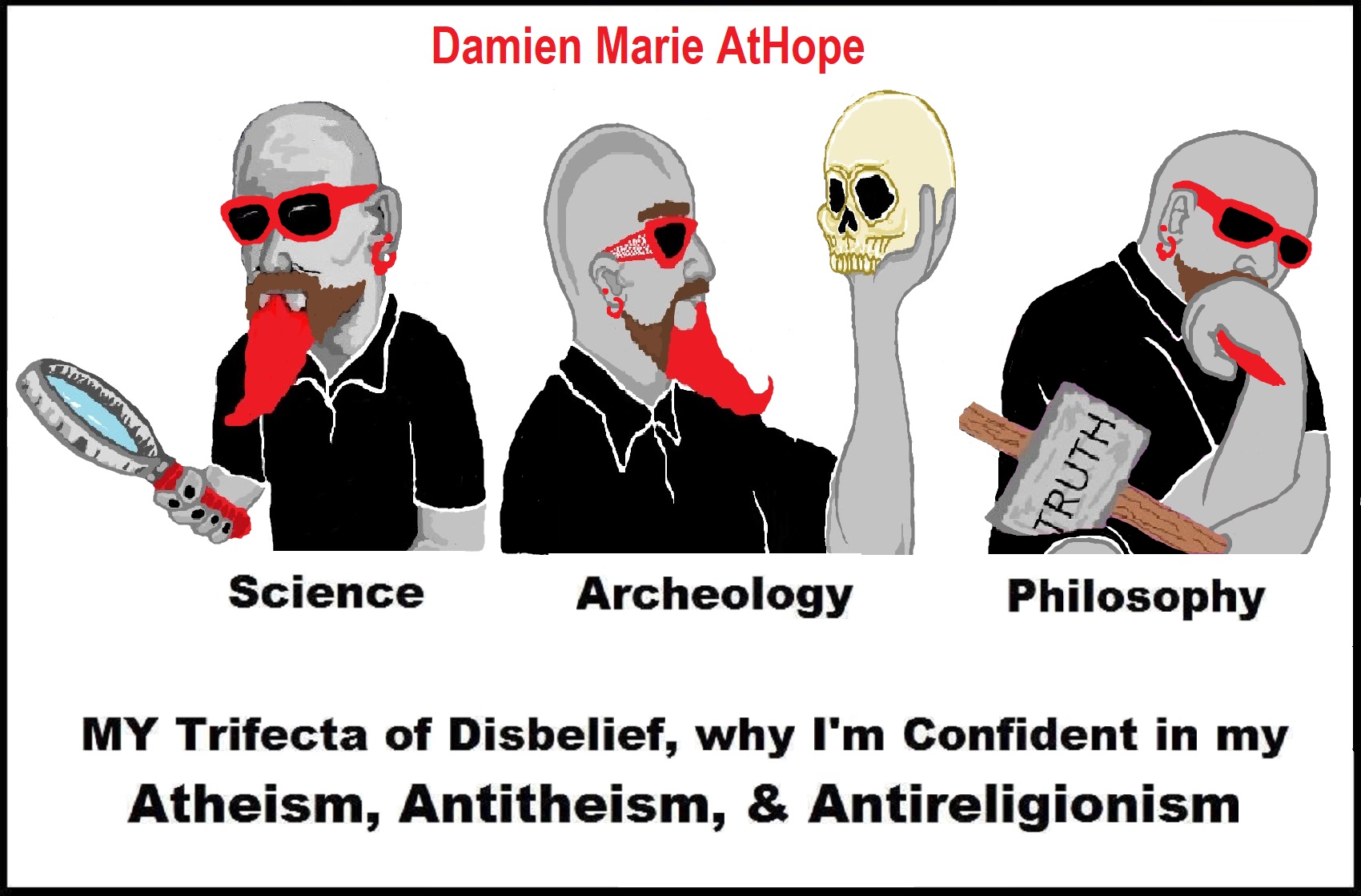
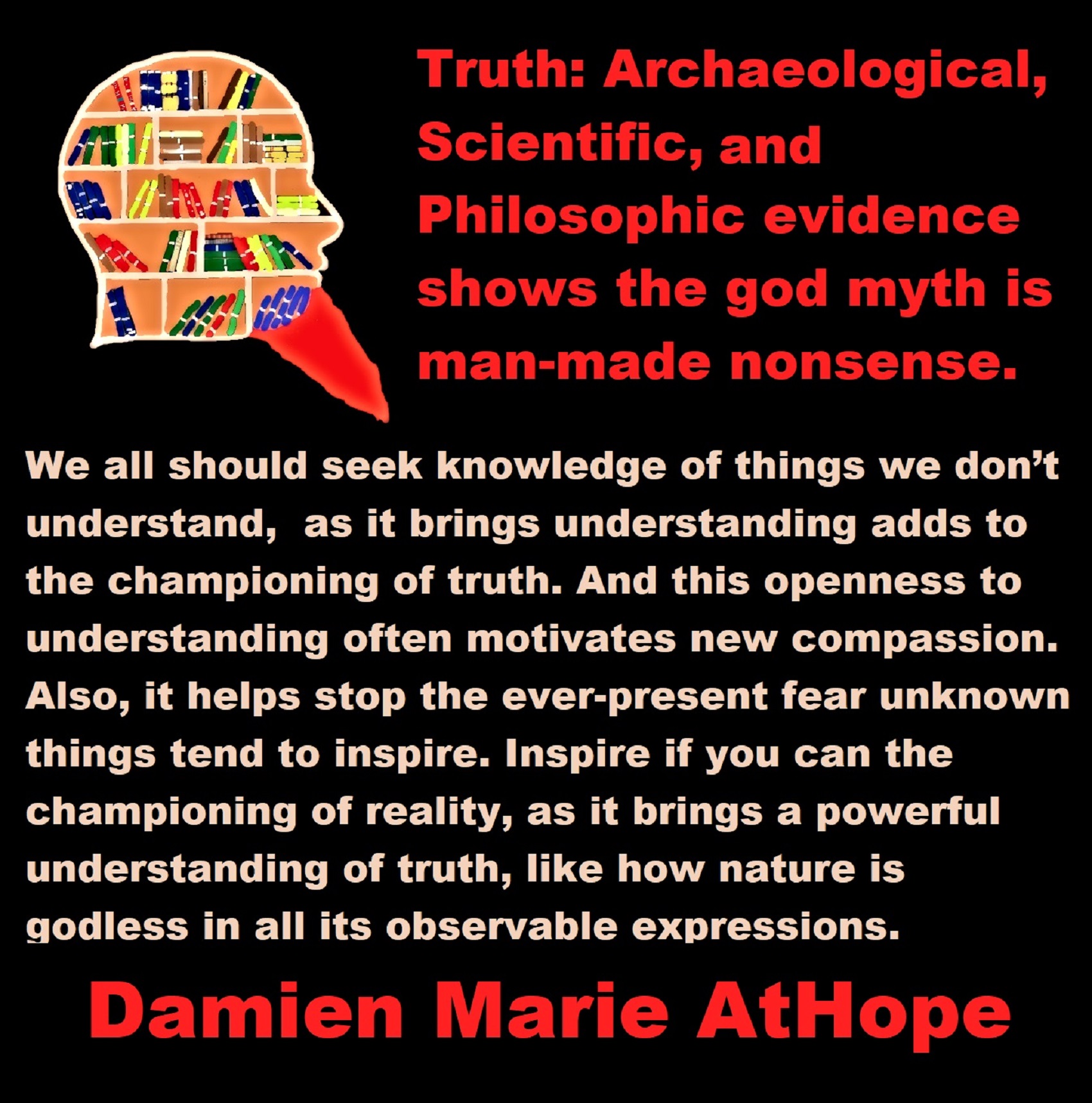
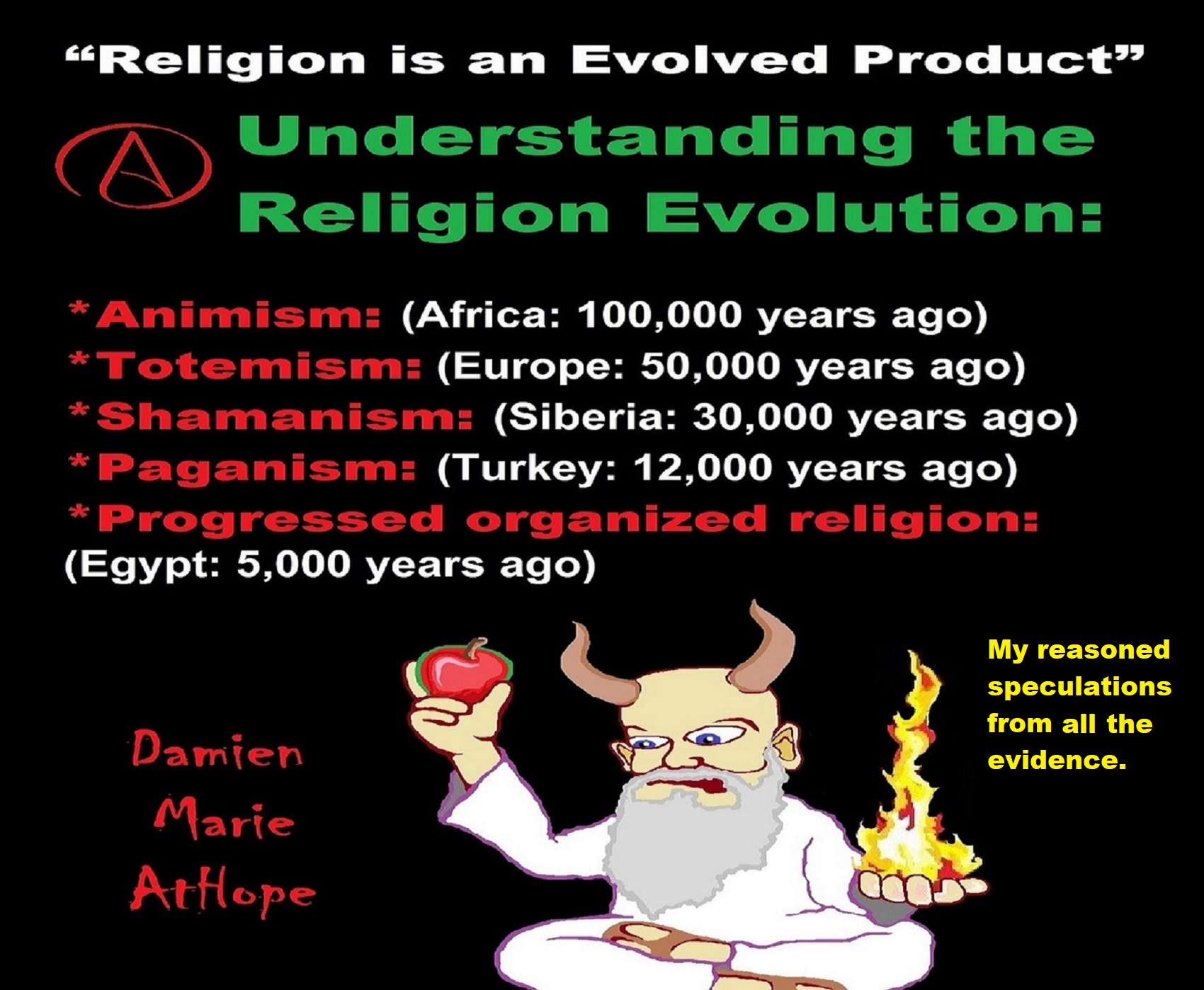
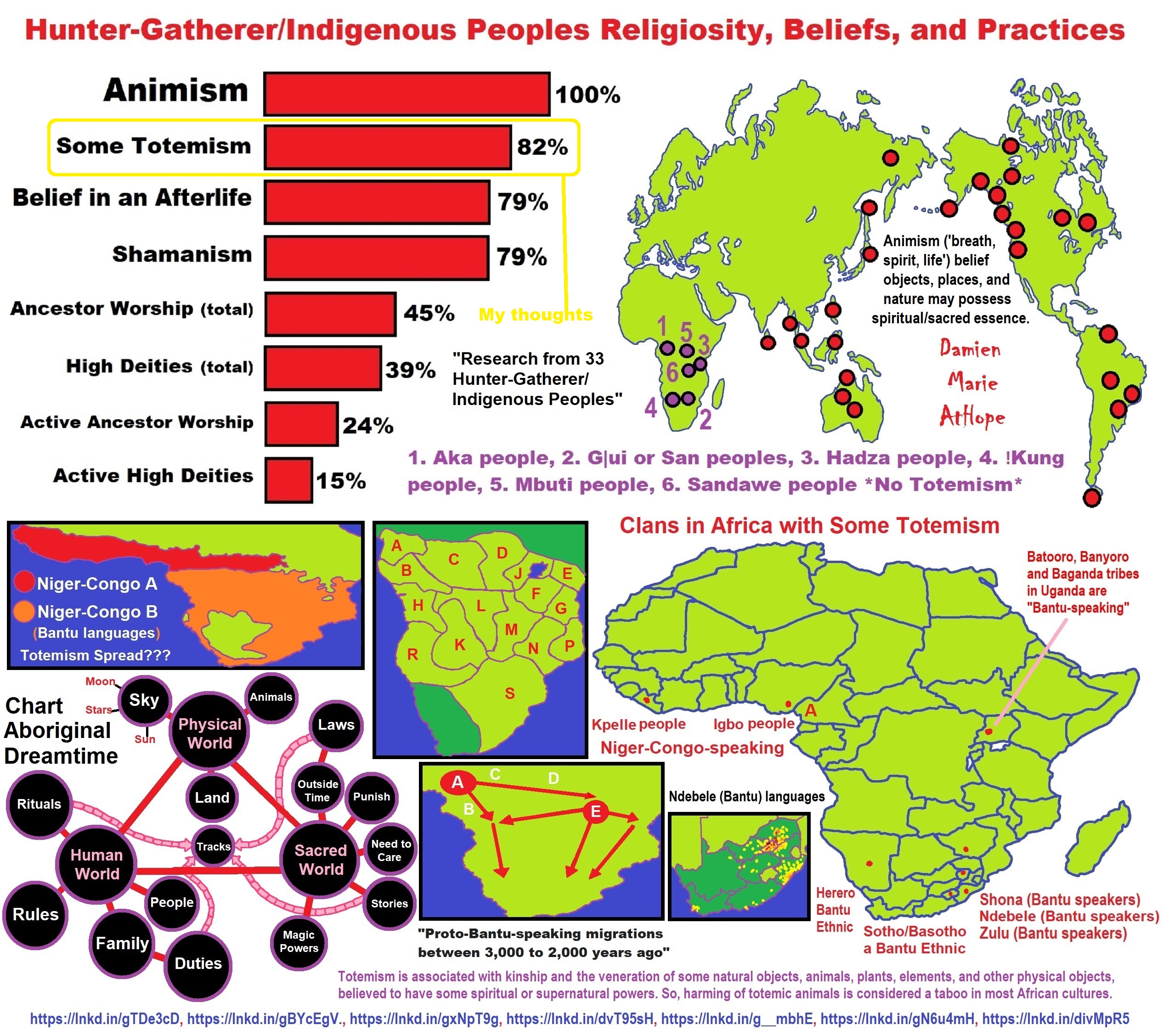
Not all “Religions” or “Religious Persuasions” have a god(s) but
All can be said to believe in some imaginary beings or imaginary things like spirits, afterlives, etc.
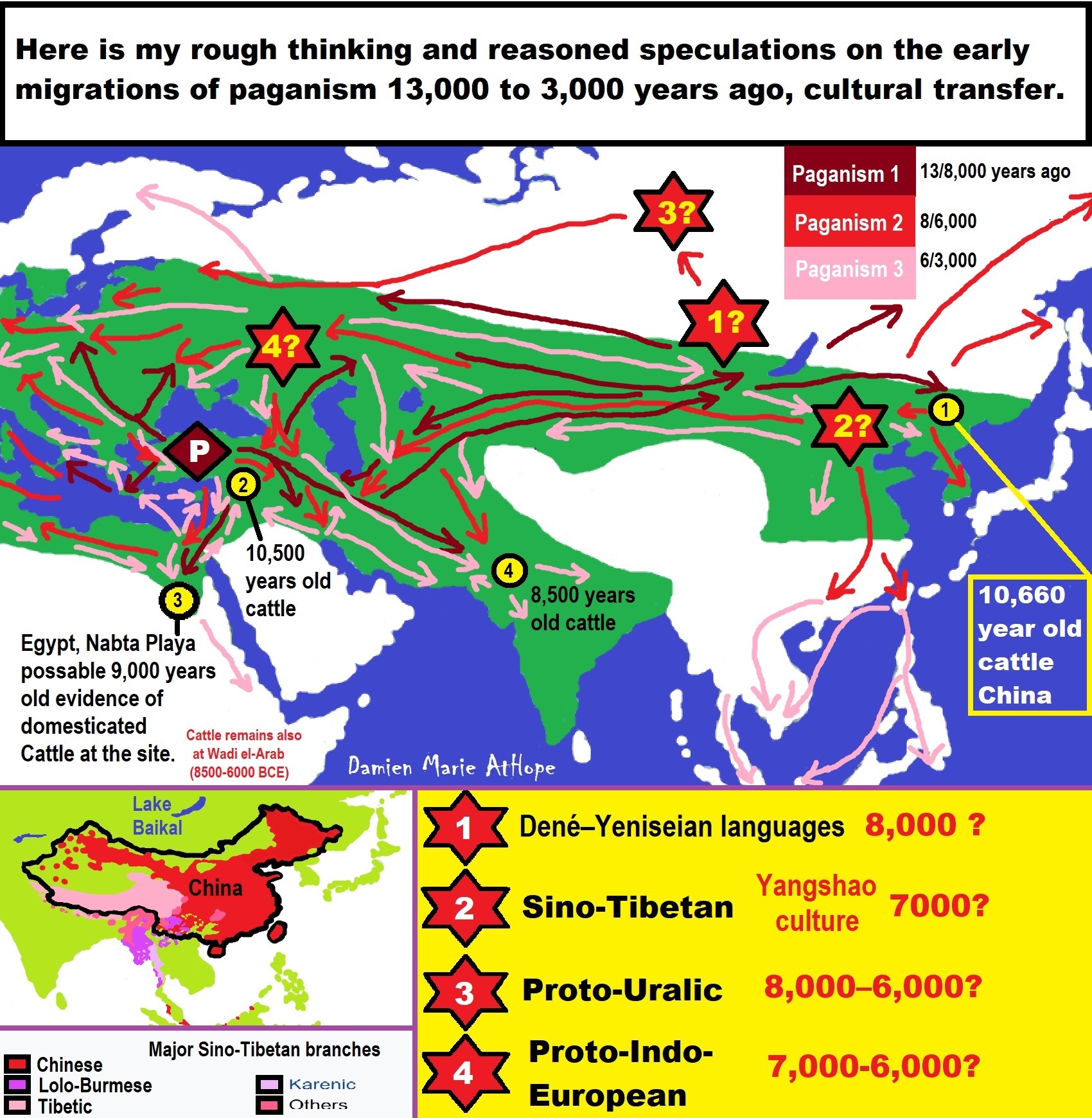
Paganism 12,000-4,000 years old
12,000-7,000 years old: related to (Pre-Capitalism)
7,000-5,000 years old: related to (Capitalism) (World War 0) Elite and their slaves!
5,000 years old: related to (Kings and the Rise of the State)
4,000 years old: related to (First Moralistic gods, then the Origin time of Monotheism)
ref, ref, ref, ref, ref, ref, ref, ref, ref, ref, ref, ref, ref, ref, ref, ref, ref, ref, ref, ref, ref
Low Gods “Earth” or Tutelary deity and High Gods “Sky” or Supreme deity
“An Earth goddess is a deification of the Earth. Earth goddesses are often associated with the “chthonic” deities of the underworld. Ki and Ninhursag are Mesopotamian earth goddesses. In Greek mythology, the Earth is personified as Gaia, corresponding to Roman Terra, Indic Prithvi/Bhūmi, etc. traced to an “Earth Mother” complementary to the “Sky Father” in Proto-Indo-European religion. Egyptian mythology exceptionally has a sky goddess and an Earth god.” ref
“A mother goddess is a goddess who represents or is a personification of nature, motherhood, fertility, creation, destruction or who embodies the bounty of the Earth. When equated with the Earth or the natural world, such goddesses are sometimes referred to as Mother Earth or as the Earth Mother. In some religious traditions or movements, Heavenly Mother (also referred to as Mother in Heaven or Sky Mother) is the wife or feminine counterpart of the Sky father or God the Father.” ref
“Any masculine sky god is often also king of the gods, taking the position of patriarch within a pantheon. Such king gods are collectively categorized as “sky father” deities, with a polarity between sky and earth often being expressed by pairing a “sky father” god with an “earth mother” goddess (pairings of a sky mother with an earth father are less frequent). A main sky goddess is often the queen of the gods and may be an air/sky goddess in her own right, though she usually has other functions as well with “sky” not being her main. In antiquity, several sky goddesses in ancient Egypt, Mesopotamia, and the Near East were called Queen of Heaven. Neopagans often apply it with impunity to sky goddesses from other regions who were never associated with the term historically. The sky often has important religious significance. Many religions, both polytheistic and monotheistic, have deities associated with the sky.” ref
“In comparative mythology, sky father is a term for a recurring concept in polytheistic religions of a sky god who is addressed as a “father”, often the father of a pantheon and is often either a reigning or former King of the Gods. The concept of “sky father” may also be taken to include Sun gods with similar characteristics, such as Ra. The concept is complementary to an “earth mother“. “Sky Father” is a direct translation of the Vedic Dyaus Pita, etymologically descended from the same Proto-Indo-European deity name as the Greek Zeûs Pater and Roman Jupiter and Germanic Týr, Tir or Tiwaz, all of which are reflexes of the same Proto-Indo-European deity’s name, *Dyēus Ph₂tḗr. While there are numerous parallels adduced from outside of Indo-European mythology, there are exceptions (e.g. In Egyptian mythology, Nut is the sky mother and Geb is the earth father).” ref
Tutelary deity
“A tutelary (also tutelar) is a deity or spirit who is a guardian, patron, or protector of a particular place, geographic feature, person, lineage, nation, culture, or occupation. The etymology of “tutelary” expresses the concept of safety and thus of guardianship. In late Greek and Roman religion, one type of tutelary deity, the genius, functions as the personal deity or daimon of an individual from birth to death. Another form of personal tutelary spirit is the familiar spirit of European folklore.” ref
“A tutelary (also tutelar) in Korean shamanism, jangseung and sotdae were placed at the edge of villages to frighten off demons. They were also worshiped as deities. Seonangshin is the patron deity of the village in Korean tradition and was believed to embody the Seonangdang. In Philippine animism, Diwata or Lambana are deities or spirits that inhabit sacred places like mountains and mounds and serve as guardians. Such as: Maria Makiling is the deity who guards Mt. Makiling and Maria Cacao and Maria Sinukuan. In Shinto, the spirits, or kami, which give life to human bodies come from nature and return to it after death. Ancestors are therefore themselves tutelaries to be worshiped. And similarly, Native American beliefs such as Tonás, tutelary animal spirit among the Zapotec and Totems, familial or clan spirits among the Ojibwe, can be animals.” ref
“A tutelary (also tutelar) in Austronesian beliefs such as: Atua (gods and spirits of the Polynesian peoples such as the Māori or the Hawaiians), Hanitu (Bunun of Taiwan‘s term for spirit), Hyang (Kawi, Sundanese, Javanese, and Balinese Supreme Being, in ancient Java and Bali mythology and this spiritual entity, can be either divine or ancestral), Kaitiaki (New Zealand Māori term used for the concept of guardianship, for the sky, the sea, and the land), Kawas (mythology) (divided into 6 groups: gods, ancestors, souls of the living, spirits of living things, spirits of lifeless objects, and ghosts), Tiki (Māori mythology, Tiki is the first man created by either Tūmatauenga or Tāne and represents deified ancestors found in most Polynesian cultures). ” ref, ref, ref, ref, ref, ref, ref
Mesopotamian Tutelary Deities can be seen as ones related to City-States
“Historical city-states included Sumerian cities such as Uruk and Ur; Ancient Egyptian city-states, such as Thebes and Memphis; the Phoenician cities (such as Tyre and Sidon); the five Philistine city-states; the Berber city-states of the Garamantes; the city-states of ancient Greece (the poleis such as Athens, Sparta, Thebes, and Corinth); the Roman Republic (which grew from a city-state into a vast empire); the Italian city-states from the Middle Ages to the early modern period, such as Florence, Siena, Ferrara, Milan (which as they grew in power began to dominate neighboring cities) and Genoa and Venice, which became powerful thalassocracies; the Mayan and other cultures of pre-Columbian Mesoamerica (including cities such as Chichen Itza, Tikal, Copán and Monte Albán); the central Asian cities along the Silk Road; the city-states of the Swahili coast; Ragusa; states of the medieval Russian lands such as Novgorod and Pskov; and many others.” ref
“The Uruk period (ca. 4000 to 3100 BCE; also known as Protoliterate period) of Mesopotamia, named after the Sumerian city of Uruk, this period saw the emergence of urban life in Mesopotamia and the Sumerian civilization. City-States like Uruk and others had a patron tutelary City Deity along with a Priest-King.” ref
“Chinese folk religion, both past, and present, includes myriad tutelary deities. Exceptional individuals, highly cultivated sages, and prominent ancestors can be deified and honored after death. Lord Guan is the patron of military personnel and police, while Mazu is the patron of fishermen and sailors. Such as Tu Di Gong (Earth Deity) is the tutelary deity of a locality, and each individual locality has its own Earth Deity and Cheng Huang Gong (City God) is the guardian deity of an individual city, worshipped by local officials and locals since imperial times.” ref
“A tutelary (also tutelar) in Hinduism, personal tutelary deities are known as ishta-devata, while family tutelary deities are known as Kuladevata. Gramadevata are guardian deities of villages. Devas can also be seen as tutelary. Shiva is the patron of yogis and renunciants. City goddesses include: Mumbadevi (Mumbai), Sachchika (Osian); Kuladevis include: Ambika (Porwad), and Mahalakshmi. In NorthEast India Meitei mythology and religion (Sanamahism) of Manipur, there are various types of tutelary deities, among which Lam Lais are the most predominant ones. Tibetan Buddhism has Yidam as a tutelary deity. Dakini is the patron of those who seek knowledge.” ref
“A tutelary (also tutelar) The Greeks also thought deities guarded specific places: for instance, Athena was the patron goddess of the city of Athens. Socrates spoke of hearing the voice of his personal spirit or daimonion:
You have often heard me speak of an oracle or sign which comes to me … . This sign I have had ever since I was a child. The sign is a voice which comes to me and always forbids me to do something which I am going to do, but never commands me to do anything, and this is what stands in the way of my being a politician.” ref
“Tutelary deities who guard and preserve a place or a person are fundamental to ancient Roman religion. The tutelary deity of a man was his Genius, that of a woman her Juno. In the Imperial era, the Genius of the Emperor was a focus of Imperial cult. An emperor might also adopt a major deity as his personal patron or tutelary, as Augustus did Apollo. Precedents for claiming the personal protection of a deity were established in the Republican era, when for instance the Roman dictator Sulla advertised the goddess Victory as his tutelary by holding public games (ludi) in her honor.” ref
“Each town or city had one or more tutelary deities, whose protection was considered particularly vital in time of war and siege. Rome itself was protected by a goddess whose name was to be kept ritually secret on pain of death (for a supposed case, see Quintus Valerius Soranus). The Capitoline Triad of Juno, Jupiter, and Minerva were also tutelaries of Rome. The Italic towns had their own tutelary deities. Juno often had this function, as at the Latin town of Lanuvium and the Etruscan city of Veii, and was often housed in an especially grand temple on the arx (citadel) or other prominent or central location. The tutelary deity of Praeneste was Fortuna, whose oracle was renowned.” ref
“The Roman ritual of evocatio was premised on the belief that a town could be made vulnerable to military defeat if the power of its tutelary deity were diverted outside the city, perhaps by the offer of superior cult at Rome. The depiction of some goddesses such as the Magna Mater (Great Mother, or Cybele) as “tower-crowned” represents their capacity to preserve the city. A town in the provinces might adopt a deity from within the Roman religious sphere to serve as its guardian, or syncretize its own tutelary with such; for instance, a community within the civitas of the Remi in Gaul adopted Apollo as its tutelary, and at the capital of the Remi (present-day Rheims), the tutelary was Mars Camulus.” ref
Household deity (a kind of or related to a Tutelary deity)
“A household deity is a deity or spirit that protects the home, looking after the entire household or certain key members. It has been a common belief in paganism as well as in folklore across many parts of the world. Household deities fit into two types; firstly, a specific deity – typically a goddess – often referred to as a hearth goddess or domestic goddess who is associated with the home and hearth, such as the ancient Greek Hestia.” ref
“The second type of household deities are those that are not one singular deity, but a type, or species of animistic deity, who usually have lesser powers than major deities. This type was common in the religions of antiquity, such as the Lares of ancient Roman religion, the Gashin of Korean shamanism, and Cofgodas of Anglo-Saxon paganism. These survived Christianisation as fairy-like creatures existing in folklore, such as the Anglo-Scottish Brownie and Slavic Domovoy.” ref
“Household deities were usually worshipped not in temples but in the home, where they would be represented by small idols (such as the teraphim of the Bible, often translated as “household gods” in Genesis 31:19 for example), amulets, paintings, or reliefs. They could also be found on domestic objects, such as cosmetic articles in the case of Tawaret. The more prosperous houses might have a small shrine to the household god(s); the lararium served this purpose in the case of the Romans. The gods would be treated as members of the family and invited to join in meals, or be given offerings of food and drink.” ref
“In many religions, both ancient and modern, a god would preside over the home. Certain species, or types, of household deities, existed. An example of this was the Roman Lares. Many European cultures retained house spirits into the modern period. Some examples of these include:
- Brownie (Scotland and England) or Hob (England) / Kobold (Germany) / Goblin / Hobgoblin
- Domovoy (Slavic)
- Nisse (Norwegian or Danish) / Tomte (Swedish) / Tonttu (Finnish)
- Húsvættir (Norse)” ref
“Although the cosmic status of household deities was not as lofty as that of the Twelve Olympians or the Aesir, they were also jealous of their dignity and also had to be appeased with shrines and offerings, however humble. Because of their immediacy they had arguably more influence on the day-to-day affairs of men than the remote gods did. Vestiges of their worship persisted long after Christianity and other major religions extirpated nearly every trace of the major pagan pantheons. Elements of the practice can be seen even today, with Christian accretions, where statues to various saints (such as St. Francis) protect gardens and grottos. Even the gargoyles found on older churches, could be viewed as guardians partitioning a sacred space.” ref
“For centuries, Christianity fought a mop-up war against these lingering minor pagan deities, but they proved tenacious. For example, Martin Luther‘s Tischreden have numerous – quite serious – references to dealing with kobolds. Eventually, rationalism and the Industrial Revolution threatened to erase most of these minor deities, until the advent of romantic nationalism rehabilitated them and embellished them into objects of literary curiosity in the 19th century. Since the 20th century this literature has been mined for characters for role-playing games, video games, and other fantasy personae, not infrequently invested with invented traits and hierarchies somewhat different from their mythological and folkloric roots.” ref
“In contradistinction to both Herbert Spencer and Edward Burnett Tylor, who defended theories of animistic origins of ancestor worship, Émile Durkheim saw its origin in totemism. In reality, this distinction is somewhat academic, since totemism may be regarded as a particularized manifestation of animism, and something of a synthesis of the two positions was attempted by Sigmund Freud. In Freud’s Totem and Taboo, both totem and taboo are outward expressions or manifestations of the same psychological tendency, a concept which is complementary to, or which rather reconciles, the apparent conflict. Freud preferred to emphasize the psychoanalytic implications of the reification of metaphysical forces, but with particular emphasis on its familial nature. This emphasis underscores, rather than weakens, the ancestral component.” ref
“William Edward Hearn, a noted classicist, and jurist, traced the origin of domestic deities from the earliest stages as an expression of animism, a belief system thought to have existed also in the neolithic, and the forerunner of Indo-European religion. In his analysis of the Indo-European household, in Chapter II “The House Spirit”, Section 1, he states:
The belief which guided the conduct of our forefathers was … the spirit rule of dead ancestors.” ref
“In Section 2 he proceeds to elaborate:
It is thus certain that the worship of deceased ancestors is a vera causa, and not a mere hypothesis. …
In the other European nations, the Slavs, the Teutons, and the Kelts, the House Spirit appears with no less distinctness. … [T]he existence of that worship does not admit of doubt. … The House Spirits had a multitude of other names which it is needless here to enumerate, but all of which are more or less expressive of their friendly relations with man. … In [England] … [h]e is the Brownie. … In Scotland this same Brownie is well known. He is usually described as attached to particular families, with whom he has been known to reside for centuries, threshing the corn, cleaning the house, and performing similar household tasks. His favorite gratification was milk and honey.” ref
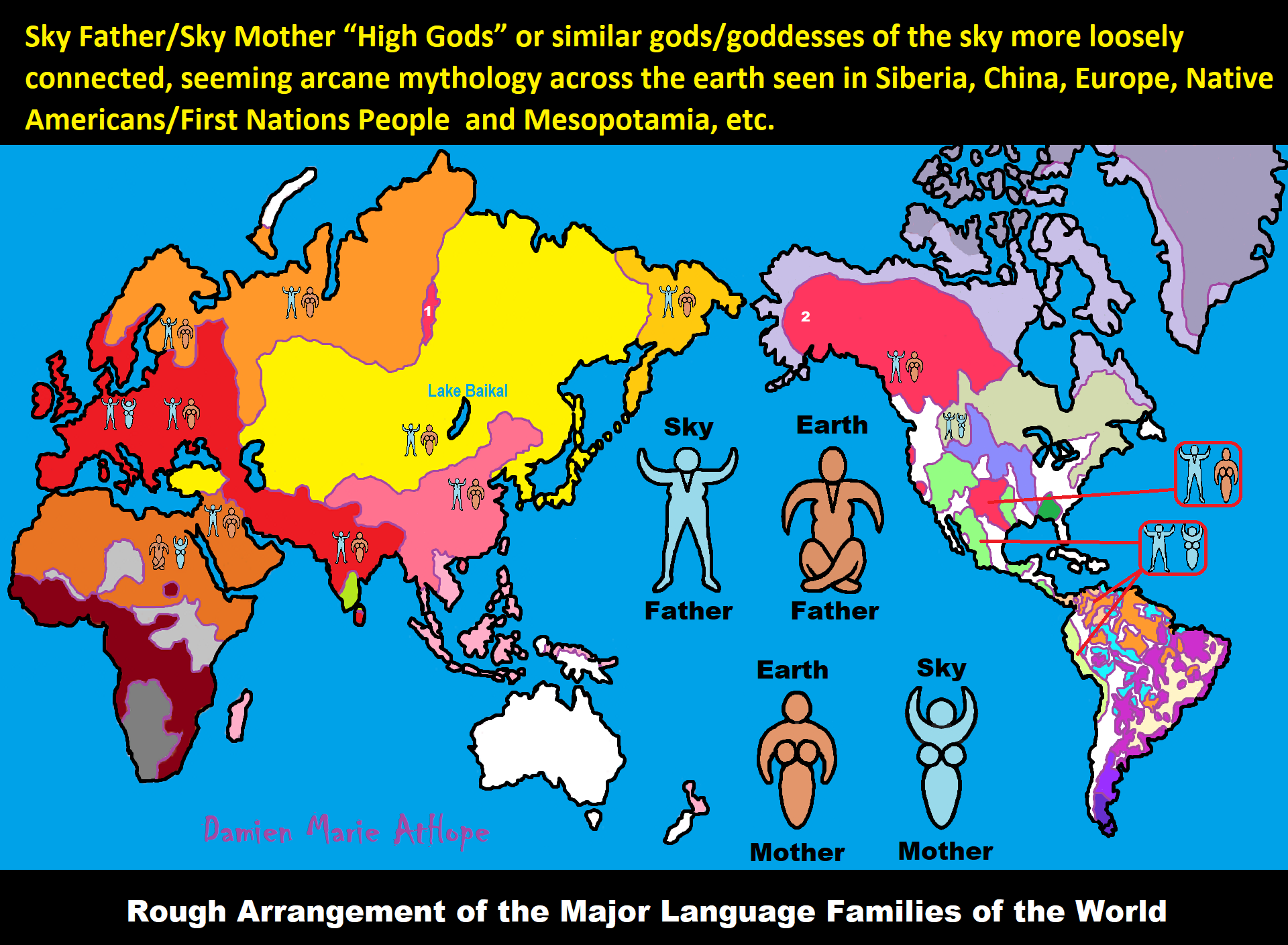
ref, ref, ref, ref, ref, ref, ref, ref, ref, ref, ref, ref, ref, ref, ref, ref, ref
“These ideas are my speculations from the evidence.”
I am still researching the “god‘s origins” all over the world. So you know, it is very complicated but I am smart and willing to look, DEEP, if necessary, which going very deep does seem to be needed here, when trying to actually understand the evolution of gods and goddesses. I am sure of a few things and less sure of others, but even in stuff I am not fully grasping I still am slowly figuring it out, to explain it to others. But as I research more I am understanding things a little better, though I am still working on understanding it all or something close and thus always figuring out more.
Sky Father/Sky God?
“Egyptian: (Nut) Sky Mother and (Geb) Earth Father” (Egypt is different but similar)
Turkic/Mongolic: (Tengri/Tenger Etseg) Sky Father and (Eje/Gazar Eej) Earth Mother *Transeurasian*
Hawaiian: (Wākea) Sky Father and (Papahānaumoku) Earth Mother *Austronesian*
New Zealand/ Māori: (Ranginui) Sky Father and (Papatūānuku) Earth Mother *Austronesian*
Proto-Indo-European: (Dyḗus/Dyḗus ph₂tḗr) Sky Father and (Dʰéǵʰōm/Pleth₂wih₁) Earth Mother
Indo-Aryan: (Dyaus Pita) Sky Father and (Prithvi Mata) Earth Mother *Indo-European*
Italic: (Jupiter) Sky Father and (Juno) Sky Mother *Indo-European*
Etruscan: (Tinia) Sky Father and (Uni) Sky Mother *Tyrsenian/Italy Pre–Indo-European*
Hellenic/Greek: (Zeus) Sky Father and (Hera) Sky Mother who started as an “Earth Goddess” *Indo-European*
Nordic: (Dagr) Sky Father and (Nótt) Sky Mother *Indo-European*
Slavic: (Perun) Sky Father and (Mokosh) Earth Mother *Indo-European*
Illyrian: (Deipaturos) Sky Father and (Messapic Damatura’s “earth-mother” maybe) Earth Mother *Indo-European*
Albanian: (Zojz) Sky Father and (?) *Indo-European*
Baltic: (Perkūnas) Sky Father and (Saulė) Sky Mother *Indo-European*
Germanic: (Týr) Sky Father and (?) *Indo-European*
Colombian-Muisca: (Bochica) Sky Father and (Huythaca) Sky Mother *Chibchan*
Aztec: (Quetzalcoatl) Sky Father and (Xochiquetzal) Sky Mother *Uto-Aztecan*
Incan: (Viracocha) Sky Father and (Mama Runtucaya) Sky Mother *Quechuan*
China: (Tian/Shangdi) Sky Father and (Dì) Earth Mother *Sino-Tibetan*
Sumerian, Assyrian and Babylonian: (An/Anu) Sky Father and (Ki) Earth Mother
Finnish: (Ukko) Sky Father and (Akka) Earth Mother *Finno-Ugric*
Sami: (Horagalles) Sky Father and (Ravdna) Earth Mother *Finno-Ugric*
Puebloan-Zuni: (Ápoyan Ta’chu) Sky Father and (Áwitelin Tsíta) Earth Mother
Puebloan-Hopi: (Tawa) Sky Father and (Kokyangwuti/Spider Woman/Grandmother) Earth Mother *Uto-Aztecan*
Puebloan-Navajo: (Tsohanoai) Sky Father and (Estsanatlehi) Earth Mother *Na-Dene*
ref, ref, ref, ref, ref, ref, ref, ref, ref, ref, ref, ref, ref, ref, ref, ref, ref, ref, ref, ref, ref, ref, ref, ref, ref, ref, ref
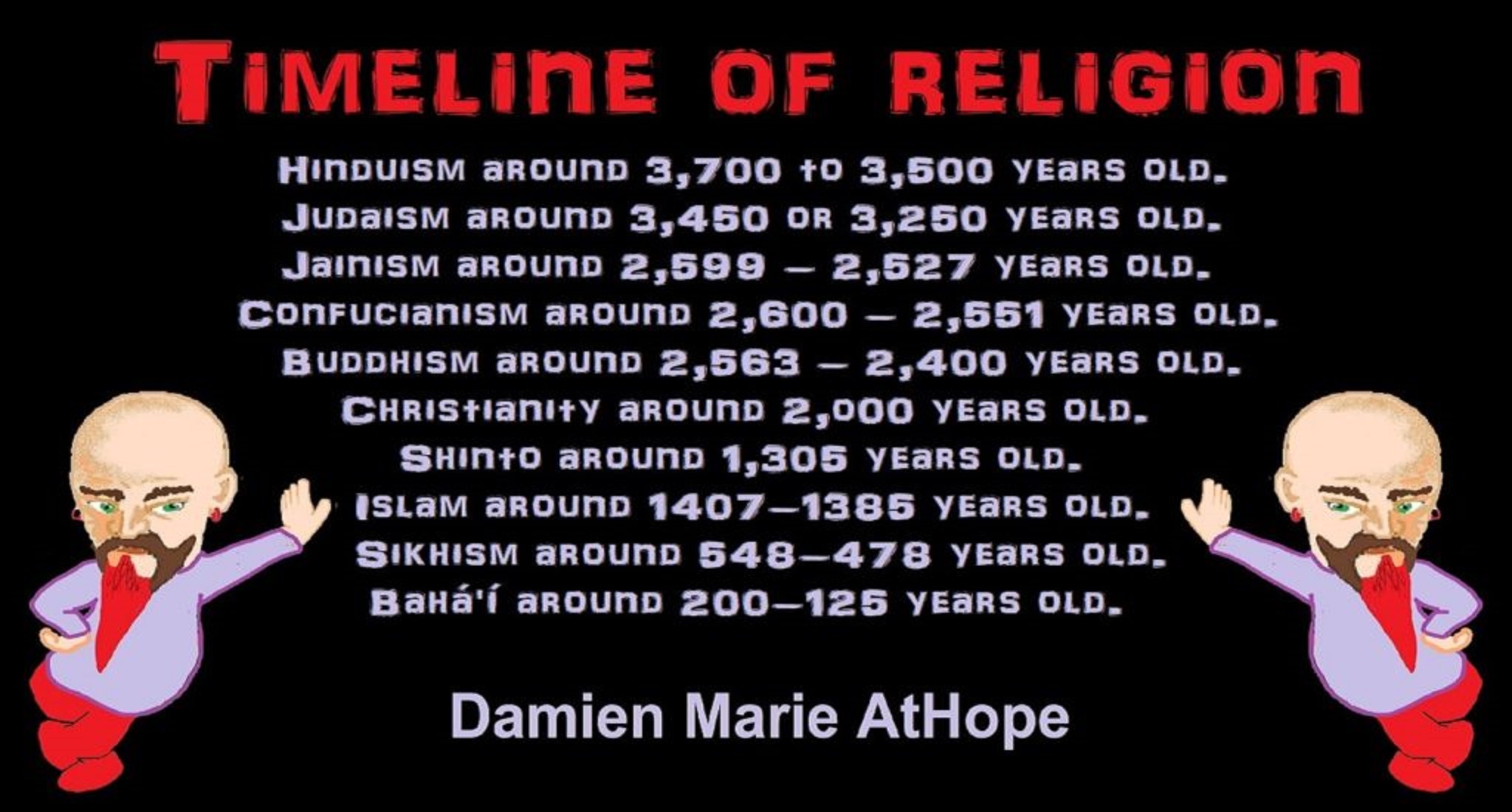
Hinduism around 3,700 to 3,500 years old. ref
Judaism around 3,450 or 3,250 years old. (The first writing in the bible was “Paleo-Hebrew” dated to around 3,000 years ago Khirbet Qeiyafa is the site of an ancient fortress city overlooking the Elah Valley. And many believe the religious Jewish texts were completed around 2,500) ref, ref
Judaism is around 3,450 or 3,250 years old. (“Paleo-Hebrew” 3,000 years ago and Torah 2,500 years ago)
“Judaism is an Abrahamic, its roots as an organized religion in the Middle East during the Bronze Age. Some scholars argue that modern Judaism evolved from Yahwism, the religion of ancient Israel and Judah, by the late 6th century BCE, and is thus considered to be one of the oldest monotheistic religions.” ref
“Yahwism is the name given by modern scholars to the religion of ancient Israel, essentially polytheistic, with a plethora of gods and goddesses. Heading the pantheon was Yahweh, the national god of the Israelite kingdoms of Israel and Judah, with his consort, the goddess Asherah; below them were second-tier gods and goddesses such as Baal, Shamash, Yarikh, Mot, and Astarte, all of whom had their own priests and prophets and numbered royalty among their devotees, and a third and fourth tier of minor divine beings, including the mal’ak, the messengers of the higher gods, who in later times became the angels of Judaism, Christianity and Islam. Yahweh, however, was not the ‘original’ god of Israel “Isra-El”; it is El, the head of the Canaanite pantheon, whose name forms the basis of the name “Israel”, and none of the Old Testament patriarchs, the tribes of Israel, the Judges, or the earliest monarchs, have a Yahwistic theophoric name (i.e., one incorporating the name of Yahweh).” ref
“El is a Northwest Semitic word meaning “god” or “deity“, or referring (as a proper name) to any one of multiple major ancient Near Eastern deities. A rarer form, ‘ila, represents the predicate form in Old Akkadian and in Amorite. The word is derived from the Proto-Semitic *ʔil-, meaning “god”. Specific deities known as ‘El or ‘Il include the supreme god of the ancient Canaanite religion and the supreme god of East Semitic speakers in Mesopotamia’s Early Dynastic Period. ʼĒl is listed at the head of many pantheons. In some Canaanite and Ugaritic sources, ʼĒl played a role as father of the gods, of creation, or both. For example, in the Ugaritic texts, ʾil mlk is understood to mean “ʼĒl the King” but ʾil hd as “the god Hadad“. The Semitic root ʾlh (Arabic ʾilāh, Aramaic ʾAlāh, ʾElāh, Hebrew ʾelōah) may be ʾl with a parasitic h, and ʾl may be an abbreviated form of ʾlh. In Ugaritic the plural form meaning “gods” is ʾilhm, equivalent to Hebrew ʾelōhîm “powers”. In the Hebrew texts this word is interpreted as being semantically singular for “god” by biblical commentators. However the documentary hypothesis for the Old Testament (corresponds to the Jewish Torah) developed originally in the 1870s, identifies these that different authors – the Jahwist, Elohist, Deuteronomist, and the Priestly source – were responsible for editing stories from a polytheistic religion into those of a monotheistic religion. Inconsistencies that arise between monotheism and polytheism in the texts are reflective of this hypothesis.” ref
Jainism around 2,599 – 2,527 years old. ref
Confucianism around 2,600 – 2,551 years old. ref
Buddhism around 2,563/2,480 – 2,483/2,400 years old. ref
Christianity around 2,o00 years old. ref
Shinto around 1,305 years old. ref
Islam around 1407–1385 years old. ref
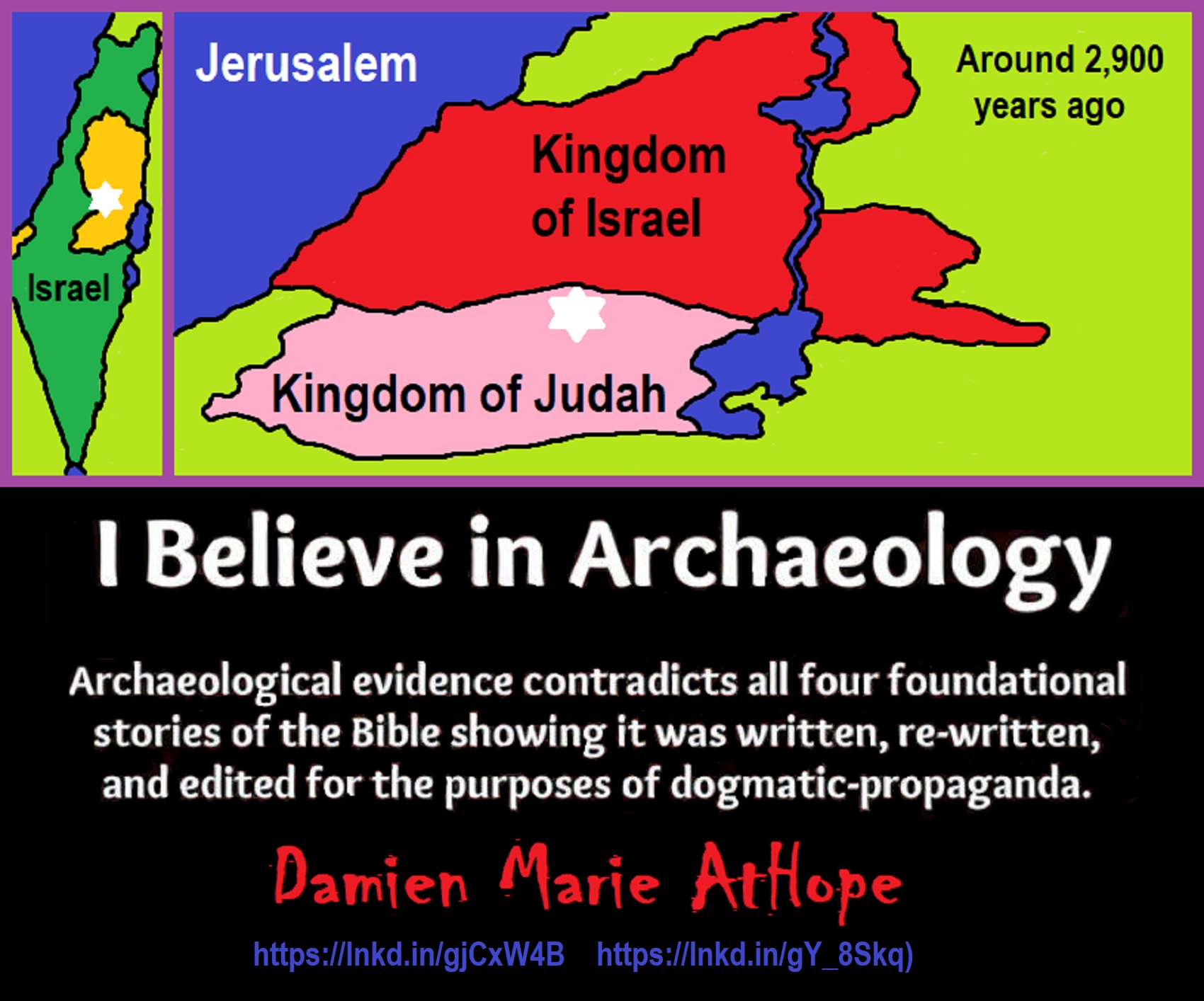
Knowledge to Ponder:
Stars/Astrology:
- Possibly, around 30,000 years ago (in simpler form) to 6,000 years ago, Stars/Astrology are connected to Ancestors, Spirit Animals, and Deities.
- The star also seems to be a possible proto-star for Star of Ishtar, Star of Inanna, or Star of Venus.
- Around 7,000 to 6,000 years ago, Star Constellations/Astrology have connections to the “Kurgan phenomenon” of below-ground “mound” stone/wood burial structures and “Dolmen phenomenon” of above-ground stone burial structures.
- Around 6,500–5,800 years ago, The Northern Levant migrations into Jordon and Israel in the Southern Levant brought new cultural and religious transfer from Turkey and Iran.
- “The Ghassulian Star,” a mysterious 6,000-year-old mural from Jordan may have connections to the European paganstic kurgan/dolmens phenomenon.
“Astrology is a range of divinatory practices, recognized as pseudoscientific since the 18th century, that claim to discern information about human affairs and terrestrial events by studying the apparent positions of celestial objects. Different cultures have employed forms of astrology since at least the 2nd millennium BCE, these practices having originated in calendrical systems used to predict seasonal shifts and to interpret celestial cycles as signs of divine communications. Most, if not all, cultures have attached importance to what they observed in the sky, and some—such as the Hindus, Chinese, and the Maya—developed elaborate systems for predicting terrestrial events from celestial observations. Western astrology, one of the oldest astrological systems still in use, can trace its roots to 19th–17th century BCE Mesopotamia, from where it spread to Ancient Greece, Rome, the Islamicate world and eventually Central and Western Europe. Contemporary Western astrology is often associated with systems of horoscopes that purport to explain aspects of a person’s personality and predict significant events in their lives based on the positions of celestial objects; the majority of professional astrologers rely on such systems.” ref
Around 5,500 years ago, Science evolves, The first evidence of science was 5,500 years ago and was demonstrated by a body of empirical, theoretical, and practical knowledge about the natural world. ref
Around 5,000 years ago, Origin of Logics is a Naturalistic Observation (principles of valid reasoning, inference, & demonstration) ref
Around 4,150 to 4,000 years ago: The earliest surviving versions of the Sumerian Epic of Gilgamesh, which was originally titled “He who Saw the Deep” (Sha naqba īmuru) or “Surpassing All Other Kings” (Shūtur eli sharrī) were written. ref
Hinduism:
- 3,700 years ago or so, the oldest of the Hindu Vedas (scriptures), the Rig Veda was composed.
- 3,500 years ago or so, the Vedic Age began in India after the collapse of the Indus Valley Civilization.
Judaism:
- around 3,000 years ago, the first writing in the bible was “Paleo-Hebrew”
- around 2,500 years ago, many believe the religious Jewish texts were completed
Myths: The bible inspired religion is not just one religion or one myth but a grouping of several religions and myths
- Around 3,450 or 3,250 years ago, according to legend, is the traditionally accepted period in which the Israelite lawgiver, Moses, provided the Ten Commandments.
- Around 2,500 to 2,400 years ago, a collection of ancient religious writings by the Israelites based primarily upon the Hebrew Bible, Tanakh, or Old Testament is the first part of Christianity’s bible.
- Around 2,400 years ago, the most accepted hypothesis is that the canon was formed in stages, first the Pentateuch (Torah).
- Around 2,140 to 2,116 years ago, the Prophets was written during the Hasmonean dynasty, and finally the remaining books.
- Christians traditionally divide the Old Testament into four sections:
- The first five books or Pentateuch (Torah).
- The proposed history books telling the history of the Israelites from their conquest of Canaan to their defeat and exile in Babylon.
- The poetic and proposed “Wisdom books” dealing, in various forms, with questions of good and evil in the world.
- The books of the biblical prophets, warning of the consequences of turning away from God:
- Henotheism:
- Exodus 20:23 “You shall not make other gods besides Me (not saying there are no other gods just not to worship them); gods of silver or gods of gold, you shall not make for yourselves.”
- Polytheism:
- Judges 10:6 “Then the sons of Israel again did evil in the sight of the LORD, served the Baals and the Ashtaroth, the gods of Aram, the gods of Sidon, the gods of Moab, the gods of the sons of Ammon, and the gods of the Philistines; thus they forsook the LORD and did not serve Him.”
- 1 Corinthians 8:5 “For even if there are so-called gods whether in heaven or on earth, as indeed there are many gods and many lords.”
- Monotheism:
- Isaiah 43:10 “You are my witnesses,” declares the LORD, “and my servant whom I have chosen, so that you may know and believe me and understand that I am he. Before me no god was formed, nor will there be one after me.
Around 2,570 to 2,270 Years Ago, there is a confirmation of atheistic doubting as well as atheistic thinking, mainly by Greek philosophers. However, doubting gods is likely as old as the invention of gods and should destroy the thinking that belief in god(s) is the “default belief”. The Greek word is apistos (a “not” and pistos “faithful,”), thus not faithful or faithless because one is unpersuaded and unconvinced by a god(s) claim. Short Definition: unbelieving, unbeliever, or unbelief.

Expressions of Atheistic Thinking:
- Around 2,600 years ago, Ajita Kesakambali, ancient Indian philosopher, who is the first known proponent of Indian materialism. ref
- Around 2,535 to 2,475 years ago, Heraclitus, Greek pre-Socratic philosopher, a native of the Greek city Ephesus, Ionia, on the coast of Anatolia, also known as Asia Minor or modern Turkey. ref
- Around 2,500 to 2,400 years ago, according to The Story of Civilization book series certain African pygmy tribes have no identifiable gods, spirits, or religious beliefs or rituals, and even what burials accrue are without ceremony. ref
- Around 2,490 to 2,430 years ago, Empedocles, Greek pre-Socratic philosopher and a citizen of Agrigentum, a Greek city in Sicily. ref
- Around 2,460 to 2,370 years ago, Democritus, Greek pre-Socratic philosopher considered to be the “father of modern science” possibly had some disbelief amounting to atheism. ref
- Around 2,399 years ago or so, Socrates, a famous Greek philosopher was tried for sinfulness by teaching doubt of state gods. ref
- Around 2,341 to 2,270 years ago, Epicurus, a Greek philosopher known for composing atheistic critics and famously stated, “Is God willing to prevent evil, but not able? Then he is not omnipotent. Is he able, but not willing? Then he is malevolent. Is he both able and willing? Then whence cometh evil? Is he neither able nor willing? Then why call him god?” ref
This last expression by Epicurus, seems to be an expression of Axiological Atheism. To understand and utilize value or actually possess “Value Conscious/Consciousness” to both give a strong moral “axiological” argument (the problem of evil) as well as use it to fortify humanism and positive ethical persuasion of human helping and care responsibilities. Because value-blindness gives rise to sociopathic/psychopathic evil.
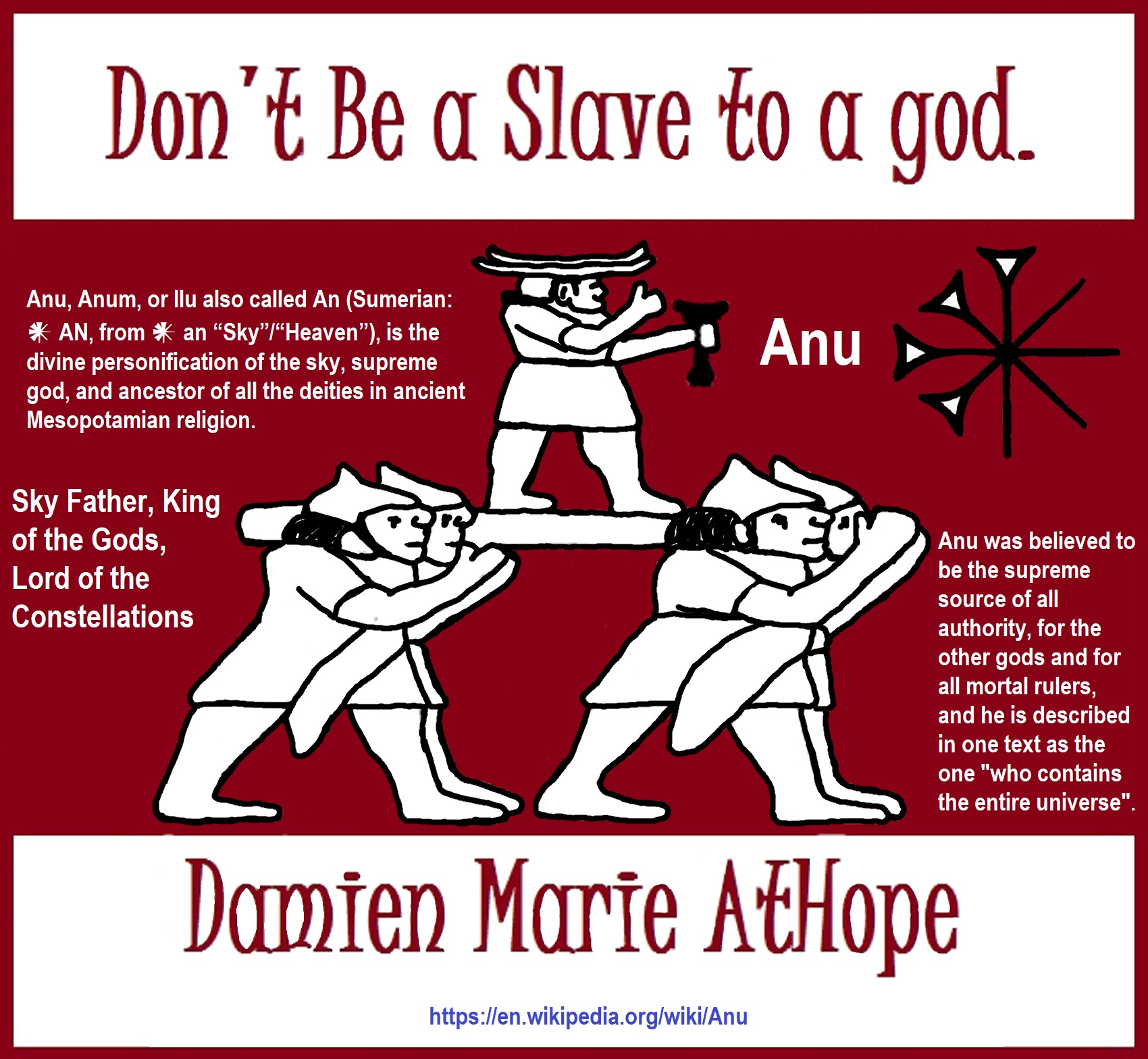
“Theists, there has to be a god, as something can not come from nothing.”
Well, thus something (unknown) happened and then there was something. This does not tell us what the something that may have been involved with something coming from nothing. A supposed first cause, thus something (unknown) happened and then there was something is not an open invitation to claim it as known, neither is it justified to call or label such an unknown as anything, especially an unsubstantiated magical thinking belief born of mythology and religious storytelling.
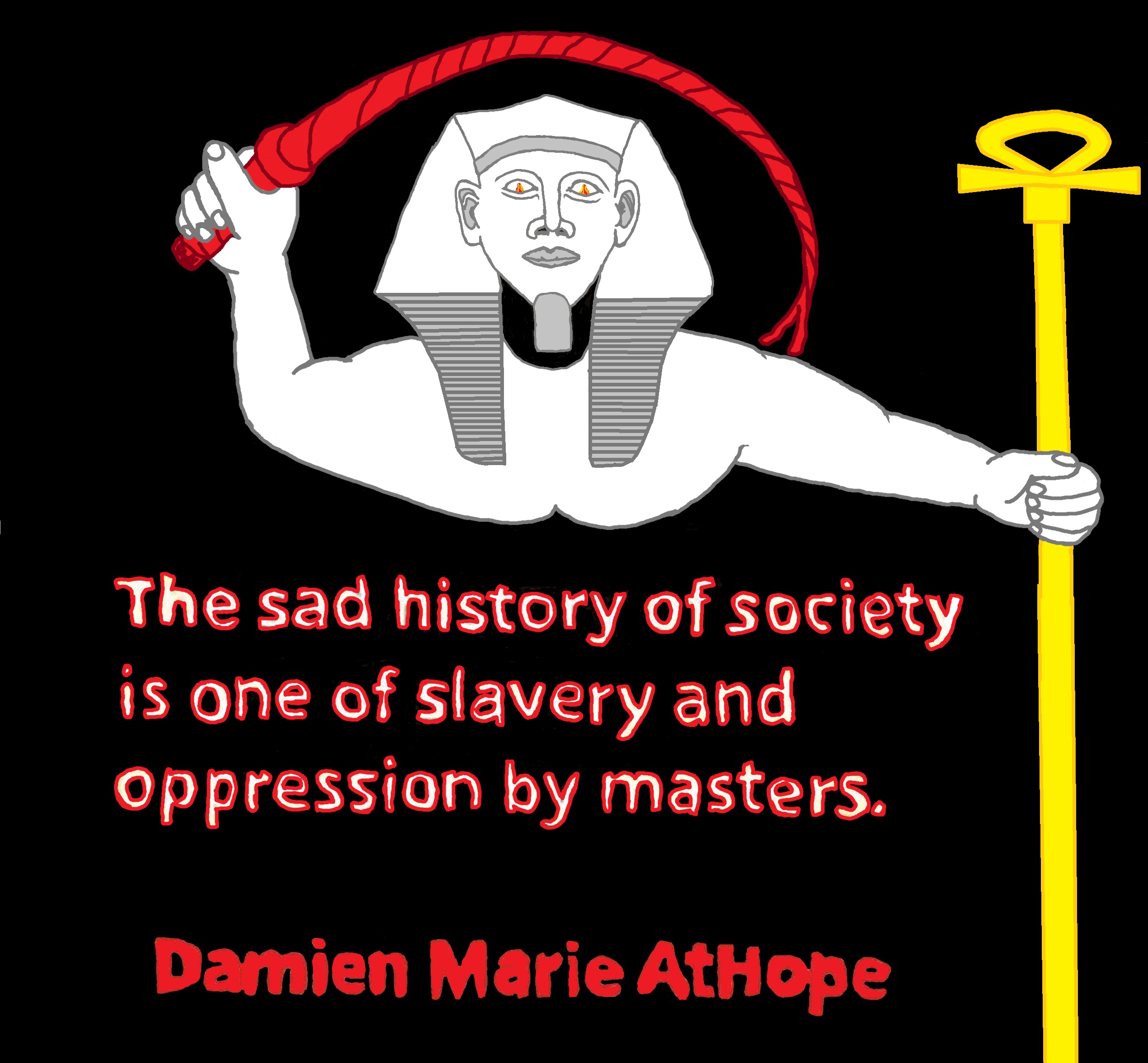

While hallucinogens are associated with shamanism, it is alcohol that is associated with paganism.
The Atheist-Humanist-Leftist Revolutionaries Shows in the prehistory series:
Show two: Pre-animism 300,000 years old and animism 100,000 years old: related to “Anarchism and Socialism”
Show tree: Totemism 50,000 years old: related to “Anarchism and Socialism”
Show four: Shamanism 30,000 years old: related to “Anarchism and Socialism”
Show five: Paganism 12,000 years old: related to “Anarchism and Socialism”
Show six: Emergence of hierarchy, sexism, slavery, and the new male god dominance: Paganism 7,000-5,000 years old: related to “Anarchism and Socialism” (Capitalism) (World War 0) Elite and their slaves!
Prehistory: related to “Anarchism and Socialism” the division of labor, power, rights, and recourses: VIDEO
Pre-animism 300,000 years old and animism 100,000 years old: related to “Anarchism and Socialism”: VIDEO
Totemism 50,000 years old: related to “Anarchism and Socialism”: VIDEO
Shamanism 30,000 years old: related to “Anarchism and Socialism”: VIDEO
Paganism 12,000 years old: related to “Anarchism and Socialism” (Pre-Capitalism): VIDEO
Paganism 7,000-5,000 years old: related to “Anarchism and Socialism” (Capitalism) (World War 0) Elite and their slaves: VIEDO
Paganism 5,000 years old: progressed organized religion and the state: related to “Anarchism and Socialism” (Kings and the Rise of the State): VIEDO
Paganism 4,000 years old: related to “Anarchism and Socialism” (First Moralistic gods, then the Origin time of Monotheism): VIEDO
I do not hate simply because I challenge and expose myths or lies any more than others being thought of as loving simply because of the protection and hiding from challenge their favored myths or lies.
The truth is best championed in the sunlight of challenge.
An archaeologist once said to me “Damien religion and culture are very different”
My response, So are you saying that was always that way, such as would you say Native Americans’ cultures are separate from their religions? And do you think it always was the way you believe?
I had said that religion was a cultural product. That is still how I see it and there are other archaeologists that think close to me as well. Gods too are the myths of cultures that did not understand science or the world around them, seeing magic/supernatural everywhere.
I personally think there is a goddess and not enough evidence to support a male god at Çatalhöyük but if there was both a male and female god and goddess then I know the kind of gods they were like Proto-Indo-European mythology.
This series idea was addressed in, Anarchist Teaching as Free Public Education or Free Education in the Public: VIDEO
Our 12 video series: Organized Oppression: Mesopotamian State Force and the Politics of power (9,000-4,000 years ago), is adapted from: The Complete and Concise History of the Sumerians and Early Bronze Age Mesopotamia (7000-2000 BC): https://www.youtube.com/watch?v=szFjxmY7jQA by “History with Cy“
Show #1: Mesopotamian State Force and the Politics of Power (Samarra, Halaf, Ubaid)
Show #2: Mesopotamian State Force and the Politics of Power (Eridu “Tell Abu Shahrain”)
Show #3: Mesopotamian State Force and the Politics of Power (Uruk and the First Cities)
Show #4: Mesopotamian State Force and the Politics of Power (First Kings)
Show #5: Mesopotamian State Force and the Politics of Power (Early Dynastic Period)
Show #6: Mesopotamian State Force and the Politics of Power (King/Ruler Lugalzagesi)
Show #7: Mesopotamian State Force and the Politics of Power (Sargon and Akkadian Rule)
Show #9: Mesopotamian State Force and the Politics of Power (Gudea of Lagash and Utu-hegal)
Show #12: Mesopotamian State Force and the Politics of Power (Aftermath and Legacy of Sumer)
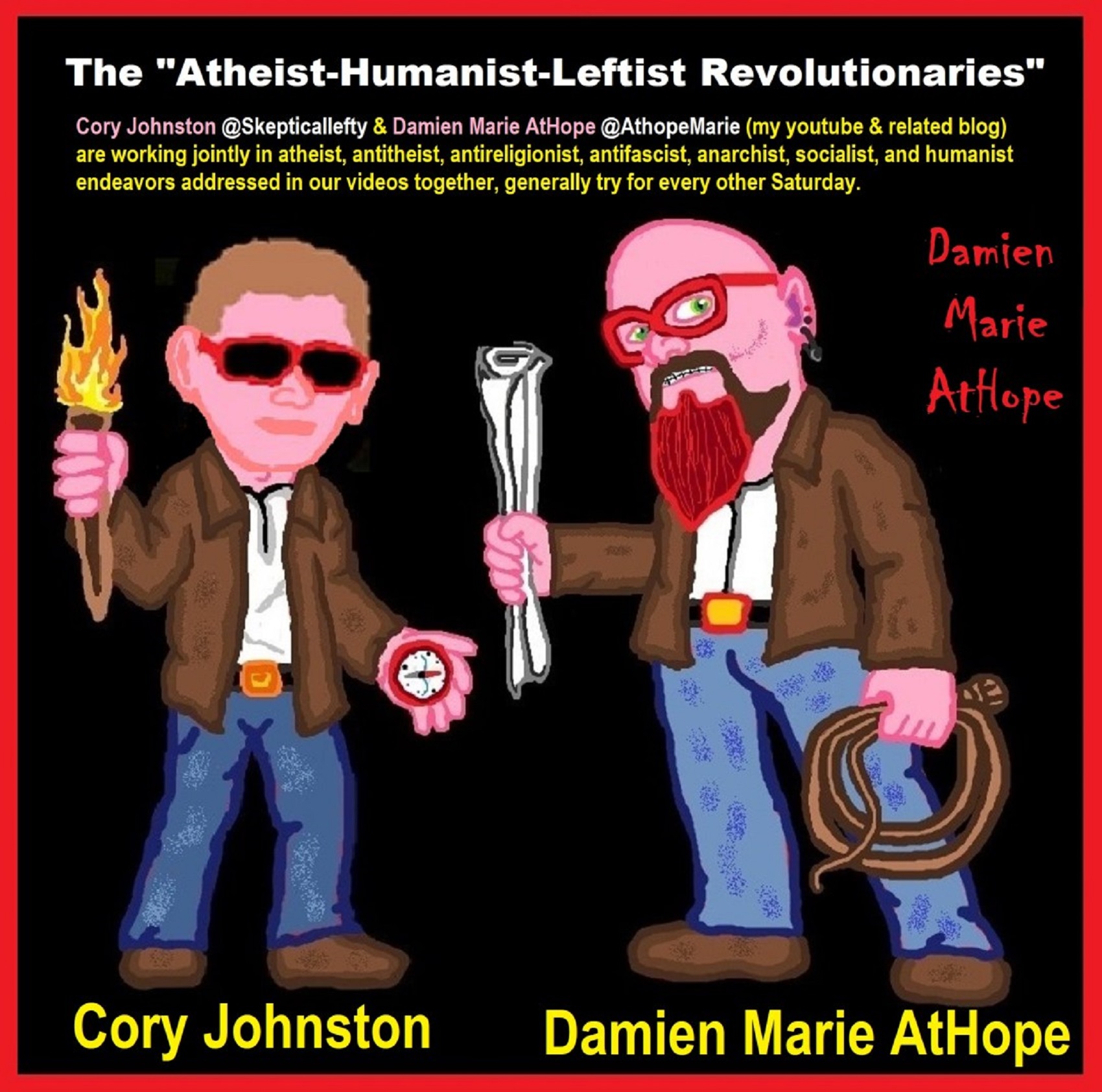
The “Atheist-Humanist-Leftist Revolutionaries”
Cory Johnston ☭ Ⓐ Atheist Leftist @Skepticallefty & I (Damien Marie AtHope) @AthopeMarie (my YouTube & related blog) are working jointly in atheist, antitheist, antireligionist, antifascist, anarchist, socialist, and humanist endeavors in our videos together, generally, every other Saturday.
Why Does Power Bring Responsibility?
Think, how often is it the powerless that start wars, oppress others, or commit genocide? So, I guess the question is to us all, to ask, how can power not carry responsibility in a humanity concept? I know I see the deep ethical responsibility that if there is power their must be a humanistic responsibility of ethical and empathic stewardship of that power. Will I be brave enough to be kind? Will I possess enough courage to be compassionate? Will my valor reach its height of empathy? I as everyone, earns our justified respect by our actions, that are good, ethical, just, protecting, and kind. Do I have enough self-respect to put my love for humanity’s flushing, over being brought down by some of its bad actors? May we all be the ones doing good actions in the world, to help human flourishing.
I create the world I want to live in, striving for flourishing. Which is not a place but a positive potential involvement and promotion; a life of humanist goal precision. To master oneself, also means mastering positive prosocial behaviors needed for human flourishing. I may have lost a god myth as an atheist, but I am happy to tell you, my friend, it is exactly because of that, leaving the mental terrorizer, god belief, that I truly regained my connected ethical as well as kind humanity.
Cory and I will talk about prehistory and theism, addressing the relevance to atheism, anarchism, and socialism.
At the same time as the rise of the male god, 7,000 years ago, there was also the very time there was the rise of violence, war, and clans to kingdoms, then empires, then states. It is all connected back to 7,000 years ago, and it moved across the world.
Cory Johnston: https://damienmarieathope.com/2021/04/cory-johnston-mind-of-a-skeptical-leftist/?v=32aec8db952d
The Mind of a Skeptical Leftist (YouTube)
Cory Johnston: Mind of a Skeptical Leftist @Skepticallefty
The Mind of a Skeptical Leftist By Cory Johnston: “Promoting critical thinking, social justice, and left-wing politics by covering current events and talking to a variety of people. Cory Johnston has been thoughtfully talking to people and attempting to promote critical thinking, social justice, and left-wing politics.” http://anchor.fm/skepticalleft
Cory needs our support. We rise by helping each other.
Cory Johnston ☭ Ⓐ @Skepticallefty Evidence-based atheist leftist (he/him) Producer, host, and co-host of 4 podcasts @skeptarchy @skpoliticspod and @AthopeMarie
Damien Marie AtHope (“At Hope”) Axiological Atheist, Anti-theist, Anti-religionist, Secular Humanist. Rationalist, Writer, Artist, Poet, Philosopher, Advocate, Activist, Psychology, and Armchair Archaeology/Anthropology/Historian.
Damien is interested in: Freedom, Liberty, Justice, Equality, Ethics, Humanism, Science, Atheism, Antiteism, Antireligionism, Ignosticism, Left-Libertarianism, Anarchism, Socialism, Mutualism, Axiology, Metaphysics, LGBTQI, Philosophy, Advocacy, Activism, Mental Health, Psychology, Archaeology, Social Work, Sexual Rights, Marriage Rights, Woman’s Rights, Gender Rights, Child Rights, Secular Rights, Race Equality, Ageism/Disability Equality, Etc. And a far-leftist, “Anarcho-Humanist.”
I am not a good fit in the atheist movement that is mostly pro-capitalist, I am anti-capitalist. Mostly pro-skeptic, I am a rationalist not valuing skepticism. Mostly pro-agnostic, I am anti-agnostic. Mostly limited to anti-Abrahamic religions, I am an anti-religionist.
To me, the “male god” seems to have either emerged or become prominent around 7,000 years ago, whereas the now favored monotheism “male god” is more like 4,000 years ago or so. To me, the “female goddess” seems to have either emerged or become prominent around 11,000-10,000 years ago or so, losing the majority of its once prominence around 2,000 years ago due largely to the now favored monotheism “male god” that grow in prominence after 4,000 years ago or so.
My Thought on the Evolution of Gods?
Animal protector deities from old totems/spirit animal beliefs come first to me, 13,000/12,000 years ago, then women as deities 11,000/10,000 years ago, then male gods around 7,000/8,000 years ago. Moralistic gods around 5,000/4,000 years ago, and monotheistic gods around 4,000/3,000 years ago.
To me, animal gods were likely first related to totemism animals around 13,000 to 12,000 years ago or older. Female as goddesses was next to me, 11,000 to 10,000 years ago or so with the emergence of agriculture. Then male gods come about 8,000 to 7,000 years ago with clan wars. Many monotheism-themed religions started in henotheism, emerging out of polytheism/paganism.

Damien Marie AtHope (Said as “At” “Hope”)/(Autodidact Polymath but not good at math):
Axiological Atheist, Anti-theist, Anti-religionist, Secular Humanist, Rationalist, Writer, Artist, Jeweler, Poet, “autodidact” Philosopher, schooled in Psychology, and “autodidact” Armchair Archaeology/Anthropology/Pre-Historian (Knowledgeable in the range of: 1 million to 5,000/4,000 years ago). I am an anarchist socialist politically. Reasons for or Types of Atheism
My Website, My Blog, & Short-writing or Quotes, My YouTube, Twitter: @AthopeMarie, and My Email: damien.marie.athope@gmail.com

